#the fact twice has never done a feature on a title track like this before and of course the first person is Megan
Explore tagged Tumblr posts
Text
TWICE TITLE TRACK FEATURING MEGAN THEE STALLION???

i’ve prayed for times like these
#the fact twice has never done a feature on a title track like this before and of course the first person is Megan#like god is real
4 notes
·
View notes
Link
10 THINGS YOU PROBABLY DIDN’T KNOW ABOUT MY CHEMICAL ROMANCE’S ‘DANGER DAYS’
The future is bulletproof, but how’s your ‘Danger Days’ knowledge?
By Ali Cooper-November 20, 2020
It’s been an entire decade since the Killjoys first made some noise on 2010’s Danger Days: The True Lives Of The Fabulous Killjoys. The aftermath is secondary, ultimately legendary and a timely reminder that My Chemical Romance can turn their hands to any far-fetched concept and produce a timeless, genre-defining album in the process.
For every year we’ve run away with Party Poison and co., fighting off Better Living Industries, we’ve uncovered one lesser-known fact about this neon My Chem era—and the final full album from the New Jersey boys—in hopes that it may not be their last record for much longer.
Read more:
Frank Iero teased the new Future Violents EP for longer than you realize
My Chem didn’t intend for “Look Alive, Sunshine” to make sense
The immortal words of Dr. Death Defying’s introduction to the Danger Days era were a roll call to the post-apocalyptic world where the Killjoys reside. And they’re perplexing, to say the least. What does “Louder than God’s revolver and twice as shiny” even mean, anyway? The good news is MCR didn’t intend for us to understand it in the first place. Gerard Way confirmed to Billboard that the language play in this opening track mirrors that of the novel-to-film classic A Clockwork Orange. Teenage gang members in Anthony Burgess’ novel use a nonsense language called Nadsat. It’s just loose enough for readers to understand its base meaning but not how it reaches the point. So that explains why this introductory narration has kept us scratching our heads for years.
The Black Parade is dead
Blink and you’ll miss the sneaky reference to My Chem’s previous album, The Black Parade. A skeleton half-submerged in the desert sands wears a dusty Parade-era jacket in the chaos of the “Na Na Na” video. But this glimpse of their past isn’t just a visual depiction of “The Black Parade is dead” sentiment. What we’re actually seeing is the burial of the memory of drummer Bob Bryar. He left the lineup during the writing of Danger Days, but they don’t brush over the loss of a key member in their rise to success. Instead, the passing nod recognizes and celebrates Bryar’s role and lasting effect on MCR’s past, present and future.
MCR meets The Sims
We’ve heard the rapid-fire anthem “Na Na Na” in many shapes and forms over the last decade. But there’s one alternate version we never expected. My Chem re-recorded the song in the fictional Simlish language for the video game The Sims 3: Late Night. If you’ve ever wondered what the classic track would sound like if you couldn’t understand English, look no further. We wouldn’t recommend listening to this gibberish version while drunk. Still, it’s definitely an unusual addition to the legacy of a song that broke the mainstream.
“Bulletproof Heart” provided the concept
After exhausting themselves through the process for The Black Parade, My Chem swore their next effort wouldn’t feature a concept. They planned to return to their raw talents as songwriters without novelty costumes or fleeting gimmicks. However, that all changed when the band wrote “Bulletproof Heart,” which handed them their next grand concept: futuristic runaways. And it sounded like a distant echo from the existential Black Parade days morphing into the laser-beam Killjoys era. Gerard confirmed to Billboard that this epic track showed MCR how to use their experience in high concepts to the best effect for their fourth record.
“SING” rebooted Danger Days
One of the defining anthems from Danger Days, Gerard confirmed to Billboard that the writing process that culminated with “SING” was the catalyst for the band’s decision to scrap their progress on the fourth album and start all over again. It was a defiant track devoted to standing up and being heard. And it brought life to the new incarnation of My Chem was given the rousing cover treatment on Glee. Plus, the band recorded a version entitled “#SINGItforJapan” to raise funds for the Red Cross relief efforts after the 2011 Japan earthquake.
California 2019
The band proved fans right about their theory of MCR’s return in 2019, the same year the Danger Days universe is set in. But they also paid tribute to something other than their own forward-thinking genius by placing the Killjoys in an alternate dystopian universe nine years in the future. The setting was inspired by one other bleak, post-apocalyptic vision of California in the year 2019: Blade Runner. It turns out we have Harrison Ford’s 1982 sci-fi classic to thank for MCR’s futuristic interpretation that involved the entire band dying in the field of combat with robots.
“Party Poison” is a love song to rock and metal
The anti-party party anthem “Party Poison” brought the unbridled energy to the Danger Days era. And it included a plethora of rock and metal influences. Originally titled “Death Before Disco,” the midpoint of the album not pays tribute to both Ray Toro’s inspirations from the vibrant MC5 and Gerard’s favorite Judas Priest song, “Living After Midnight.” Gerard also mentioned the outstanding influence of Bruce Springsteen on Danger Days. He explained to Rolling Stone that writing “Party Poison” was like discovering their own show-stopping alternative to “Born To Run.”
Kobra Kid’s helmet
While fighting off Draculoids and Exterminators, the Killjoys needed all the luck they could get. Kobra Kid was of course there to help with his iconic helmet sporting the words “good luck.“ This design feature was a sneaky nod to the space-based Nintendo video game Star Fox, where a screen appears and a voice says “good luck” before every mission. With this 1993 callback, Mikey Way’s Danger Days alter ego kept a classic sci-fi shooter reference close to his heart. Of course, the positive message didn’t save his character from death, but it’s the thought that counts.
The origins of “DESTROYA”
Gerard once described “DESTROYA” as “the hardest song the band have ever done.” And he later revealed to Billboard that the Hindu Holi festival inspired its lyrics. Known as the “festival of colors” and a positive social event for friends and family to repair broken relationships and strengthen connections, this traditional event in the Indian calendar encapsulates all the neon fun-loving vibrance of Danger Days. According to Billboard, every member of the band took to the drums for the recording of “DESTROYA.” Their goal: To bring out the vivacity and togetherness of one of the most upbeat songs on the record.
Gerard hinted at their return during
Danger Days
Eagle-eyed MCR fans leave no stone unturned when it comes to speculating the now-factual return of the emo icons. The MCRmy uncovered a hint of the band’s foreshadowed return by way of an olive green jacket Gerard wore during promotion for their fourth album, suggesting that a sigil patch that appeared on his shoulder spells out My Chemical Romance. We saw Gerard sporting this jacket on numerous occasions before the band’s hiatus. And in hindsight, he also wore this jacket for their reunion show in Los Angeles in 2019. Was the singer always hinting what to expect when My Chem eventually returned?
© Copyright 2019 Alternative Press, Inc.
#there are pics and vids there but I am lazy and was more interested in the text#mcr#my chemical romance#danger days era#killjoys#alternative press
560 notes
·
View notes
Text
Fic Writer Meme
Name
Fandoms
Most popular oneshot
Most popular multichapter
Actual worst part of writing
How you choose your titles
Do you outline
Ideas I probably won’t get around to, but wouldn’t it be nice?
Callouts @ Me
Best writing traits
Spicy Tangential Opinion
Name: Jordie is what everyone calls me and my username on Tumblr and AO3 is Lostinfantasies38, so I’m easy to track down
Fandoms: Over the years there have been many fandoms I’ve held dear, but my recent work is in Dragon Age and Dear Evan Hansen. I have temporarily left DA for some fresh air in DEH and have been doing very well there.
Most Popular Oneshot: I actually have a tie for this one and surprisingly, they are from separate fandoms.
Permanent Ink from DA: Origins, featuring Alistair and my male Warden OC Zane Cousland is quite spicy and tender. If you like pining bi-Alistair and schmexy love interests, this one is for you.
For You I Could Be was my very first DEH fic and it’s taken the fandom by storm, which still shocks the pants off me. It’s a deviation from canon and focuses on Evan and Connor realizing they have feelings for each other. Read the tags though since triggering content is mentioned.
Most Popular Multichapter: I’m sure you’re all tired of hearing about Sun Touched and Find Me Well Within Your Grace, but they are tied yet again. Sun Touched is my Dwarven Warden novelization of DA: Origins with Sirra Brosca and Alistair. Find Me Well is a head-canon fueled prequel of DA featuring young Cullistair at the abbey.
I won’t bore you all with the details, but I am very proud of both fics. I hope to come back and finish them once I’m the right head-space to devote the time to them that they deserve.
Actual Worst Part of Writing: The plot and staying on target. I tend to get side tracked by character development at times and that can derail an entire story if I’m not careful. I’m also incredibly careful to not lose a character’s voice while trying to flesh out a whole new side of them in my work. It’s a delicate balance. I want to do them justice, so while playing with them in AUs is fun, I still want them to sound like “them” and not caricatures.
How You Choose Your Titles: Through blood, sweat, and typically numerous tears and hair pulling sessions. I like my titles to reflect the story, but not sound too fucking cheesy, and sometimes that feels like an impossible task. I try to avoid using song lyrics personally, but I have done it once or twice in a pinch, I won’t lie.
Do you outline: FUCK NO. I have tried and I can’t stick to them. I’m also the type that once I write it out, even in an outline, I lose interest in that particular piece. I need the scenes to be fresh and literally banging on the door of my brain so they flow properly. Everything is fixed/cleaned up in editing, but if the emotion is missing in the initial draft it takes a monumental effort later to keep it from ringing hollow. Sometimes the drafts can’t be saved, period, after outlining and I’ve scraped entire stories/chapters because of it.
Ideas I probably won’t get around to, but wouldn’t it be nice: I have an entire folder of shelved DA stories in the wings that I’m not sure will ever see the light of day now. I’m hesitant to say “never,” but truthfully the more time passes the more likely that word becomes.
They include: (1) a modern carta/cop AU ft. Sirra/Alistair, (2) part 2 and 3 planned continuations of Find Me Well following Alistair and Cullen through DAI, (3) Varric/Charise Trevelyan DAI story full of intrigue and the House of Repose, (4) world weary veteran Grey Warden Alistair/Rylie Trevelyan DAI, chock full of dashing heroics and a swooning damsel in distress, (5) Cullen/Eryka Cadash DAI with lots of tension/angst due to the Carta & Commander angle causing friction [interpret that how you will, lol!] (6) a modern color soulmate AU with a unique twist ft. Cullen/Alistair (7) a Siren!AU ft. Sirra/Alistair and a cutthroat island of traitorous bitches (8) and finishing my incomplete DA stories. As a bonus, (9) there is a football AU for DEH that I started during NaNo, but it may end up in the scrap pile, too. I’m still picking at it, but meh, we’ll see.
Callouts at Me: Guilt.
Honestly, I know we do this for free and we have no obligation to write/complete these stories, but we all do it because we love it. Yet with each incomplete story, coupled with my rather abrupt departure from the DA fandom, my guilt has grown exponentially.
However, I can’t allow it to hold me back and continue to eat away at my soul. It keeps me from being productive and having a hope and a prayer of finishing what I started. If this means that I play in a new fandom for a while, then so be it. I wish I had more familiar faces to follow me there, but I understand it’s not for everyone and I would never make demands. Though, that doesn’t mean I don’t miss my usual readers and the comments I looked forward to, but I have relocated and I have to accept that. Just know that I still love you all and miss the fuck out of you.
Best Writing Traits: Emotionally evocative prose and creating realistically flawed characters are what I’m best at. My characters are not perfect, because who the fuck can relate to perfection? Who would want to? They are flawed, broken, dealing with a shit ton of trauma as best as they can, and generally bumbling through life. Yes, they may have a LI, but they are not “cured” by love. They are supported by an equally flawed person as they continue to stumble through life, though with fewer face plants than before because they have someone to (hopefully) catch them whenever they aren’t overwhelmed with their own crises. And making all the pain and growth as lyrical as possible is my favorite part.
Sometimes I nail dialogue, too, but more often than not that’s simply luck after hours of talking to myself and laughing/crying so hard I had to include it in a fic.
Spicy Tangential Opinion: Every single kudo, like, reblog, or comment is special. I know it’s easy to focus on the “quantity” of them - but each one represents a real person that one of my stories has emotionally resonated with. Every day we write and post we’re affecting real people behind our stats, which means we can treasure every single one. Talking about the numbers and engagement erases that fact, and I wish more people treasured every individual interaction for the meaningful gesture about their work it is. Each one is a little spark of ‘you are loved’ in the world. {Keeping this Manka because you summed it up beautifully! Bravo!}
Throwing this out into the world! Tag list below (authors only this time, sorry my lovely artist friends) but feel no obligation to do so! Also sorry if you already got tagged!
@kittimau @jennserr @jellysharkbat @fandomn00blr @bigfan-fanfic @blarfkey@darlingrutherford @herald-divine-hell @cassandra-pentughasst @c-e-c-r-o-p-i-a @river-of-asgard @giraffesanddietpepsi @pikapeppa @simper-fi
#fic tag meme#dragon age#dear evan hansen#long post#cullistair#sirrastair#treebros#evan x connor#alistair x brosca#zanistair#alistair x cousland#alistair x inquisitor#varric x charise#culladash#deh
28 notes
·
View notes
Video
youtube
Randy Lawrence, The Real Estate Preacher, Joins Jay Conner LIVE!
https://www.jayconner.com/randy-lawrence-the-real-estate-preacher-joins-jay-conner-live/
Jay Conner is joined by The Real Estate Preacher, Randy Lawrence.
“I’ve seen and done it all in real estate. Now I want to help you achieve the success I’ve enjoyed.” – Randy Lawrence
Prosperity Capital Partners lives its mission of serving others by providing Investors with financial freedom: Double-digit returns with zero capital loss and excellent tax benefits to our private investors for 17 years via asset-backed real estate investments.
Families with high-quality, affordable homes: Offering updated affordable housing enhancing the quality of life of working American families who live in our apartments.
https://pcpre.net/ https://therealestatepreacher.com/
Real Estate Cashflow Conference:
https://www.jayconner.com/learnrealestate/
Free Webinar:
http://bit.ly/jaymoneypodcast
Jay Conner is a proven real estate investment leader. Without using his own money or credit, Jay maximizes creative methods to buy and sell properties with profits averaging $64,000 per deal.
#RealEstate #PrivateMoney #FlipYourHouse
————————————————————
Jay Conner (00:02):
Well, hello and welcome to another episode of Real Estate Investing with Jay Conner! I’m Jay Conner, the Private Money Authority, also the host of the show. And I wanna welcome you whether you’re a brand new or you’ve been following the show for some time. My lands! We’ve launched back in June, 2018, tracking fast over 300,000 downloads. Thanks to you. And I do need your help. If you find this episode to be valuable, and you can use this information in your real estate investing business, then please help me out. Let’s share this information, like share, subscribe, write, and review whether you are on iTunes or watching on YouTube or any of our other platforms. Well, here on the show, we talk all things that relate to real estate investing. We talk about how to find deals. We talk about how to fund the deals without relying on local banks, mortgage companies, or even hard money lenders.
Jay Conner (01:11):
We talk about how to sell houses, rehab houses, and how to automate your business to where you’re actually running it. And it’s not running you. But as I mentioned, I’m known as the private money authority. I became an expert on raising private money and I’m not talking about doing business with brokers. I’m talking about actually attracting hundreds of thousands and in the millions of dollars in funding, that’s got nothing to do with your credit, your verification of income, or actually even the number of deals that you’ve done. If you’re interested in getting more funding for your deals to where you never miss out on a deal because you didn’t have the money, I’ve got a free gift for you. Yes, I have got a new monthly membership that I launched that I’m going to show you how to get free access to the membership. It’s called The Private Money Academy, and on the, or in the membership twice a month, I am live on Zoom with coaching for all of the Academy members.
Jay Conner (02:11):
We’re tracking fast to a thousand members. Right now, we got about 150 members. And as a matter of fact, the next live Zoom coaching call is within the next week. So I’m going to tell you how to get in, you get the live coaching. We also put someone, one of the members in the hot seat where we analyze your business, figure out your challenges and fix your challenges to where you’re able to take your business to the next level. And we also have new content and training in the membership every month on finding, flipping, automating funding, selling, et cetera. We also cover all in the membership, all types of real estate deals. We cover single family houses, commercial land, self storage, and you name it. We got it covered. So here’s how you can take advantage of checking it out for free. Go to www.jayconner.com/trial.
Jay Conner (03:10):
Again, that’s JayConner.com/Trial. Look forward to having you live on the membership Zoom conference calls. Well now in addition to that, if you’ve been tuning in for any time, you know that here at Real Estate Investing with Jay Conner, I have amazing experts. And in fact, the guests that I have on today’s show is a good friend of mine and is a fellow member of a very top and mastermind group where we have about 120 real estate investors from all across the nation. We get together about four times a year and help each other out on our businesses. Well, let me tell you about my friend. First of all, he’s an entrepreneur with over as of today, 24 years of experience, and he has four very successful real estate investment companies.
Jay Conner (04:08):
In addition to that, my friend and I have got the same, same heart, and we’ve got a lot in common. He’s a pastor and also a founder of multiple life-changing ministries. And as of this day in the last 15 years, he has impacted and then blessed impact over 40,000 people. He’s been seen on CBN, NBC, CTN and featured in the St. Petersburg times Tampa Tribune. And he’s known as the transformation expert. In addition to that, he’s experienced his own life transformations as well, overcoming the upbringing from a broken home and his life as a drug dealer to becoming a successful entrepreneur, pastor husband, and a father. In addition to that, his spiritual breakthroughs led him out of the economic collapse and the financial collapse of 2008. And man can, I not relate to that! Took him from bankruptcy to a real estate rehabbing business, generating a seven figure annual income, again, something else that he and I have in common.
Jay Conner (05:16):
Also he, and I’ve got another yet person. That’s a mutual friend and mentor back in 2013, he co-authored a book titled Dare To Succeed with Jack Canfield, who is the co-creator of Chicken Soup For The Soul detailing in this book his personal and professional rise from the ashes, his mentors and his coaches include world renowned business leaders, authors, international speakers, such as Les Brown and also John C. Maxwell. He also is an active member contributed to the same mastermind group that he and I are a member of. Comprise, as I mentioned of nation’s elite real estate investors, beyond that he passionately believes in God’s promise of abundance and freedom, and he uses his unique strategies to help transform lives like yours by unlocking spiritual, mental, and tactical financial potential through real estate investing. He also has a very popular podcast titled The Real Estate Preacher on the podcast. He shares his successes and his failures along with his proven strategies and techniques that help build systems that work he’s proven them to work. And he does this so others like you can achieve their own seven figure incomes and their own abundance, just like him. Welcome to the show. My friend, Randy Lawrence also known as the Robo State Preacher.
Randy Lawrence (06:47):
Awesome! My brother. Good to see ya.
Jay Conner (06:49):
Good to see you too, man! Would you reach around please? And like scoop up a little energy and bring to the show to grab a little more
Randy Lawrence (06:59):
After that intro I’m ready to jump up and run around the building Man! Praise the Lord!
Jay Conner (07:04):
Randy, you’ve got quite the story, quite the backstory at one time you were a drug dealer you were bankrupt. You were like, you know, you were like slap dab in one time. And the financial collapse of 2008.
Randy Lawrence (07:19):
Yup!
Jay Conner (07:19):
So, before we get into those pieces of your story how about give us your backstory and little an overview as to.
Randy Lawrence (07:29):
Yeah
Jay Conner (07:30):
Where you’ve been in, what you went through to get you where you are now
Randy Lawrence (07:34):
For sure, man. Well, so my background, I come from, you know, a broken home parents divorced it, you know, four or five years old that kind of led to, by the time I’m in middle school, high school doing my own thing, kind of wayward with the wrong crowd, wrong group, doing the wrong things and just, you know, partying and all like that. Went on through college, got my degree in finance, minor in economics, went into the stock brokerage business right after that really kind of continued on with that same kind of money and partying lifestyle and all. And it was probably about 27 that I, you know, had had success in, in that respect, but really wasn’t fulfilled. And it was at that time that I really kind of found through reading a book Norm Miller chairman of Interstate Batteries, where it outlined about faith in God.
Randy Lawrence (08:25):
I put my trust in Christ. It really just complete 180 from my life, Got involved in the church locally and then got met my wife there. We got married and then, you know, God called me in the Ministry as well. And so I’m running a money management company that I started and then also ministering there at the church and probably around about 2003, God, just really, Has showed the power of the difference of what real estate can do versus, you know, stocks, bonds, option traditional money management. So really started focus on that. And you know, that was really the beginning of where things took off for us. We sold our money management practice in 2006 and moved out North of Tampa to start a church. And then of course that’s where we were having gone through that economic collapse that happened here in Florida.
Randy Lawrence (09:17):
And it was just quite the incredible journey because I was simultaneously pastoring the church, also running the real estate business and navigating the economic collapse that the whole country went through. So really kind of an incredible time at that moment in time.
Jay Conner (09:34):
Did you say you met your wife at church?
Randy Lawrence (09:36):
I did. You know, it’s funny. My dad always used to ride me now again, he was in North Carolina, we’d see each other, maybe once a year, talk on the phone once a week, I’d be going to the bar at happy hour after work, you know, and talk to him on the weekend. And he’s like, what’d you doing? That’s all, I’m going out with some friends at a ball game. And he’s like, man, you should go to church. I’m like go to church? He’s like, well that’s where you going to meet you a right girl. And I’m like, yeah, that’s not the kind of right girl. I want to meet, but he was right. You know? And so yeah, I was blessed to meet my beautiful wife, Sarah Jo there. And we’ve been married now 21 years coming up in October.
Jay Conner (10:16):
Did you say her name is Sarah Jo?
Randy Lawrence (10:18):
Sarah Jo? Yeah. She’s.
Jay Conner (10:20):
We got two things in common, We both met our wives or our to be wives At church.
Randy Lawrence (10:25):
Yeah.
Randy Lawrence (10:25):
And both of them have good Southern devil names. Mine’s Carol Joy,
Randy Lawrence (10:32):
Okay.
Jay Conner (10:32):
And yours is Sarah Jo, you want to know something else we got in common?
Randy Lawrence (10:36):
ah.
Jay Conner (10:36):
So in your bio in 2013, you coauthored a book with Jack Canfield named Dare To Succeed.
Randy Lawrence (10:44):
yup!
Jay Conner (10:44):
Well guess what? Two years later in 2015, I got certified as a Jack Canfield trainer by Jack Canfield.
Randy Lawrence (10:53):
Awesome. Yeah, it’s a, it’s amazing how many things, you know, it’s like the commonalities that the Lord, when you surround yourself with great people, it’s like you attract those similar qualities. And then here it is, you know, that we’ve been together through CG and the friendship there. And then now as we connect together with that further, you find all these backstories that line up with the identical things. That’s just pretty cool.
Jay Conner (11:22):
Well you know, I don’t know who came up with the idiotic idea, In my opinion, that opposites attract that’s stupid.
Randy Lawrence (11:29):
yeah.
Jay Conner (11:29):
I want to be around people. That’s like me. It’s like birds of the same feather flock together. Right?
Randy Lawrence (11:34):
For sure. Absolutely. And that’s, you know, we’re really, as you begin to have the synergies, the thinking is the same, the thinking that elevates one another and pushes each other to higher levels. That’s when I heard your intro about the monthly mentorship program, it’s like, man, that’s what people need to be a of because you know, you just, you come together with great thinking and then it inspires your thinking and then you see these actions that others are doing, or, you know, it’s just a win, win. It’s like the synergy of one plus one, it’s more like, you know, two times two equals four and then it just expansively grows, you know? And that’s the thing, man. So,
Jay Conner (12:15):
Yeah, exactly. So would you say, first of all, were you raised going to church or no?
Randy Lawrence (12:21):
I was not. You know, both my parents, you know, kind of by the time I was in middle school, I was kind of given ability to start making my own decisions and, you know, good parents, but this not focused on, you know, religion or, and again, as a broken home you know, they were just trying to do the best they could do to do their thing. And, you know, so that left me to my own accord and left them on accord. I probably connected together with the wrong group and ran with the wrong crowd and all that kind of stuff.
Jay Conner (12:53):
So I want to speak for a moment to people listening in or viewing whichever platform they’re viewing as someone or listening. My best guess is the majority of people out there like you and me went through a time in their life. The majority, not all, but a lot of people went through a time in their life or an extended time in their life that was very dark. Right? And I went through my dark time. My dark time lasted from the time I was 21 years old until I was 24 years old. And it just progressively got darker and darker and darker. Here’s my question for you. Did you have a wake up call? If so, what was it?
Randy Lawrence (13:42):
Yeah.
Randy Lawrence (13:42):
And if you did, what was it?how did you get out of it?
Randy Lawrence (13:50):
Yeah, So I was, you know, in that period for me would probably been 13 through 27. So like 14 years kind of like a Joseph in the journey, the two kind of coming out of the pit and all like that. But it was really at 27. I was helping take care of my mom. She had gone through numerous health challenges with failed back surgeries and all like that. And I had gotten a DUI charge, you know, for driving home apparently intoxicated. And again, I’m like, no, you know, that’s not the truth, but really what it was for me at that moment was it was this wake up call that here I am, 27, I’m facing the possibility of losing my license for six months. And, you know, I worked at a brokerage firm in Tampa. I lived in Seminole there with my mom helping to take care of her.
Randy Lawrence (14:43):
There were these recoveries and health things she’s going through and it just hit me like, you know, good Lord, man. I’m nowhere near where I want to be in life, cause if I lose this thing, now I’ma have to ride my bike to the 711 and maybe get a job. There not knocking people to work at 711, but that was not my aspiration. And I’m like, what I’d aspired to become and to do and achieve is nowhere near the realities. And the truth of the matter is it’s because of where I’m at in my life and the choices. And so that began to be that process to me, to see it’s like, what I’ve been doing is not the right thing. And so in short order, I laid my hands on a book, another friend of mine and I we’d started in an automotive garage and in the we sold interstate batteries.
Randy Lawrence (15:33):
And so the interstate battery salesman dropped off a book called beyond the norm. And it was about Norm Miller and his journey. I thought it was a sales success book, but it was his journey on how he came to faith in Christ. And then they became the number one battery reseller in the world and went on to such great success. And when I read that book, I’m like, that’s it, he’s got a beautiful wife, he’s got success, he’s got fulfillment. He’s in, he’s found it all in Jesus. And I’m like, wow! And I’m like, you know, Lord, if that’s true, and this is real come into my life, come into my heart, show me the direction you want me to go. And it was just like wham! This giant Volkswagen that I’ve been carrying on my shoulder for 15 years was just released. And it was just an incredible thing. And I, I knew I didn’t know what exactly happened, but I knew something happened and that my life had been changed. I could just feel it at that moment,
Jay Conner (16:31):
If you would like to follow Randy Lawrence and his story, you can follow Randy at www.TheRealEstatePreacher.com So Randy what does your, so how’d you. So when did you start in real estate? How did you get into real estate and what is your business model look like today?
Randy Lawrence (16:52):
Yeah, so we started in 2003. I bought my first multifamily property with little small duplex in 99. And you know, just really loved real estate even while I was a stockbroker and a money manager, you know I just loved real estate. And the more I looked at it, I saw the power of the returns you could generate in real estate with a really a lower adjusted beta or better risk adjusted return than what we were getting with our stock portfolios. And so it was 2003. I mean, God just really helped me to see that’s the direction. And so we bought our first small apartment complex in 2003 and began buying more properties. Now in Florida, it was a real white hot market. So it was tough to get properties. My first mentors had a several thousand doors that they own in apartments.
Randy Lawrence (17:41):
And so that had always been our focus, but you know, we probably started in five and six rehabbing houses just cause there’s so much, you know, money that could be made in that arena. And so we started building that business and also, you know, owning the small multi-families and 2008 hit. We went through the decline here in Florida you know, thankfully it was a great retooling that helped me to just learn a lot through that process. And so we came out through that process where a lot of people just left real estate. We did a huge short sale business, helped hundreds of people. And then, you know, 2011, 12, 13 started rehabbing houses again. And then 15 started focused back on large multifamily. So now to this day, kind of fast forward, we have over a hundred million dollars in apartment complexes on our commercial multifamily side. We have probably three more complexes under contract. Now we’ll buy eight more complexes next year. It’s kind of a velocity approach that we use. And then we still on the residential side buy fix and sell about 70 houses a year.
Jay Conner (18:53):
Wow! That’s quite an operation for both single family and your commercial, what size operation do you have as far as employees that are with you full time and numbers size is your team?
Randy Lawrence (19:08):
Yeah. So our internal team here in the office, we’re based in Largo, Florida, which is kind of the Tampa Bay area. We have seven employees in our internal office team. And then we have right about 28 employees that are through our multifamily side, through our management partnership so that, you know, they’re, they’re not direct report to me, but they work for our company through our management operations. So with every property that we buy, cause on the apartment side, our complexes tend to be 75 units to 200 units is the range kind of the sweet spots, probably a hundred, 110 15. And so every one of those complexes, we always have a full time manager and a full time maintenance. And so with every complex we buy that adds two more people to the mix. And then we have a regional manager that oversees them. And then one of our internal asset managers that oversee them as well
Jay Conner (20:07):
On your apartment complex projects is your business model to search for distress properties that you can fix up and get the rents raised and then turn them for a profit or what’s your business model would like, are you staying in the deal long term or what?
Randy Lawrence (20:24):
Our focus typically is about a three year hold. We look for kind of the threefold, the Holy grail, if you will, that we’re looking for the, the property that has a, you know, original type condition. So we focus on workforce type housing. So that’s people making between 30 to 60 grand, you know, real C, C plus type property. These people are, you know, typically blue collar or lower end white collar workers, you know, just good quality working Americans. They need a good place to live. So that property typically built in the seventies, early eighties, original condition on the interiors. A lot of times, a little bit of deferred maintenance, you know, where they’ve owned it, but they just haven’t really fixed it up and kept it spruced up on the outside. They’re typically, you know, keeping the cashflow and then operational areas where we can improve efficiencies.
Randy Lawrence (21:15):
Cause we have a more corporate structure, you know, large scale discounts. So with that, we’re able to go in upgrade the units so that they’re for about $3,800. We’re able to make them like new two thousands, you know, paint the cabinets, new floor, new lighting and then bring the rent because if they’re renting at 800 and the market’s at nine, it makes sense. This place is a little tired. The place is not updated. So we’re able to update the units on the turn. So that keeps cashflow consistent. It keeps us to be, you know, positive out of the gate so that we’re not running a negative. And it also is much more secure because we’ve got positive cashflow from day one. So on a hundred unit property, it takes us probably about 18 months to cycle through the rent roll, renovate the units. The first 90 days though we renovate the exterior. So it gives it a fresh pop and looks nice. So, you know, you know, the first three months you pull up on the property, looks like a new place and we’re able to start methodically working through the rent roll to improve the interiors during that time as well. And then that prepares us to be done within 24 months and then operate it for another 12 months to really improve the the T 12 and prep it ready for sale.
Scott Paton (22:37):
I think we lost Jay for a minute there, Randy. So.
Randy Lawrence (22:42):
No problem. Well then, you know, so just kind of carrying forward with our business model on it. So typically those properties, you know, we’re buying them at 85, 90, 95% occupied, and we have people that invest with us in the complex. So, you know, we’re buying a, let’s say a $10 million complex, we get a seven and a half to $8 million loan. And then that additional 2 million comes in the form of our capital as well as other people investing with us. And you know, it’s a typically like that is a three year hold period based on the model that I just share.
Scott Paton (23:18):
Cool! So I have a question that’s of interest to me, and that is, is the, if I invest in your deal or your project, is it interest that comes back or interest plus a percentage of profits? Or how does that?
Randy Lawrence (23:33):
So how it works on the majority of our properties, we have a preferred return model where you’re getting a 12% preferred return. So you get 7% paid on cashflow. So that’s a quarterly check every quarter. And then you get another 5% appreciation that is then a preferred return so that you, for example, put in a hundred grand, you’re getting 7,000 a year paid quarterly and then another 5,000 a year that’s accruing as appreciation so that when the property sold in three years, you get the hundred grand back plus another 15,000. That’s the appreciation. And then meanwhile, you were paid 21,000 through the cashflow during that three year hold period. The interesting thing with apartments too, and this is one of the greatest elements to it because you’re an actual owner in the individual apartment, you get a K1.
Randy Lawrence (24:24):
And so instead of a 10 99, you get a K1. And on that K1 because of the depreciation, you’ll get you typically on a hundred thousand, about a 40,000 depreciation loss. So you actually got 7,000 of income, but your tax statement shows you lost 40 grand. So you don’t pay any tax on that 7,000. So it really is a highly favorable and tax efficient investment vehicle.
Scott Paton (24:48):
I don’t understand why anyone would buy stocks, just listening to you right now. But Jay has returned.
Randy Lawrence (24:54):
Awesome!
Scott Paton (24:54):
I’m going to step away and make room for him right now.
Randy Lawrence (24:58):
All right. Very good.
Randy Lawrence (24:59):
So I don’t know what happened, but poof! I’m going poof I’m back
Randy Lawrence (25:05):
Yeah.
Jay Conner (25:05):
So, You may have already answered this question, Randy, but one more chance, your favorite way to find your apartment deals and how many of you got the analyze to buy one?
Randy Lawrence (25:14):
Yeah, they’re very good questions. So really, you know, we network in any market. So like if you focus on a market that you want to be in, we want to be in high growth markets cause that’s where demographics and jobs are coming. So in that market, you’re going to have typically three to five people that are the majority of the brokers that sell the big projects. Right? And so we develop a relationship with those people. They know that we’re no BS shake on it, we get it done. And with that, we’ve developed a very clear track record and a confidence. So when a deal comes that’s like, I just got an email yesterday, guys like, Hey, we’ve got an amazing property that it’s off market. The sellers looking to want to sell it. We want to get your input on it. First we get that kind of first shot at stuff that other people aren’t going to get because of the relationships we’ve developed and the performance that we’ve done in executing, you know? And so that’s really the number one strategy that is yielded the results that we’ve seen. And then currently we own 11 complexes right now just over a thousand doors. And then we have three more complexes under contract right now. That’ll bring us right to about 1400.
Jay Conner (26:34):
Awesome. And how many deals you’ve got to analyze to buy one?
Randy Lawrence (26:37):
Oh yes. That’s the question right there. So it probably is anywhere from 30 to 40, a lot of times, you know, we’ve developed a system where I have a full time acquisitions person. We have a two 10X14 double spreadsheet and he’s just going through property after property, after property. And so on a weekly basis, kind of the crap that’s on the back and it migrates to the front. So now when you get to the front page, the top 5 to 10 are right there for me to look at. And then we say, okay, dive into this one, this one, this one. And that’s a process that we’ve refined and developed so that we’re able to go through that kind of ball on, because you got to shift through the chafe, define that, you know, nugget of gold and you know, and that’s really been the key.
Randy Lawrence (27:26):
And so I think a lot of times people looking at apartments, you know, they mistake well like, Oh, well I look at this one or look at that one. And it’s like, that’s really not how it works. You’ve gotta be willing to 1, be accurate and understanding the dynamics that go into it. And then 2 have the volume ability to be able to look at a lot of deals.
Jay Conner (27:45):
Excellent. Well, Randy has been such a pleasure to have you here on the show and folks to stay connected with Randy Lawrence, go on over to his website at www.TheRealEstatePreacher.com. God bless you, Randy. Thank you so much.
Randy Lawrence (28:04):
Thank you so much, brother. You have an awesome day. God bless.
Randy Lawrence (28:07):
You too. There you have it. Folks. This wraps up another episode in show of Real Estate Investing with Jay Conner. I’m Jay Conner, The Private Money Authority wishing you all the best here’s to taking your real estate investing business to the next level. And I’ll see you on the next show!
#Jay Conner#Private Money Lender#Real Estate Business#Real Estate#Real Estate Investing#Real Estate Investor#Real Estate Profit#The Private Money Authority
18 notes
·
View notes
Text
Game Review — Story of Seasons: Pioneers of Olive Town
In the past, I was never really one for farming sims. In fact, I used to pass on every single Harvest Moon game because the idea of farming just didn’t seem fun to me. Then I heard you could have same-sex romance options in Stardew Valley, so I played that, fell in love, and thus got very excited for the newest Story of Seasons game, since I knew that Story of Seasons was Harvest Moon previously, and Harvest Moon inspired Stardew Valley.
And all I have to say is . . .
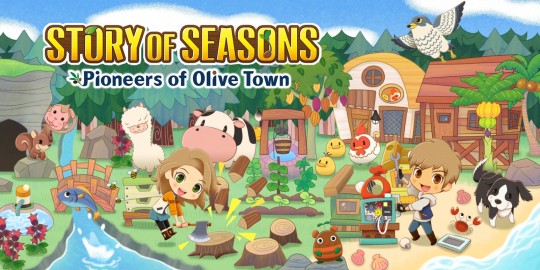
Overall Score: 5.5/10
. . . oh boy.
Well, I actually have a lot more to say than just that, but that should give you a general idea of what the rest of this review is going to be like. I do want to say up front that I have played through the entire first in-game year to give the game a fair shake, so please trust me when I say I did my due diligence to give this game a real chance before I reviewed it. If you’re ready, jump under the cut (best read on my blog for formatting reasons) and let’s get into it.
The Pros:
The character customization, while not perfect, is definitely several leaps in the right direction. None of the clothing or hairstyle options are gender locked, which is amazing. There is a variety of skin tones to choose from. You pick your pronouns independently of everything else, voice included, so you can 100% have a trans character if you want to (or a nonbinary character if you don’t mind using gendered pronouns for your nonbinary character). I do wish the clothing selection was better (especially at the start, when you only have two outfits to choose from) and having different body types would be cool as well, but the fact that you have so much freedom with regards to gender presentation is a definite plus.
Likewise, being able to have same-sex relationships is a huge plus as well. Honestly, it was what convinced me to pick up the game; I might not have gotten it if it didn’t have that option in there, but that pushed me over the edge. I mean, the fact that it’s 2021 means this sort of thing should be expected, but with Japanese games on Nintendo systems it’s really not always guaranteed, so the fact that it was included still does deserve to get a mention as a plus.
It’s easy to raise affection with the villagers by just talking to them, which is an improvement over Stardew where you pretty much had to give gifts to raise affection (because I don’t think talking did it, or if it did, it was abysmally slow). I was able to unlock heart events pretty quickly just by running around the town and talking quickly with the villagers each day, which is particularly nice since the preferred gifts can be pretty expensive at first.
I enjoy that not all of the heart events necessarily involve the farmer, especially for characters that aren’t romanceable. It’s nice to see the villagers interacting with each other more, to see that they have lives and relationships outside of the farmer’s sphere of influence. It also gives you unique insight into the characters, because how they act around or with each other isn’t always how they interact around or with the farmer.
Being able to sow seeds in multiple patches of dirt at once is nice, especially since otherwise it takes much longer than it does in, say, Stardew. I mean, in Stardew you can hold the A button and sow everything at once, whereas in Olive Town you have to do it one press at a time. So to be able to do a multi-plant is very nice.
The pet and mount selection is pretty great, too. I love how many different types of breeds of dog there are, how many different cats and different types of horses, and of course the unique mounts like the unicorn or the wolf.
The farm has a lot of space once you unlock the different areas, and is divided into neat sections to make organizing easier.
Having not played a Story of Seasons game before this one, and knowing that Stardew Valley’s developer was inspired by Harvest Moon, I can’t say entirely which features were unique to Stardew and borrowed and which ones Stardew borrowed first. However, I have seen others claim that the tool bar at the bottom of the screen (which is nearly identical to the one in Stardew) was unique to Stardew, so I can say that this is one area in which they copped something from Stardew and did it well. The fact that you can put your tools into a separate tool bag to make some emergency room in your bag is nice too.
The Neutrals:
While there are a lot of villagers and they all have their own heart events and interactions, the day-to-day dialogue can get very repetitive. I can’t tell you the amount of times Laura has told me about losing track of time during Laura Things, or how many times Jack has told me about how his mom told him about planting different crops and he thinks that’s just too much work. The dialogue only really seems to change around festivals / after plot changes, and it can really make characters that might otherwise feel fleshed out feel more like . . . well, NPCs. Which they are, but you don’t really want them to feel like that in a sim game. So while the characters are (mostly) unique, sometimes they can feel a bit repetitive.
The plot is a bit weird. It’s not bad, per se, but it’s weird that the plot focuses on wanting to turn the local town into a tourist hotspot. I get that the idea is that they want to bring commerce into the town (I guess), but that everyone is on board with it and the fact that it’s essentially gentrification just feels a bit . . . weird, for a game that’s supposed to focus more on nature. The tasks associated with it also get very repetitive, and that’s not even talking about how you literally have to improve the roads and lamps twice to make a difference.
The holiday festivals are also pretty average. It’s either a cutscene, or a tiny minigame (or sometimes not even a minigame, but I’ll get to that). The minigames are charming, but they’re not something that I’d want to do the following year. You’ve done it once, you’ve done it a million times. It’s also strange that there’s not a festival to celebrate your farm at all, whereas at least in Stardew we had the Stardew Valley Fair and I hear that in past Harvest Moon / Story of Seasons games they had farm celebration festivals, too. It’s just a bit strange.
The music is hit or miss, and mostly miss if I’m being honest, but I’ll still put it here. The songs are too short; they loop far too fast, and often sound no better than you’d expect a game on the GBA to sound (especially that first cave theme, ugh). There are some nice melodies, but again, when I compare it to Stardew (which I know isn’t exactly fair, but also Stardew is made by a grand total of one person when this game had an entire team so I feel it’s at least a little fair), it’s a pretty big letdown in the music department.
The bachelorettes are not very unique. Like, they are different, you can tell them apart, but . . . the primary difference between Bridgette and Linh, for instance, is that Linh is Korean (and also looks like a child which I don’t like at all if we’re being honest) while Bridgette is white. Otherwise they’re both sweet and shy and have basically the same personality. Reina and Blaire are also pretty similar, in that they’re both outgoing party types. The main difference between them besides their hair color (brunette and blonde respectively) is the fact that one works at the museum while the other is a waitress. The only one who really stands out is Laura, and while Laura is great (and the one I chose to marry), it’s still disappointing when you see how varied the bachelors are. It feels like not a lot of effort was put into designing the bachelorettes, which is sad when you consider they’re kind of major characters since they’re part of the dating pool.
The Cons:
This game is AWFUL to play. How, you may ask? Well, let me count the ways:
To start with, the loading screens are atrocious. There are loading screens between everything that you do. You go to town? Loading screen. You leave town? Loading screen. Start your day? Loading screen. Go in and out of barns or coops? Loading screens. And they take ages, or at least in this day and age it feels like they take ages. Particularly when you go into town, immediately realize you forgot a resource you needed for an upgrade, and go back so you get back to back cutscenes, they’re fricking awful. I cannot believe that loading screens this annoying were necessary for this game. I refuse to accept that as truth. They absolutely could have cut out the time it takes to load had they spent more time on development instead of rushing this title out for the anniversary, and speaking of things they could have ironed out in development . . .
THE LAG. THE FREEZING. THE CRASHING. THE POP-IN DISTANCING. If I didn’t know that an entire development team worked on this game, I wouldn’t believe it. This game is, put simply, a mess. Even when my farm was brand new and had pretty much nothing on it, I was noticing framerate drops both in docked and handheld mode. I’m talking, I had maybe one coop and two planted areas for crops, and the framerate was noticeably dropping. And now that I do have more stuff on my farm? Not only is the lag atrocious, but the game can’t load everything on the screen at once and so things have to pop into view after a few seconds. You can see video footage of this here, which also features one of the delightful loading screens. And this doesn’t even get into how the game will randomly freeze, or how I’ve had it crash once already. And from what I hear, I’m not unique in this. The fact they had the nerve to release this game as finished when it performs like this just boggles the mind.
Despite the fact that the Switch has two control sticks, this game plays only with one. This means that you can’t, you know, aim your tools with anything but the main control stick. And when you’re both controlling your character and aiming with the same control stick, the latter gets pretty hard. This leads to me missing things with my axe or hammer even when they’re right in front of me, as well as taking a lot of damage from the cave enemies simply because I couldn’t get in the sweet spot to both hit them with the hammer and also not get hit myself, particularly before they escape. It adds a lot of unnecessary frustration because the controls are so flawed and imprecise.
Similarly, there is a sweet spot when it comes to harvesting or picking up items off the ground, and it’s impossible to determine what that sweet spot is because you don’t get a little aiming box for that. So you can be right on top of an item and unable to pick it up because you’re not in that sweet spot.
Apart from the framerate drops, there is input lag as well. This is most noticeable when swinging axes or hammers, or trying to pet cows and other animals after milking them. And yes, I know it’s the game and not my Switch, because it’s not consistent (and also doesn’t happen with other games). Again, this is something polish and more time in the oven probably could have handled, but now it’s too late and just makes the game frustrating to play.
Technical, mechanical gameplay issues aside, though, there are still a ton of other issues. For instance: makers. Again, I can’t say if previous Harvest Moon / Story of Seasons games had these, or if they were invented by Stardew and copped by this dev team, but what I can say is that while makers also exist in Stardew, they are handled way better there than the absolute nightmare they are here. Again, to count the ways:
In Stardew, the makers can sit flush against each other and buildings, as well as flush against paths, making everything nice and not taking up too much space. Here, not only are the makers gigantic, but they can’t be flush with anything. They can’t sit up against each other, against buildings, or against paths. This means that not only do they look ugly, but they also take up a tremendous amount of space that therefore can’t go toward anything else.
In Stardew there are a handful of makers that do things. You’ve got furnaces for making bars, mayonnaise makers, cheese makers, fabric spinners, etc. There’s a variety, but it’s not so much that your farm becomes nothing but makers. By contrast, Olive Town is drowning in makers. You have all the above, but also more that contribute to those because . . . okay, let’s take the fabric spinners for example. In Stardew, you can put any type of wool onto the fabric spinning wheel, which will make one kind of fabric. In Olive Town, you first have to have a thread maker to make thread out of grass, AS WELL AS a yarn maker to make yarn out of wool. THEN you have to have a thread fabric maker to make fabric out of thread (and the thread differs depending on the grass used, which means you can make many different types of fabrics, but only one at a time), AS WELL AS a yarn fabric maker to make fabric out of yarn. So whereas in Stardew you have one maker if you need cloth, in Olive Town you need at bare minimum two, at max four, and that’s not even getting into how slow the process will be if you only have one of each kind. Because each maker only makes one of an item, and then you usually need multiples of that one item to make the next item in the series. So for instance, your thread maker makes one spool of thread, but it takes THREE spools to make one piece of fabric. Then you might need TEN pieces of fabric for a recipe. And the makers all take literal in-game hours to make. When you consider that the costs for some things are very high (the house upgrade I’m on right now requires 80 ingots and 120 pieces of lumber), you pretty much have to have at least four of each type of maker to get things done at any kind of reasonable pace, hence the factory hell my farm is currently in as seen in the above linked video. It’s a fucking nightmare. And yes, maybe it’s more realistic that you can’t go immediately from wool to fabric, but this is a farming sim where you interact with spirits, ride unicorns, and befriend wolves. This is not a game where you need to push realism.
The mining is also just . . . not fun. At all. Not only do you have the “it’s really hard to aim properly, especially when you’re trying not to take damage” issue mentioned above, but there’s also the fact that there’s just no variation. In the first mine there are no enemies at all, you’re just breaking rocks. The second mine introduces enemies, but only one type of enemy (basically little moles that you have to whack with the hammer). The third mine has the same enemies, but they’re stronger and appear in multiples. And that’s it. Unlike in Stardew, where there were tons of different monsters that did different things that made the mines exciting, here it’s pretty boring because the enemies are easy to avoid (and it’s best to avoid them because of how much of a pain in the ass to hit them without taking damage from running into them is) and the levels all pretty much look the same. Whereas I loved dungeon crawling in Stardew, here it’s something I purely do to get ore to make ingots in the stupid fucking makers because there’s literally no entertainment value to it otherwise, especially since the music is subpar at best.
Related to the mining, when you defeat enemies or drain lakes you can find bags of items that need to be identified at the museum. You can only have Reina identify these bags one at a time. So it’s a bunch of spamming the A button and hearing her go “oh!” over and over and over again because they, for some reason, couldn’t implement identifying items more than one at a time. And the best part? Identifying items comes with a LOADING SCREEN between you selecting the item to be identified and Reina identifying the item! How fun!!
You can really tell that they cut corners in this game, content-wise. For instance, the first festival in spring is an egg hunt. You would think that it would be a minigame where you look for eggs (again, like Stardew). You would think that, but you would be wrong. Instead, you get to watch an extended cutscene of your character finding eggs. That’s it. That’s the “egg hunt.” I skipped the mushroom hunt in fall because I assumed it would be the same, but apparently that one actually was a minigame, so joke’s on me, I guess. But either way, the fact that the egg hunt wasn’t an egg hunt at all speaks to cut corners and rushed dev time, just like the myriad of other problems that plague this game. It’s pretty bad when you can’t even include an egg hunting minigame for whatever reason (or at leas come up with unique events for spring and fall).
There is a ton of furniture with which to decorate your house, which is great! Or it would be, if you were actually given freedom to decorate, but you’re not. You can buy whatever furniture you want, but there are very specific places where you’re allowed to place it, and nowhere else. For instance, furniture and rugs can only go in the little space in front of your counter in your house in the first two house upgrades (Log Cabin and Small House). This space is very small. Despite there being a GIANT ASS FLOOR with which to cover a rug, I wasn’t able to use it until I got the third house upgrade. You have a huge empty table that you’re not allowed to put anything on. You can’t move any of the furniture around, nor can you rotate furniture that you buy when you place it. You also can’t place furniture on rugs either. Seeing so much furniture in the game is pretty exciting until you realize that you can do basically fuck all with it. Apparently they didn’t have enough time to implement real decoration into the game either. (Then again, imagine the lag in your house if they did.) As a final complaint, you can buy picture frames that claim to let you place framed memories in your house. You have a camera as an in-game tool, so you’d think that you could place pictures of your pets or your love interest in your house. You would think that, but you would be wrong. There’s no way to change the pictures in the picture frames, or at least none that I’ve been able to find just yet.
Just like Stardew, when you first arrive at the farm in Olive Town you find that it has been completely overrun with nature, and you have to spend time clearing away the debris so that you have a place to build your farm. Unlike in Stardew, the debris comes back at a ridiculously fast rate. Several in-game hours, if not more, of each day are spent cleaning up puddles (even if it didn’t rain), breaking rocks, clearing weeds, and chopping trees. Your farm can easily become overrun with nature again in just a few days’ time, meaning that a lot of your time that you would spend doing things like scavenging the mines or talking with villagers is instead spent doing basic, boring chores around the farm so that you still have livable land. And while farming sims like this one are games that are basically built around doing chores at least in part, the extent of the damage in this one (given that it happens all day every day, instead of just at the start of each season like in Stardew) really kills any fun or enjoyment you’d otherwise have as a player.
Farm upgrades come as entirely separate buildings, rather than expanding on the current building you have. So while in Stardew you could turn your existing Barns into Big Barns (and then Deluxe Barns), in Olive Town you have to buy an entirely separate building, and then painstakingly move all your animals to the new building one by one. Similarly, you can buy a silage to upgrade from your silo, but you’ll still have the silo on the farm. It doesn’t upgrade your existing development at all, despite being an upgraded form of that existing development.
I could go on, but you get the idea. Pioneers of Olive Town has some good ideas, but ultimately the terrible gameplay and lackluster execution of those ideas leaves so, so much to be desired. I will say that a patch was released recently which improved the loading screens a little, and for that I added the .5 to the score. (I took notes on things I liked / disliked / was neutral on as I played, so that I wouldn’t forget anything.) But a slight improvement to the loading screens doesn’t do much to help it when the lag is still terrible, the game still has freezes, and overall the gameplay itself just isn’t very fun. I probably will keep playing it for a bit longer to get to the marriage scenes at least, since I’ve almost maxed out Laura’s hearts. But honestly, there are so many better life sim games out there (the oft-mentioned in this review Stardew Valley being one of them) that if someone asked me if I recommended this game to them, I would have to say no.
Let’s hope the dev team does better with the next game. Maybe not feeling the pressure of it being the series’ anniversary will take some pressure off of them while they make it.
3 notes
·
View notes
Text
My 2020 Albums of the Year
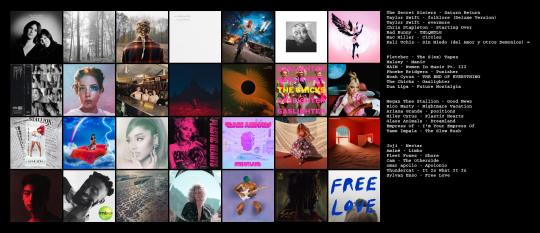
Never requested, always provided. Here are my favorites of 2020. Here’s the playlist.
The Secret Sisters, Saturn Return

As soon as I saw “Water Witch, featuring Brandi Carlile” on this tracklist I knew that the Secret Sisters would be a favorite of 2020. In February, I was staying with a friend in Nashville and she mentioned them as a local favorite, and when I stopped at Grimey’s to shop for records I came upon a signed copy of “Saturn Return.” I had never heard the Secret Sisters before, but there is nobody I trust more to recommend music than this Nashville friend of mine, so I bought it. I made no mistake here: this record blew me away. The soft, soulful, lullaby of “Healer in the Sky” pulled me through the pain of the first month of quarantine and soothed me as the world was turned upside down. In reading more on the record, this seems to have been the point: they say, “this album is a reflection of us coming to terms with how to find our power in the face of an unfair world… our hope is that women can feel less alone in their journey through the modern world.” There is something in the caramel-thick sweetness of these sisters’ voices that makes a listener feel as though they’ve been bewitched into calm. When I think of this album, I think of the cross-country drive I took at the beginning of the pandemic to make my way home and the happy moments that can be found in darkness. No album touched my heart this year in the way that “Saturn Return” did.
Taylor Swift, Folklore and Evermore
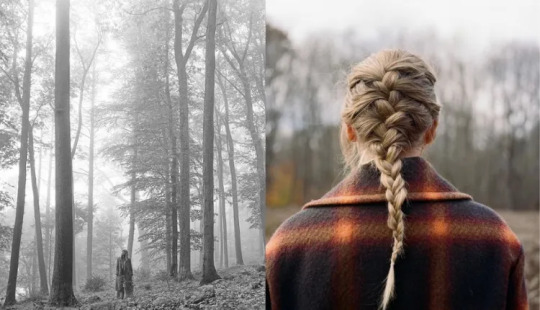
Taylor Swift… can even be said? Somehow, while we all sat on our couches in quarantine, this woman created not one but two musical masterpieces. She begins “the 1” by stating “I’m doin good, I’m on some new shit,” and that says a lot about the album as a whole. She created the 2020 we all wish we experienced: soft, sweet, and gentle. Listening to Folklore feels like visiting a cabin in the woods, with a fireplace well lit. Swift tells winding stories of love, hardship, and mystery and tenderly walks us through the forest of her imagination. This magical feeling was amplified by her release of The Long Pond Studio Sessions, a film in which Swift, Jack Antonoff, and Aaron Dessner finally play the album together for the first time after recording it entirely remotely. The setting matches the sound: they play in an album in the middle of the woods, cozy and hidden from the snow. Evermore cuts through the delicate ice of Folklore: it is the color to Folklore’s black and white. Swift combines the soft folk sound of “willow” with some of her country and Americana roots in “no body, no crime,” drawing us in once again. She includes Bon Iver singing in his lower register in Folklore and then in his falsetto in Evermore: two sides of the same magic coin. The work in these two albums is Swift’s strongest ever, and solidifies the fact that no modern artist can really reach her.
Chris Stapleton, Starting Over

Following a three-year hiatus, all lovers of southern rock deeply needed a Chris Stapleton album. In “Starting Over,” Stapleton yet again does what he does best: combines his unique whiskey-tinged growl with the best lyricism present in country music today. This record can’t be captured in any singular fashion, neither musically nor emotionally. The title track sets a high bar for the rest of the record with a reflection on re-remembering what really matters, a message certainly relevant for this turbulent year. Stapleton’s typical outlaw-country brand is present in full with “Devil Always Made Me Think Twice,” “Arkansas,” and “Hillbilly Blood,” but other songs take him in a completely new stylistic direction. “Maggie’s Song” takes on a very classic old-time country feel, as Stapleton weaves sweet and simple stories as he processes the loss of his pup. He harnesses the energy of the Chicks as he angrily lambasts the perpetrators of the 2017 mass shooting at Route 91. The song is a Stapleton-sponsored judgment day reckoning, including the cacophonic sound of a crowd in panic and the shrieks of a gospel choir. In contrast with this energetic high, Stapleton goes deep into his blues side by finally releasing “You Should Probably Leave,” a song he has been sitting on for six years. This one feels just right to sway around the kitchen to. With each listen to “Starting Over” I find new lyrics to write down and remember, new sounds to love.
Bad Bunny, YHLQMDLG

Bad Bunny. Our unproblematic reggaeton prince. In the wake of his many popular features and his collaborative album with J Balvin, Bad Bunny makes it clear that it is time for Balvin to share the throne of popular reggaeton. He features the original reggaeton king Daddy Yankee in “La Santa,” paying tribute to the very classic reggaeton style before mixing it and transcending beyond the classics in the following tracks. “Yo Perreo Sola” is the album’s standout track, accompanied by my favorite music video of 2020. The song is an ode to gender equality and the destruction of the patriarchal norms contributing to gender-based violence. “Yo Perreo Sola,” meaning “I twerk alone,” sets the overarching theme of consent present throughout the song’s lyrics. In the video, Benito’s backdrop references the Argentinian-born “Ni Una Menos” movement, a now global movement against gender-based violence. As if this wasn’t enough to make you adore him, the video further extends its activism to the LGBTQ community, with Benito appearing in full drag, in his normal attire, and at some points held in chains by women. He makes a statement about sexuality and gender expression in the video, twerking solo. The other jawdropper track on YHLQMDLG is Safaera, a perfect display of Bad Bunny’s skill in expanding the scope of reggaeton as a genre. In the same thirty seconds of the song, he subtly samples both “Could You Be Loved” by Bob Marley and the Wailers and Missy Elliot’s “Get Ya Freak On” - a segment I just can’t get out of my head. Bad Bunny’s prowess on this record is rounded out with the aggressive and prideful “P FKN R.” What a masterpiece.
Mac Miller, Circles

A posthumous record that never should have been posthumous. A companion-piece to Mac’s 2018 record “Swimming,” Circles takes a similar tone, one of resilience through pain. The title track serves as a somber introduction, followed by the funk energy of “Complicated” and the GO:OD AM energy of “Blue World.” The song that really got to me, and many other fans of Mac, was “Good News.” It is the pinnacle of Mac’s musical insight and talent. The melody matches the melancholy of the track, as Mac sings of his desire for time and space. The melancholy is matched in “Everybody” with the lines about death feeling particularly haunting in the wake of Miller’s accidental overdose. Somehow, Miller wrote the perfect eulogy for himself prior to his passing, one that will live in the hearts of his fans forever.
Kali Uchis, Sin Miedo (del Amor y Otros Demonios) ∞

I’m not quite sure what to call this record. If I just listened to “la luna enamorada,” a cover of a classic Cuban bolero, I would call it gorgeous. If I just listened to “fue mejor” featuring PARTYNEXTDOOR or “quiero sentirme bien,” I would call it sexy. If I just listened to “vaya con dios,” I would think she wrote the theme music for the next James Bond film. The bottom line of the record is Uchis’ absolute stunning use of her upper register. She hits notes that “Isolation” never would have foreshadowed, painting a dreamland for any listener. She slides back into the energy of her sophomore album in “telepatia,” but adds in moments of her new sound. She incorporates a slower reggaeton beat into no eres tu (soy yo), and dives into a heavier reggaeton sound in te pongo mal (prendelo.) My personal favorite of the record is “aqui yo mando!” with Rico Nasty: it is the perfect display of Uchis’ unique upper register combined with Rico’s trap style. Anyone passing this record up for another “Isolation” listen is missing out.
FLETCHER, The S(ex) Tapes
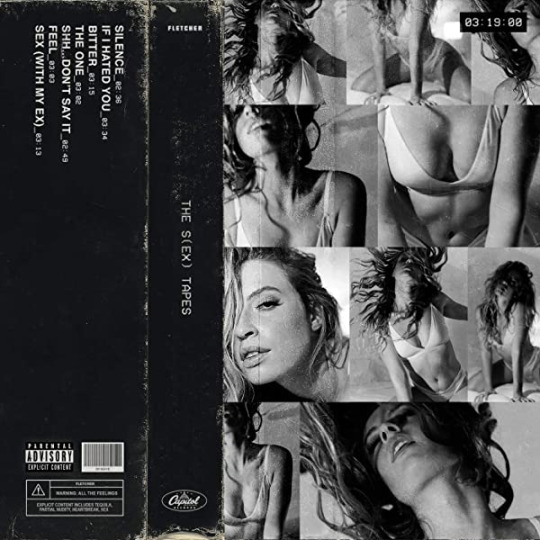
This record has a story like no other, coming from a woman like no other. This EP was recorded while Fletcher quarantined with her ex-girlfriend, who also happened to film all of the music videos for it. It is this messiness that makes The S(ex) Tapes absolute magic. Fletcher’s own description of the name of the release explains the situation best: “A sex tape is someone being captured in their most vulnerable, wildest, rawest form, and my ex has always captured me that way.” She captures all of the feelings of a breakup with someone you still love deeply, and the relationship relapse that comes with moving past those feelings. Fletcher’s special ability comes in representing these deeply painful experiences in an uplifting manner: this is a sexy pop EP meant to be danced to. Fletcher simultaneously validates all of the emotional tumult, but subtly nudges the listener toward blissful reckless abandon. It almost makes me wish I had a breakup to go through! The abrasive apathy of “Shh… Don’t Say It” and the flippant, angry vulnerability of “Bitter” are paired perfectly with Fletcher’s raw brand of distortion. In an interview with Nylon, Fletcher speaks to this: “Listen, I've done my fair share of just straight-up sad, crying in your bed music. I'm still going through shit, but I want to bop to it. We can still be emo and want to twerk at the same time.” Yes, Fletcher, we do.
Halsey, Manic

Prior to 2020, I wasn’t Halsey’s biggest fan. I wouldn’t have even called myself a fan. I just wasn’t that excited by her music. “I’m Not Mad” was the song that triggered a 180 for me. The heavy, dissonant kick of the drums and her raw, angry lyricism drew me in without hesitation. I suppose this was just the push I needed to fall in love with the rest of her music: the songs with similar bite, “Without Me” and “killing boys,” and the more raw side of the record in “You should be sad,” “929,” and “Graveyard.” Her vulnerability is so much of what makes this record perfect. The album fully made sense to me when I listened to her podcast feature on “Armchair Expert” with Dax Shepard. In it, she talks through the time period covered by the record and gives context to her powerful lyricism. “Manic” is a story of chasing someone she loved into drug-fueled oblivion, and then finally finding the power to leave. The album is brimming with this power, and I just can’t turn it off.
HAIM, Women In Music Pt. III

HAIM is THE soft rock band of the modern era.Women In Music Pt. III, their most mature album yet, solidified this opinion for me in a way that I didn’t expect. There is so much to be said for this record: it is innovative and skilled, with the perfect balance of softness and hardness. Though the record is one of pain and trauma, you wouldn’t know it purely from its melodies. “Don’t Wanna” is a very classic HAIM pop rock number, and “The Steps” follows suit making frustration fun to dance to. Though one may not notice at first, in this record HAIM dives deeper than ever before. “Now I’m In It” does a phenomenal job of sonically representing the feeling of being completely and utterly overwhelmed. “I Know Alone” is a beautifully intimate rainy-day account of Danielle’s struggle with depression. Then comes “3AM” - a lighthearted song about a booty call with Thundercat-type bass and an R&B vibe - just in case you didn’t already know how much range these three sisters have. Everything about this record is filled with talent.
Phoebe Bridgers, Punisher

Only Phoebe Bridgers could write a song about murdering a skinhead and fill it with nostalgia. “Garden Song,” the leading single preceding “Punisher,” foreshadowed a record that is just so very Phoebe: melancholy, vulnerable, and heart-wrenching. The eagerly awaited album certainly followed suit, with typical sad ballads “Halloween” and “Moon Song” played alongside more raucous, Better Oblivion Community Center-esque songs such as “Kyoto” and “ICU.” She goes bluegrass on “Graceland Too” with banjo, violin, and layered harmonies from boygenius collaborators Lucy Dacus and Julien Baker. In “Punisher,” Bridgers shares with us the wistful catharsis that she is so very talented at creating.
Noah Cyrus, THE END OF EVERYTHING

I always underestimated Miley’s little sister, but here I am writing about her EP before I write about Miley’s in my end of the year roundup. Every piece in this record gave me chills: Cyrus’ lower register allows her to access a somber kind of ballad that I just can’t get enough of. The record starts off at a peak with the slow burn of “Ghost” and somehow manages to get even better with “I Got So High That I Saw Jesus.” This powerful song, even better in the live version where Miley joins her younger sister, builds into an almost gospel-like ode to the idea that everything will be okay. “July,” the single featuring Leon Bridges that pushed Cyrus into the national spotlight, stands as the most beautifully layered song of the EP. The soft guitar picking and choral sound complement Cyrus’ upper register. The whole record, extending through the closing title track, is a comforting, soft emotional analgesic for 2020.
The Chicks, Gaslighter

This record is gorgeous. It is painful. The feelings Natalie Maines expresses in this record are feelings I have felt far too deeply in personal relationships, and they also are feelings everyone is feeling globally in 2020. “Gaslighter” is just straight up fun, a perfect extension of the Chicks’ energy found in “Goodbye Earl” and other older revenge numbers (but with an extra poppy Jack Antonoff twist this time.) “Tights On My Boat” is bitter, funny, and shows off Maines’ upper register with stripped guitar. “Sleep at Night” musically and lyrically embodies the pain of being betrayed. “Julianna Calm Down” is a stunning ballad of female resilience. “Texas Man” perfectly captures the bubbly feeling of moving on. “For Her” and “March March” fit in with the frustrated, betrayed, power-centered theme of the record in a very different way. The Chicks’ dualistic ability to discuss her ex-husband’s cheating alongside the band’s political views is what makes the record special: not only are we watching a woman try to move on and develop her personal strength, but we are also seeing this personal strength harnessed for political impact. They simultaneously denounce the abuse of power in both politics and relationships, while reclaiming that power for themselves in standing up for what they believe in. How very Chicks of them.
Dua Lipa, Future Nostalgia

Dua motherfucking Lipa. This woman would have been the official owner of 2020 had we been able to dance to this record at bars and clubs. This was proven ten times over by the success of the album’s first single, “Don’t Start Now,” a song that is absolutely the MOST fun. Or so I thought… until I heard “Physical,” “Levitating,” and “Break My Heart.” What poor timing for such a phenomenal dance record, but at least she gave the people some great material for Tik Tok dances! All COVID-dance-related concerns aside, this is a really well done sophomore album for Dua Lipa. The funk elements of the album most clearly seen in “Levitating” elevate Dua’s brand of pop to a new level. The all gas no brakes nature of this dance-pop record works wonders for her - she knows what the people want from her, and she delivers.
Megan Thee Stallion, Good News
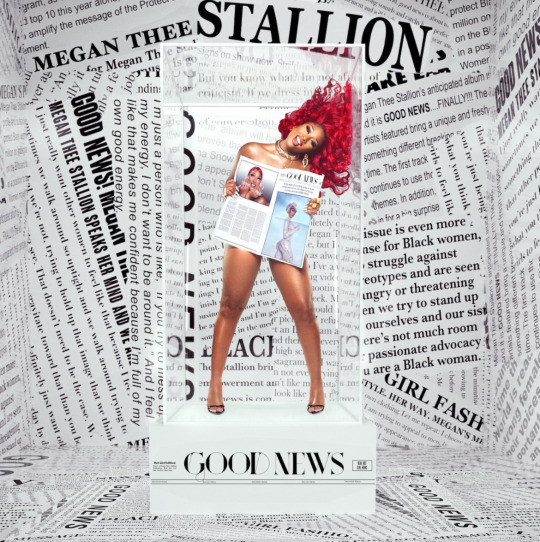
THIS! RECORD! If WAP could be an album of the year, it would be, but it’s a standalone single and Megan Thee Stallion proceeded to release the next best thing. The explosion of Megan Thee Stallion has been a pleasure to watch in 2020, with both WAP and Savage leaving the charge. With an artist like her, it’s easy to get lost in the smash hits and ignore the prolific nature of her work. “Good News” is an immaculate rap album, brimming with sass and defiant bad bitch energy. “Shots Fired” kicks off the album with a Biggie sample and a diss to the man who shot her in the foot earlier in the year, personally my favorite track of the record. Other highlights of the record include “Don’t Stop” with a Young Thug feature, “Body” which is now a Tik Tok staple, and “What’s New.” Perhaps the most impressive work Megan does on “Good News” is “Girls in the Hood,” a rework of Eazy-E’s Boyz-N-The-Hood. She inverts the classic misogyny of the original song by emphasizing her control over men like Eazy-E in an indignant assertion of female power. This embodies Megan Thee Stallion’s essence: busting in on a male industry and making her presence known.
Rico Nasty, Nightmare Vacation

Nobody does it like Rico Nasty, and I’m convinced nobody ever will. I saw a New York Times headline titled “Can the Mainstream Catch Up to Rico Nasty?” the other day and I think the answer is a firm no. Rico is abrasive, rude, and outside the box in the absolute best way. Need an album to slap in the car when you’re feeling like a bad bitch? This. is. it. The record kicks off with “Candy,” a song with a wild beat and the iconic chorus line “Call me crazy, but you can never call me broke.” Following is a Don Toliver and Gucci Mane feature in “Don’t Like Me,” a song that truly should have hit the mainstream by now. She gets back to her signature scream-rap in “STFU” and “OHFR.” “OHFR” is the confident standout of the album, along with the reworked re-release of “Smack a Bitch,” making it clear that Rico Nasty is not a woman to be fucked with. In “Back and Forth” with Amine, Rico steps into Amine’s “Limbo” style and does it well. The record’s second single “Own It” is a more classic club banger that unfortunately didn’t get to see the dark of night in any clubs this year. Even if the mainstream never catches up to Rico Nasty, I’ll be following along with her self-labelled “sugar trap.”
Ariana Grande, Positions

I mean, duh. Ariana just doesn’t miss. She surprised everyone with this album’s release in Fall 2020, displaying the bliss of her relationship with later-confirmed fiance. She goes dirtier than usual in the sex-centered “34+35” and “nasty,” rounding the record out with the Craig David-reminiscent “positions.” Ariana allows herself to lust for someone and even love for them in these three, but defaults to her brimming self-confidence in “just like magic” and “west side.” The album is more R&B than pop at times, with the peak of this style visible in the groove of “my hair” and the Mariah Carey ballad-like nature of “pov.” Each album, Grande shifts just a little bit, keeping us attached: “Sweetener”’s cotton-candy pop, the savage pop-trap of “thank u, next,” and the R&B conclusion of the spectrum with Positions.
Miley Cyrus, Plastic Hearts

This year I anticipated no record more than I did “Plastic Hearts.” Its leading single, “Midnight Sky,” described by Pitchfork as a “cocaine-dusted disco track,” channels Stevie Nicks’ eighties rock-pop era in the absolute best way. Apparently this opinion was even picked up by Stevie herself, as the two collaborated on a mash-up of “Midnight Sky” and Stevie’s “Edge of Seventeen” (the excitement from which nearly led to my passing away, by the way.) Cyrus’ voice is in the perfect place on this record, with “Plastic Hearts” emphasizing her rasp and making me want to spin around a room. She dips into the pop realm in “Prisoner” with Dua Lipa, a song that Lipa clearly influences with an unforgettably sexy music video. Every song is different on this record: “Gimme What I Want” channels the grinding rock sound of Nine Inch Nails, “Bad Karma” allows Joan Jett’s punchy style to run the show, and she slips on the shoes of Billy Idol in their collaboration, Night Crawling. Somehow, Miley manages to wear the shoes well, and 80s copycat record or not, I can’t stop listening. “Never Be Me” is where she shines most deeply, baring her soul, the complicated nature of her past few years’ journey, and her knowledge of who she is and always will be for the world to hear. I’m not sure if I’m blinded to the album’s flaws by my absolute and complete love for everything about Miley’s current persona, but I am a huge fan.
Glass Animals, Dreamland
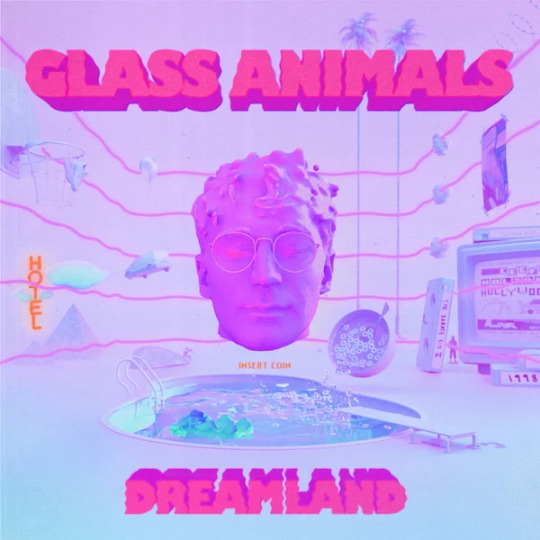
The sound of this album is such a blissful respite! Glass Animals gives us the fun and funky techno-pop that they always do, but dive into personal lyricism in a way that they never have before. Many of the songs actually have a storyline (an intentionally rare feat for Dave Bayley, first broken with the incredible “Agnes” on their last album.) This record explores trauma and pain in “Domestic Bliss��� and “It’s All So Incredibly Loud,” Bayley using the soft sides of his voice to express pained desperation. The boisterous energy of the past two records is not forgotten in Dreamland’s intimacy, however: “Hot Sugar,” “Tokyo Drifting,” and “Space Ghost Coast To Coast” do the trick. “Space Ghost Coast To Coast” is the most intriguing song on the record: at first listen, I had absolutely no idea what Dave was discussing and assumed it was just his typical neuroscience-inspired ear-candy. Upon a deeper dive, the song addresses the factors that encouraged Dave’s childhood friend to bring a gun to school. He disguises a discussion of the risk factors involved in school shootings within his flowery, figurative linguistic excellence. This duality of blissful melody and solemn subject matter is the magic of Glass Animals.
Empress Of, I’m Your Empress Of

This album is an emotional electro-pop masterpiece. This record meditates on the feelings felt in the wake of a relationship’s end. She begins the album with a quote from her mother about the reality and value of struggle, then launching into a synth-filled storm of missing someone. “Love Is A Drug” is the album’s next fun dance track, addressing the addictive quality of touch after you lose someone you love and embodying the urgency of the feeling. She takes a more somber tone with the influence of Jim-E Stack in “U Give It Up,” incorporating quotes from her mother about the difficulty of womanhood and reminiscing on love lost. In “Should’ve,” the post-relationship regret is palpable in her vocal tone and production, and in “Maybe This Time” she contemplates this pain. In “Give Me Another Chance,” her emotions swing the other way, with a bouncing dance beat and pleading vocals. The album concludes with the heartfelt and pain-filled “Hold Me Like Water” and the dissonant “Awful,” leaving the listener to meditate on the mood swings of a broken relationship.
Tame Impala, The Slow Rush

This album came out so early in 2020 that it already feels like a vintage piece of music. Perhaps that was the point. Although “The Slow Rush” had a hard time living up to Kevin Parker’s last epic masterpiece “Currents,” it was the fix many fans like myself needed after five years without an LP. “Borderline,” the single that allowed anticipation of the album to build, stands out as one of the most essentially Parker tracks of the record. He introduces a little Toro y Moi style funk in “Is It True,” and highlights his voice more than usual in “Lost In Yesterday.” “Posthumous Forgiveness” builds in the wonderfully dissonant fashion that fans learned to love through “Eventually.” The bass track on “Glimmer” is so good that I never even noticed it had nearly no lyrics. This record is not groundbreaking by any standards in the way that “Currents” was, but it is intentionally jubilant and energetic in a way that still feels good. Even if he doesn’t shatter any expectations in “The Slow Rush,” Tame Impala’s tracklist still makes the perfect sunset companion.
Joji, Nectar

Joji’s “Nectar” is just that: sweet R&B nectar, from the minute the first track plays. Joji’s work here is not in the individual tracks, but in the sonic experience he creates with the album as a whole. This is not an album to pick out singles from: it is a full cinematic mood adjustment. Maybe it’s the weed I smoked when I first listened, but the record feels like a wonderful progression of gentle yet rhythmic R&B songs. The transition from the soft and contemplative “MODUS” to the more upbeat trap-infused “Tick Tock” to the full R&B ballad “Daylight” featuring Diplo raises the listener’s energy gradually to a crescendo. “Run” is a gorgeous and sad confessional of disappointment, and “Sanctuary” follows as a soft and uplifting analgesic to that pain. “Pretty Boy” and “777” mark the more upbeat section of the record, filled with Joji’s accounts of living far too fast. The tracks of this record all bleed into each other seamlessly, mixing pain and confidence in an emotional rollercoaster.
Amine, Limbo

My journey to being an Amine fan started with “Caroline,” ended with “Heebiejeebies,” and started back up again when he found depth in “ONEPOINTFIVE.” His 2020 release is exactly why I came around to his music yet again. The record is soulful and fun, with the flute and cocky lyrics in “Woodlawn” and the funky beat and Young Thug feature of “Compensating.” The two songs I absolutely can’t stop listening to however, are “Can’t Decide” and “Becky.” “Can’t Decide” highlights Amine’s singing voice and dips away from rap and trap into the more traditional R&B realm. “Becky” is an intimate account of the difficulties involved with interracial dating, both in public and in the family realm. The two sides of the album, one emphasizing rhythm and immaculate production, and the other lyricism and emotion, are found in these two songs. The punchy “Pressure In My Palms” (featuring slowthai and Vince Staples) and “Riri” round out the record’s light side. In “Limbo,” Amine finds the perfect balance.
Fleet Foxes, Shore

This album is a wave of calm. Robin Pecknold’s soothing voice is exactly what we needed more of this year. Pitchfork described his mission as “turning anxiety into euphoria,” and that is how this record feels. Each song is dynamic and filled with what makes Fleet Foxes so special. There is a choral quality to the vocals of “Shore,” as always, adding to the calm aura of the record. “A Long Way Past The Past” takes the listener on a what feels like a long walk filled with serious conversation. “Going-to-the-Sun Road,” a song that takes its name from the famous cliffside road through Glacier National Park, oozes sunshine in its Tame Impala-Bon Iver crossover sound. “Cradling Mother, Cradling Woman,” truly feels like being cradled in sound. Fleet Foxes has a knack for beginning songs by hitting the listener with a wall of sound, and that is so perfectly represented in this track. This is a seriously beautiful album.
Cam, The Otherside
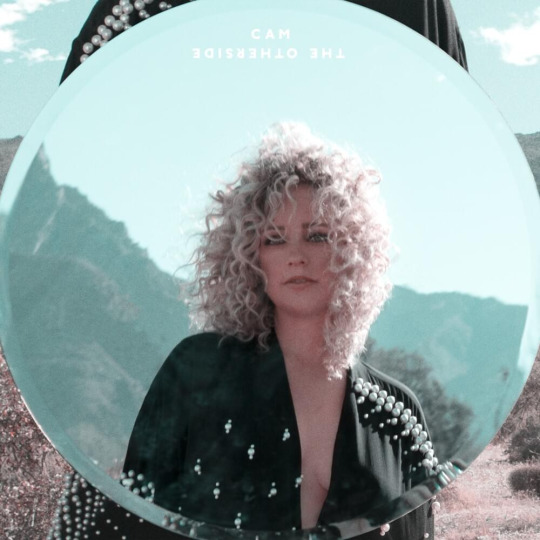
Cam’s voice is irresistible. She showed her talent for sharing painful ballads in her breakthrough single “Burning House,” and in “The Otherside” she digs deeper. She writes this record in a period of change, and captures this change and dissonance in the nostalgia of “Redwood Tree.” She teamed up with Avicii for the title track before he passed away, and it shows. His signature building melodies and guitar breaks are clear, and they go perfectly with the range of Cam’s voice. She truly shows her range in this track and this record in general, from the highs in “The Otherside” and the lows of “Changes.” “Changes” is another standout of the album, co-written by Harry Styles. This record is a gorgeous account of outgrowing love and outgrowing people after the deep bliss that you felt with them in the past. “Till There’s Nothing Left” and “Classic” are the big love songs of the record, one that melts you and one that makes you want to dance in a field of flowers. The sisterly confessional “Diane” pulls Cam back to her country roots. She ends the record with what made her famous: a beautiful, sad ballad backed only by piano. Her unique vocals are on full display as the record concludes, and I couldn’t have asked for anything more.
Omar Apollo, Apolonio

Omar Apollo had his breakthrough in this record. His work spans languages and genres in a big way in “Apolonio.” “Kamikaze” and “Staybacik” stick to his typical R&B style, better produced than it ever has been. “Dos Uno Nueve (219)” goes a completely different direction, a Mexican corrido track featuring Yellow Room Music, honoring the Latinx musical styles that he expressed admiration for. Apollo also explores his sexuality in this album, fluidly discussing his bisexuality in “Kamikaze” and “I’m Amazing” in an exploratory manner. The whole album is generally quite exploratory, a quality that makes me even more excited for the work that is to come from Apollo.
Also worth mentioning:
Diplo, Diplo Presents Thomas Wesley: Snake Oil
Thundercat, It Is What It Is
Sylvan Esso, Free Love
Lauv, ~how i’m feeling~
Niall Horan, Heartbreak Weather
J Balvin, Colores
Kelsea Ballerini, kelsea
Dominic Fike, What Could Possibly Go Wrong
3 notes
·
View notes
Text
Overtime | Dungeons and Dragons Commission
This is a 5k commission piece for an anon with their DND characters.
Title: Overtime Fandom: Dungeons and Dragons (DND) Summary: Neronvain never expected anyone to find him after he left his family, but here he is. On a stranded island after getting ‘caught’ twice by the same dragon slayer who is determined to do her job and get him back home to face his punishment only for their ship to get completely destroyed. Character(s): Neronvain, Algatharas, Original Tiefling Character (Desire) Rating: Teen Requested Word Count: 5k Final Word Count: 5,028
This is a sequel to Stranded
Read it on Archive of Our Own
Commission Me | Tip A Writer | Twitter
Overtime | Word Count: 5028
Neronvain watches Desire from a distance, out of place and uncomfortable being in the middle of town. No one pays him too much attention, but he still does his best to stick to the shadows and the walls, avoiding the middle of the street and the vendors as much as possible. He had to argue with the ones that he did buy from until they gave him a decent, actual price.
Desire, however, does not seem to argue with the vendor much at all. She starts to, at first, get the price lowered from outrageous to slightly less outrageous but still overpriced. But the more that the vendor talks, the more she listens. The more that she begins to ooh and awe at all the right moments. He could see the way that the vendor’s eyes lit up when she handed them the money.
This absolute idiot. Neronvain mourns the fact that this is the person who he has to follow. How could someone so easily swindled be the same person who somehow convinced the High Council of Elves that he, of all fucking elves, can be redeemed?
He really feels like he has reached what is certainly the lowest point in his life; though it may not make sense, this somehow, at times, feels worse than the cult. It is as if just being near her sucks out whatever little dignity he has left.
It makes it worse at how many times he’s failed at getting away. He learned really fast when he was forced to join her that running away simply does not work. She tracks him down too fast for him to make any headway. To make it worse, she is not scared of tackling him on sight if she so much as thinks that he is going to try to run. She is, surprisingly, strong. And quick.
He’s still sore from the last time she tackled him.
A few weeks in and he’s already given up trying. After all, what is the point? If she does not catch him and he does manage to get far away, what is he supposed to do? Go back to the kingdom that kicked him out? Go back to the cult that is definitely pissed at him? Chuth is not the forgiving type. He is sure that the dragon would find him. He may as well stay with her; at least he knows that she won’t kill him in his sleep and at least she has some decent dragon slaying abilities. Even if she’s failed to slay Chuth - twice.
“You paid too much for that.”
Desire furrows her brows, her lip curling as she looks down at the trinket. It is an odd looking thing. He thinks that it is supposed to be a sculpture of a dragon, but it could be a dog. Or maybe a deformed cat.
“Good then maybe you’ll appreciate it better.”
Neronvain barely manages to catch it as she throws it at him at full force, the trinket hitting him square in the chest hard enough to knock the wind out of his lungs.
_________________________________
To Neronvain’s displeasure, he waits for Desire’s signal. He can see the bandits from his hidden position; none of them have noticed any of the members of their party yet. Each of the bandits have a decent bounty on their head that will last them quite a while even if they split the bounties evenly. Neronvain hates to admit that he could honestly use the coin, even though he doubts that Desire will give him an even cut.
He doesn’t see why they have to wait. The longer they wait, the higher the chance that they will be spotted and lose their element of surprise. He keeps glancing at Desire's hidden spot. She is the closest to the bandits than any of them, but to his surprise, she has not done anything to give away her location or theirs.
Her eyes are focused. More focused than he thought she was capable of being. She doesn’t even acknowledge him, staring intently at her targets with a hand hovering at the weapon at her hip. Her eyes lack their usual spark of humor and instead are hooded. Serious. She does not make any motion to signal them to make their move yet. The bandits are all circled around a fire in the dark of the night, drinking and not having too much care for their surroundings. She has one of their members hide near one of the clearing in the treeline - the entryway to a route through the otherwise thick and dark woods.
Desire discretely moves to their horses. She makes a motion for one of the other members to join her and together, they cut the reins of the horses off from the trees. Effectively and quickly, she has disabled the bandits only means of transportation and their fastest getaway route.
Neronvain shifts with furrowed brows and thin lips before he shakes any thought that comes to his head out. Now isn’t the time or place to focus on her change of character or surprisingly good battle focus and strategies. He makes his move at Desire’s signal as she slaps the rears of the horses, causing them to run off into the woods.
The bandits react fast, but not fast enough. Despite the fight that they put up, Desire manages to take charge and get them all tied up without too many problems. When some of them start to yell profanities, she gives the worst of them a hard knock to the head to render them unconscious while gagging the others.
“See, easy money,” Desire gestures toward their captives with an infectious grin, meeting his eyes with a twinkle, “Wasn’t too hard, was it? I think that’s about a good thousand each at least.”
The acknowledgement of their cut - and more specifically, the way that she meets his eyes as she mentions his half - catches him off guard. He thinks that her math is a bit off, but he doesn’t oppose the statement as he eyes her appreciatively, his own smile threatening to break through before he simply gives her a nod.
____________________________
Neronvain watches her in the bar with curiosity as he nurses a mug of ale. The low light of the tavern doesn’t do anyone any favors, making the entire establishment feel a mix of melancholic and untrustworthy. Everyone else in the bar is either wallowing in their pity, playing pitiful gambling games, or on the brink of fighting. Desire seems to have been roped into playing a gambling game with some of the other patrons - or more so, against the other patrons.
Her eyes are lighter - a spark gleaming behind them that he doesn’t quite remember seeing before. Even her smile seems more carefree. He wonders what it would be like to be one of those people who can smile as easily as she does. But the most prominent feature is that she looks like she belongs.
He looks down at the mug, losing himself in the swirls of his drink as he downs it and orders another as he reminds himself that even he isn’t completely immune to her strange charm.
He was never able to do that. He never figured out that part of communication very well, never really understood how to get along. Alagarthas could - his brother does. It’s why everyone always prefers Alagarthas over him, why he’s the one that they flaunt and crowned, why he’s the one that is always mentioned in meetings and is invited to the parties, the balls, the charities. Even when he was still a prince - he never belonged the same way that Alagarthas does. He argued. He fought back. He was too abrasive. Too rebellious. He could never get anyone to agree with him nor did anyone want to.
His eyes drift to Desire. Her face is partly hidden by the cards she holds in her hands, coins in neat stacks along the table. He sighs deeply - the reason she holds her cards so close being too obvious. Everyone else at the table sees through it; she’s trying to hide her expressions because as smart (and dumb) as Desire can be, she still has her tells. Hers, in this case, is that the whole game she has kept her face steady until now; which means she either has the best hand or the worst, something in her hand changed so much that she has to hide her face now to keep her emotions a secret.
Either way, it won’t be too hard for the other players to figure it out and Desire is going to be losing the coins she stacked very soon.
He almost doesn’t do it, but after a brief moment, he takes one last drink before he saunters over toward the game table. He stands behind the person across from Desire discreetly, but she spots him the moment that she looks up. He presses a finger to his lips as a signal to stay quiet as he looks at the fellow’s hand. He gives her a few signals and she catches on fast.
They work like that - together - until each player at the table has to give up their hand as coins get pushed Desire’s way. Oddly enough, his chest feels warm and lighter as the corner of his lips twitch as she gives a few loud cheers. When Desire meets his gaze, he gives her a discrete nod before returning to his spot at the bar.
To his surprise, as the attention died down on the game and patrons dispersed - some cursing at the win while others mourned their losses - Desire sits down beside him at the bar. She makes a bit of a show settling a heavy coin bag on the counter in front of her.
She doesn’t acknowledge him at first, ordering her drink, before Neronvain realizes the discrete small coin bag that is behind handed to him under the counter. He takes it with confusion, looking at her for answers.
She doesn’t give him any, instead smiling with a wink before she disappears with her drink.
________________________
Neronvain almost doesn’t notice it at first, the shift in their dynamic. It happens so naturally and organically, that he almost forgets that they used to be enemies. But it seems like all he does is blink and Desire is the one that is helping him back on his feet in a fight or hitting the guy behind him that he misses. She gives him that cheeky wink and grin every time too - as if she has always had his back. Like she plans to always do.
It’s strange. Neronvain never really had any friends growing up, but here is with more friends than he’s ever had in his lifetime. Even the other members of their party have begun to accept him, inviting him to their parties and to their missions.
But something about Desire is different from the rest. He can’t put his finger on it, not yet. He doesn’t know if it’s because she’s the one who saved him or if it’s because she’s the first one to reach out to him, but something about her friendship feels different than the others.
Deeper, almost. More natural. There’s no awkward tension or wall that he has to break down. He doesn’t have to explain himself to her and she never asks him to. It is as if she accepts him, but he didn’t think that type of acceptance is possible. He didn’t think that there is really anyone that is just that good that they can just accept him fully as a friend knowing what he’s done. And yet, in comes Desire with her dazzling smile and mischievous eyes.
He didn’t think anyone could be so charismatic and unintimidating, yet so strong either. He’s seen it in the cult and in his brother. You are either strong, intimidating, and solid, or you are charismatic and soft-willed. He’s tried to balance his wit with his strength, but even it gets shaky for him sometimes. But yet again Desire has proven him wrong; her strength in every fight makes her intimidating, but her strong heart is what makes her charismatic and likable.
“Come on, we’re going to town.”
Desire’s grin spells future disaster - the type of disaster that is likely going to get them kicked out of another bar or get yelled at by a barmaid. Last time, a woman splashed her drink on his head and it wasn’t even his idea in the first place.
Desire does not hesitate to grab him by his arm to drag him into town with her. Her grip is loose and gives him the chance to break free if he wanted. But he doesn’t object nor does he pull out of her grasp as he thinks about all the things that she has proved him wrong on; the number is staggering, honestly, but it doesn’t upset him.
Oddly enough, it makes him happy.
___________________________________
He tells himself that the parchment he received is not the reason that his hands are shaking. It’s not - it’s not - it’s not. His throat feels dry, a soreness building up around his neck as his chest feels warm.
Neronvain finds himself glad that instead of camping out, that they have rented rooms at the tavern for the night. It gives him a chance to go over this - what it means, how it makes him feel, how is he supposed to respond - in private.
He sits down at the small, slightly rotting desk and chair in his room. His mug is already empty, but he can’t bring himself to go back down for another drink. Not right now. He doesn’t think that he can see anyone right now, not even the barkeep or his other party members that are most definitely still partying and drinking downstairs.
Alagarthas.
He didn’t expect his brother to write him a letter; he didn’t expect his brother to do anything actually. It would be too dangerous, too risque. It would risk a scandal. Why would his brother risk so much just to get a letter out to him? The simple fact that he was able to do this without anyone else in the castle knowing about it is impressive.
His brother has always had a habit of writing long letters that are often full of needless details, yet the letter he wrote is shorter than normal. It is more to the point and there is no beating around the bush or useless gossip. All the more reason that he can tell that his brother means every single word that he wrote - that he actually cares. The tremble in his hands worsen as he looks it over for the tenth time.
Desire told me where you are all staying. Alagarthas had written. It was a risky thing for her to do, but I cannot thank her enough for it because it gives me a chance to reach my brother and to apologize. For everything.
Neronvain could feel his heart beating wildly against his chest and he venmously wipes at the corners of his eyes as he continues to read on. Everything that his brother wrote is like an arrow to his heart. Every single word is full of heart. Love. Care. Warmth. As Alagarthas writes about his mistakes, about how much he misses him, that he wants to see his brother again.
Emotionally, it is a lot to process. A lot to take in and really believe. But the letter is in his brother’s handwriting and there are no signs of it being fraud or forced. His brother actually wanted to get a hold of him - to apologize for all things. Risking everything just to say sorry? To say that he cares?
It takes some time, a lot of time. But eventually Neronvain is able to write a letter to be sent back. He is careful to keep his hands steady with each word. He tries to keep his emotions in check, tries to keep it casual, but he thinks that a bit of his emotion seeps into a few words here and there. He rereads it over and doesn’t have the heart or the emotional energy to rewrite it.
With a heavy heart so full of emotion that it makes his chest feel heavy, he drags himself downstairs to be able to get his letter sent out. He sticks to the shadows and discretely stops at the bar to have a few more drinks sent to his room when he passes by the barkeep. He can see the others drinking, laughing, and cheering as a group with their mugs raised high. He can practically smell the alcohol on their breath from his position. None of them notice his presence or if they do, they don’t acknowledge it.
He does not see her. Not at first.The one person he does feel like seeing right now, the one person that made this possible. Desire is not partying with the others, at least not anymore. He isn’t sure if she got worn out from their shenanigans or if she is just getting one last drink before retiring for the night. She is not cheering or gambling, instead she is situated calmly at the bar with a particularly thoughtful expression on her face. Her eyes look dazed and hooded, like she isn’t all there.
He hesitates for a moment when he sees her, unsure about what he could say to her or even if he should say anything in the first place. He even briefly wonders if she is going to be sober enough for anything that he has to say at all. His eyes shift to the letter in his hands and makes a decision, stepping forward firmly.
He reaches out to her.
She looks up at him with startled eyes when she feels his hand on her shoulder. He pauses, his eyes softening as he tries to find the words before he finally settles on the right choice of phrase.
“Thank you.”
Emotion drips from his words, even if he is not sure what emotion it is. But he feels raw like an open wound, exposed like a nerve. It’s unfamiliar and new. Different. It makes him regret all the drinks he had up in his room and the drinking he did before he retired to it in the first place.
If he was sober, he isn’t sure if he even would be here in the first place; if he would let himself be so uncomfortably open. But he isn’t sober and instead, he squeezes her shoulder tightly and her palm settles on the top of his hand for a moment, their fingers almost entwining. The touch sends bolts through the back of his hand, shooting electricity through his veins in a way that makes him tense as he bites his tongue with a hiss.
Understanding dawns in her eyes as she glances at the letter that is threatening to get crumbled in his fist. A small smile settles on her lips with understanding. She does not give a lengthy explanation nor does she make a big scene of it. She doesn’t tell him why she did it or ask him if she did the right thing, or even how she managed to tell Alagarthas without anyone else finding out about it. She doesn’t even mention the gleam in his eyes or the raw emotion pouring from him.
She squeezes his hand back, patting it with a smile. Her eyes are shining with warmth that he hopes is returned.
“You don’t have to thank me, Neronvain.”
________________________________________
Desire notices it over time - like a disease that is spreading, except the only thing making them sick is the ability to care. The thought makes her giggle, the idea that happiness is a disease, but she can’t think of anything else that suits the situation with Neronvain.
First, she notices that Neronvain stopped trying to escape. She thought that he was just tired of her tackling him and she kept a close eye on him to make sure he wasn’t planning more discrete ways to get away. But then he didn’t. Then she thought that it was a sign that he’s given up.
But then he started doing things - things that he didn’t necessarily have to do or say things that are actually nice. Things that are friendly or at least friendlier than he used to be. She’s seen the trinket that she threw at him before still with his belongings and she smiles knowingly that he has actually kept it.
As the months had gone on, Desire noticed that her sort of captive but not really captive actually seems to enjoy being around them - around her. Despite the way that he shuffles away from her at the campfire or tries to hide the twitch of a smile on his lips, he can’t hide his eyes.
She sees the resemblance to Alagarthas in Neronvain’s eyes; something that she did not really see before since he was always glaring so harshly. But now? Now the edges of his eyes have softened. He still glares, but it lacks the same oomph. She even dares to say that at times, he looks even happy. He’s softer. Warmer. Nicer. Prettier.
She has to admit that when she made the deal with Alagatheris, this is not what she imagined. She knew that Neronvain was not evil. She knew from when they first met that something about him just didn’t fit so neatly into the category of evil. She saw that even more when they were stranded together. His brother even saw it when they were brought back.
But she still thought that he would never stop trying to get away, that he would fight tooth and nail against this decision. And she certainly didn’t think she’d start to see him as a close friend. As her best friend. She didn’t imagine that there was going to be a day where she could be so fully relaxed around him and be herself.
“You’re making that face again.”
Neronvain sits down beside her at the campfire. He does not try to avoid her anymore. He doesn’t even try to keep a certain distance between them. Not this time. Their shoulders are grazing against each other. She can smell the alcohol in his hands and feel the warmth of his body beside her and she relishes in its comfort.
She takes the drink that he offers as she denies his statement with forced laughter and a scoff.
“What face? I don’t make a face?”
Neronvain just glances at her with a cocked brow and she knows that he sees right through her. He always does.
“You’re always making faces.” He points out bluntly and her face drops as she pouts playfully, her eyes twinkling. He chooses to ignore the ‘you really do notice me’’ comment from her and continues, “But you always make that face when you’re thinking about something sappy.”
Sappy is the only word that he can think of that suits her expression, even if it does not cover the full force of the expression and how it affects him.
Neronvain’s lip curls on the word, his nose scrunching in mild distaste. It is an unfortunate thing that he noticed with her; the facial expressions that she makes gives away her thought process, even if she doesn’t verbally speak a word. It comes in handy at times - with him being able to pick up exactly what she’s getting tripped on saying or to know what she wants to do before she even lays out the battle plan. Not so much during their gambling matches or betting rings; not that it stops him from being on her side or betting on her every time.
But then there is this face. This puppy-dog, doe-eyed expression that softens the edges of her face in a way that makes him want to - do something. It almost reminds him of Alagarthas, in the way that his brother would give him those big eyes to convince him to do things that they should not be doing.
But she does not use this doe-eyed, pleading, almost wistful look to get what she wants despite that he knows that she could if she wanted. She never uses it to seduce the enemies or to con her way through things. As much as even he hates to admit it, but if she used that look on him to ask him for something, he would be inclined to say yes.
Instead, she gets that far-off wistful gleam in her eyes at the campfire or a few times, at the tavern after enough drinks.
It makes him wonder about what she is thinking. It’s one of the few times that he can’t directly tell where her thoughts are. He wonders if she is thinking about the past. Does she think about it in such a good light that it makes her happy or does she think about all the things that she could have done instead? Does she think about the things she could have changed? Or does she spend time wishing that certain people around her treated her differently? Does she fantasize about how things could be?
He takes a long drink after that last thought. It’s better if he doesn’t ask. He knows he lacks any right to ask, that it is not his place, and he gets the feeling that he is better off not knowing.
Desire has always been nothing but straightforward, she never hesitates to talk. If she really wants to talk about it - if it is something that she can talk about - then she will. If she doesn’t, it is probably something that should not even be mentioned about aloud in the first place. It is one of the things that he’s come to like about her.
No hidden motives. No hidden objectives. No backstabbing or betrayal. No sleeping with one eye open. She is an open book and he enjoys that she lets him read her pages. That she can be so open with him, that she trusts him enough to.
“I was thinking about you,” Desire states simply.
The confession makes him sputter over his drink, looking at her with slightly widened eyes. He feels his heart stop. She looks startled before cursing under her breath, a flush spreading across her cheeks.
“Wait - no! I meant about why you’re here, what got us here in the first place.”
Neronvain relaxes a bit at her words. Even if there is this unexplained stirring in his chest at her sudden denial, as if he would be the last person on her mind. As the second half of her sentence processes, a rock settles at the bottom of his gut.
“You’re thinking about how you regret it,” Neronvain presses, closing his eyes tightly as his grip on his drink grows tight. A part of him always feared that. That she would come to her senses one day and realize that she didn’t do the right thing. He just didn’t think that it would come so soon.
He jumps when she slaps him against the back, his drink spilling just enough to leave a wet spot on his knee. Her strength causes him to get winded and he struggles for a moment to catch his breath as he curses under his breath.
“Stop that,” Desire snaps, her eyes narrowing at him, “Stop assuming the worst, not everyone dislikes you or dislikes having you around, you know? I know that I don’t.”
“You don’t?”
Neronvain glances at her as she sighs deeply and leans against him. The close proximity and the casualness of such intimacy makes him tense before he rolls his shoulders and accepts the motion. Her head makes its place on his shoulder and he gently tilts her head in just the right way so that he doesn’t have to worry about his throat accidentally being gouged out by her horns. Despite the curved tip being pointed toward her, he still tries to be as careful as he can.
“Of course I don’t.”
Desire’s voice is firm as she continues with ferocity, “We’re friends and I don’t regret my friends. I certainly don’t regret helping them when I can either. I was just thinking that I didn’t expect us to become such good friends when this all started or when we first met. I always knew you weren’t evil - but -”
She falters, unsure of how to word it in a way that doesn’t come off as wrong or rude. But Neronvain knows what she is trying to say and he isn’t offended. His lips thin and adjust himself so that she is more comfortable leaning against him. She glances at him sheepishly, but he is the one who finishes her sentence.
“-But you didn’t expect me to be so good either.”
It is not a question, it doesn’t have to be when they both know that it is exactly what she meant to say. He doesn’t blame her - how could he? When they first met, he certainly didn’t give her any reason to think that he had any good left in him, especially not this much of it left. He didn’t even think he was capable of it either, but it seems like Desire has done exactly what she told the council she would - she reformed him.
She shrugs, not denying the statement nor arguing against it. She glances at him and almost expects him to be upset, but he just sits there calmly with sad eyes.
“I didn’t expect myself to be so good either.” His voice is soft, withdrawn and careful., “I had begun to believe that I didn’t even have any of it left.”
“I used to think that I wasn’t good either,” Desire admits. Her confession is startling, but he doesn’t press for answers as a shared understanding passes between them.
Desire raises her drink and after a moment, Neronvain does as well, their mugs clinking against each other.
“Here’s to being good.”
#dungeons and dragons#neronvain#original character#myworks#commissions#commission#originalcommission#dnd#mycommissions
1 note
·
View note
Photo
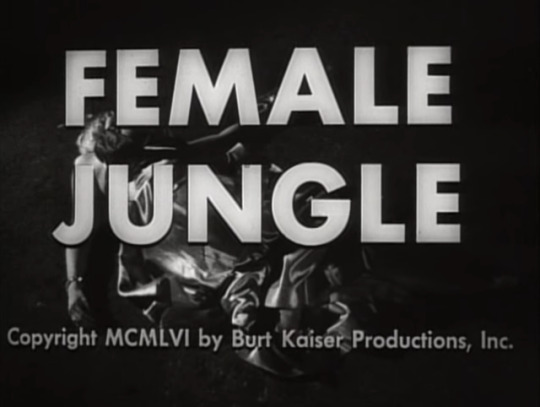
Female Jungle
This movie has serious MST3K cred. It’s got Kathleen Crowley from The Rebel Set, Jayne Mansfield from The Loves of Hercules (in her first screen role), Bruno VeSoto from Daddy-O, and John Carradine! It also has that old favourite, a misleading title. Just as The Undead had no zombies and Pod People had neither pods nor people, Female Jungle features not a single leather-clad woman swinging on a vine. Disappointing.
Rather than being a bad jungle adventure, Female Jungle is a bad noir mystery. Up-and-coming actress Monica Madison has been murdered in front of the sleazy Can-Can Club, while she should have been at a glitzy movie premiere. What was she doing there, and who killed her? Too bad off-duty detective Jack Stevens, who was in the area, was too falling-down drunk to remember what happened… or even whether he was the killer! In the attempt to clear his name, Stevens delves into the complicated relationships between Miss Madison, her publicist Almstead, a struggling artist named Al, and the women in Al’s life – including his wife Peggy and mistress Candy. It turns out there were a lot of people who might have a reason to kill Monica Madison… but the actual ending makes no damn sense at all.
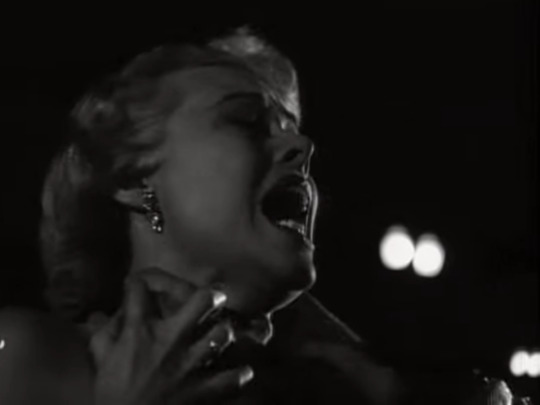
If Female Jungle had been on MST3K it would have belonged in the Joel era, because this movie is a fucking ordeal, right up there with garbage like Project Moon Base and Jungle Goddess. For starters, nothing happens. Theoretically this story involves exciting things like car chases, love affairs, jewel thefts, and drunken brawls, but we never see any of it, only hear about it in long, pointless conversations. Sometimes the long, pointless conversations turn into long, pointless arguments in which both parties seem to change their minds twice in five minutes. Sometimes the actors talk extra-fast, apparently in the effort to fit more talking into the available seventy minutes. The fact that a vital clue comes from a talk radio program is almost a joke, because even the people in the movie are doing nothing but listening to talking!
The only thing worse than a movie that’s ninety-five percent talking is one that’s ninety-five percent talking by people who can’t act. Nobody in this movie can act. Even John Carradine can barely act in this movie. Lawrence Tierney as Stevens isn’t even convincing as being tipsy, never mind so drunk he can’t figure out where he was for the last four hours. Burt Kaiser (also the writer and producer) as Al studiously avoids looking into the camera. Kathleen Crowley as Peggy spends much of the movie fake-crying. Jayne Mansfield as Candy looks like she has no idea how she sank this low, and this is her first film.

The direction is incredibly boring, featuring lots of static shots from way too far away, interspersed with bizarre intrusive close-ups on people who aren’t even participating in the conversation. Everything is under-lit (Tom Servo’s comment on The Giant Spider Invasion being ‘film extra-noir!’ comes to mind), which is particularly annoying during the rare scenes in which something is actually happening and you can’t fucking tell what it is. A lot of scenes that needed music don’t have any, and the ones that do have music play it way too loud, which makes for another unintentional joke when Peggy asks Almstead to turn it down.
The characters are to a man (and woman) drunk and terrible. There are bits where it looks like Al and Peggy might be about to reconcile, but we don’t want them to reconcile because Al is an abusive fuck. Stevens has a brief scene with Candy that makes it look like they’re romantically involved, but apparently they’re not, and then he yells at her. She goes running off to seek comfort from Al and he yells at her. Stevens threatens a suspect for insisting his lawyer be present for questioning, and then keeps barking questions at him until he breaks down. The only decent person in the entire cast is George the Can-Can Club janitor, and even he has his questionable moments when it looks like he might be protecting the killer.
In particular, the many loves of Al the artist are supposed to be very important, but we have no idea what any of these women see in him. He’s an unemployed drunk who cheats on his wife with a regular mistress, and cheats on that mistress with a third woman. All three seem to have tried to help him with his problems only to get it thrown back in their faces. He’s not wealthy, he’s not particularly good-looking, he’s only mildly talented, and he’s definitely not charming.
I guess the theme of Female Jungle is gratitude? Al wasn’t grateful for the love of the women in his life and abandoned them all one by one, while Monica wasn’t grateful to Almstead for making her a star. I would love to analyze this but I can’t. It’s there, but it’s not used in any way that would make it worth talking about.
While we have several potential villains in this story, finding a hero is more difficult. Any attempt at a plot summary will probably make it sound like it’s Stevens, but he’s not actually in the movie very much. When he is, he’s threatening women and suspects, yelling at his colleagues, and generally behaving like a thinner, better-dressed version of Mitchell. All the actual investigating and solving was done by Almstead, although while we’re actually watching him work it out we’re meant to think he’s the killer trying to cover his tracks. Why wasn’t this movie about Almstead?
Two reasons, actually. First, because he already knows what’s going on and the whole premise of this film seems to be that nobody knows what’s going on – especially the audience! And second, he’s John Carradine. Everybody knows John Carradine is the bad guy.
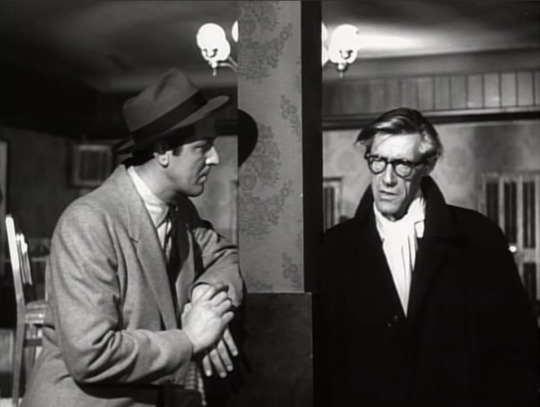
The final revelation of who killed Monica Madison is what feels like ten minutes of John Carradine telling a story that makes no damned sense. There was apparently a blackmail scheme involved but we never find out what it was about. By the end of a murder mystery we should have enough clues that the confession or explanation makes everything fall into place, but instead, here we’re just sitting there wondering what the fuck. Most of this was not at all foreshadowed and the parts that were don’t make any sense either – a major plot point turns on a stolen diamond necklace but we never find out why the culprit stole it. It feels like they made the whole movie up as they went along and the result desperately needs a guy and two robots at the bottom of it.
The biggest sin committed by Female Jungle is one I’ve gotten mad about before – it straight-up lies to the audience. Conventions of fiction vary from culture to culture but one of the assumptions we make here in the west is that characters in a movie do not know they’re in a movie and therefore cannot talk directly to the audience. Even Shakespeare’s asides follow this rule, in that Hamlet isn’t really supposed to be talking to the audience, but giving us a window on his inner monologue, and it can only be broken in very special circumstances. Bilbo Baggins told two different versions of his competition with Gollum, but Bilbo is explicitly the narrator even though his story is in the third person, so he knows he has an audience that he wants to look good for.
Female Jungle has no narrator, not even potentially. There is no one character whose story we’re following and who may therefore be said to be ‘telling’ it to us, as for example Chasen is telling us the story in Indestructible Man. The only possible candidate would be Stevens, but we’re often watching stuff he has no way to know or care about. Therefore nobody is aware there is an audience, and nobody should be able to lie to that audience. The killer breaks this rule, though, as he does things that make no sense once we know he is the killer. He does try to frame Almstead, but often in ways that seem directed at the audience rather than the cops. Murdering Candy serves no purpose except to say ‘surprise, this guy kills women!’
Between the darkness, the downright deceptive attempts at misdirection, and the fact that nobody’s decisions make any sense, Female Jungle reminds me very strongly of The Dead Talk Back. Female Jungle actually manages to be worse than that movie on several levels, but there is one mistake I’m glad they avoided. In The Dead Talk Back we got to know Renee a little, but only through a voice talking over shots of her changing her clothes. In Female Jungle we don’t actually meet Monica at all – she dies before the opening titles. This is, itself, not very good storytelling, but at least the movie doesn’t have an opportunity to sexualize her. We see a couple of photographs of her later, one of them a standard Hollywood head shot and the other a candid of her sitting at a nightclub table, but neither is intended to be sexy. One of Al’s artworks tries to depict her as a sexpot, but the emphasis of the piece is so obviously the plot point necklace that it ruins the effect.

Yeah, that’s my compliment for Female Jungle: it didn’t go out of its way to remind us that the victim made for an attractive corpse. I have seen way, way too many bad movies.
14 notes
·
View notes
Text
My Top 10 Favorite Albums of 2018
When it comes to music, ideas of "good" or "bad" or "best" are purely subjective. Frankly, it's ridiculous to suggest that any one person, or even any one group, has the authority to decide what the best albums of the year are, even if they did have the capacity to listen to every single release. But I love these kind of lists anyway because, at their best, they provide people the chance to gush about the music they loved in a year, the albums that challenged them, brought them joy, and helped reshape their lives. I don't necessarily think music should be ranked and judged, but it absolutely should be explored, examined, and shared.
The following is exactly that. These are my ten favorite albums of 2018, the ten albums I spent the most time with, got the most out of, and loved more than anything else released this year (that I had a chance to listen to, at least). If you've heard some of these albums before, I hope I can help you find something new to appreciate, or at least remind you why you liked them in the first place; if you haven't, then I hope you find a new song, band, or album here to love.
Let's get to it:
10. MXPX -- MXPX: There were a few really strong albums competing for this final slot, but MXPX took it through sheer consistency. Every single song on this album is just an incredibly solid block of pop-punk, bolstered by some fun, yet often unexpectedly mature, lyrics. Mike Herrera and the rest of MXPX look backwards and forward simultaneously, reminiscing about their childhood and long history as a band, but also sharing the lessons they've learned along the way; on album stand-out "Moments Like This," Herrera specifically confronts the legacy he's leaving his family, and it's surprisingly poignant. MXPX is a blueprint for how any pop-punk band can mature without losing that youthful spark that makes the genre so dang fun in the first place.
Highlights: Rolling Strong, The Way We Do, Moments Like This
9. Justin Courtney Pierre -- In The Drink: Two grueling years after the demise of Motion City Soundtrack (one of my Top Five favorite bands), former frontman Justin Courtney Pierre has returned with a solo album that manages to capture much of the spirit of MCS, but of course, with a more personal, intimate spin. Pierre still graces listeners with his intricate wordplay and earworm hooks, but also highlights some techniques and instruments that rarely took prominence in MCS (the bouncy bass in "Shoulder the Weight" is a personal favorite). In The Drink cuts right to the core of every song, especially in the exhilarating title track; the album is blistering, economical, and often ruthless, not just musically (only two songs clock in at over three minutes), but also lyrically, examining some surprisingly dark scenarios with the honesty and careful empathy fans have come to expect from Pierre. It's great to have him back (I still miss Jesse's MOOG, though).
Highlights: Anchor, Shoulder the Weight, In The Drink
8. Jeff Rosenstock -- Post-: The first album of 2018 (seriously -- Post- was a surprise release on 1/1/18) remained urgent, relevant, and relatable throughout the entire year -- that's not good for the world, but it's great for Post-. Jeff Rosenstock's social commentary is as sharp as ever, deftly mixing the political and the personal, especially in tracks like opener "USA," which dives head-first into the paranoia, apathy, and hypocrisy of modern American living. The frustration and hopelessness of trying to change a broken system coats this album like dew, but Rosenstock's approachable and energetic strain of punk make them seem manageable -- or at least bearable -- nonetheless, and closer "Let Them Win" provides much needed catharsis and hope; it's a rally cry for a better future. Post- wasn't necessarily the follow-up to Worry. that anyone expected, but it's certainly the one we needed, right when we needed it.
Highlights: Powerlessness, 9/10, Let Them Win
7. The Penske File -- Salvation: Out of all the albums on this list, Salvation by far was the biggest (and happiest) surprise. Having never heard of them before, I saw The Penske File open for (the irresistibly fun) PKEW PKEW PKEW back in October and was blown away by their harmonies, by Alex Standen's ability to balance drums and lead vocals at the same time, and most of all, by a song that dug its way into my head and wouldn't let go. That song turned out to be album stand-out "Spin My History" (easily one of my top favorite new songs of the year), and thankfully, all the best aspects of The Penske File's live show translated perfectly over to Salvation. The vocals are the perfect combination of intensity, melody, and harmony; the lyrics expertly capture and unpack moments in time; the music itself (especially when accompanied by harmonica, which pops up in a few songs) wonderfully reflects the mood of each song, be it the reckless abandon of "Lakeshore" or the aching nostalgia of "American Basements." Thanks to Salvation, I could easily see The Penske File following in the blue collar punk footsteps of bands like the Menzingers, and that's high praise indeed.
Highlights: Spin My History, Come What May, Blessed Unrest
6. Joyce Manor -- Million Dollars to Kill Me: Joyce Manor has never been a band content to make the same album twice, and Million Dollars to Kill Me not only continues the musical evolution that began on 2016's Cody, but manages to run an entire musical gamut in under 25 minutes. Million Dollars to Kill Me shows off Joyce Manor's impressive range, leaping from something approaching hardcore ("Up The Punks") to shoegaze ("Gone Tomorrow") to ballads ("I'm Not the One") to even doo wop ("Silly Games"); lead singer Barry Johnson likewise moves between the frenetic, frantic yowls of "Up The Punks" or "Big Lie" to the gentle, sing-songy joy of "Wildflowers," revealing new facets to his voice and thus finding new notes for Joyce Manor to hit. Underneath it all, though, lies some wonderfully classic emo, with Johnson channeling intelligent, introspective, and bittersweet lyrics into each and every track. Not every song on Million Dollars to Kill Me is going to work for every listener, but every single one of them is guaranteed to leave an impression.
Highlights: Big Lie, Million Dollars to Kill Me, Wildflowers
5. Bad Moves -- Tell No One: On first listen, it might be Tell No One's flawless harmonies that most catch your attention, or perhaps the bouncy, infectious melodies of its early tracks. Spend some time with it, though, and Tell No One has so much more to offer. Bad Moves makes some truly ambitious musical leaps here, especially on tracks like "Out of Reach," whose bridge and outro layers several different, contrasting harmonies over a darkly ominous riff; it's the musical equivalent of standing at the edge of a hurricane, and it's exhilarating. Ultimately, though, it may be Tell No One's lyrics that leave the greatest impression. Bad Moves creates anthems for those on the outskirts of society; Tell No One features songs about dealing with disappointing your family, forbidden romances, dark family secrets, growing up queer, facing police harassment, and the toll hiding parts of yourself can take on you, but also some uplifting tracks about using everything you've got to make life better for everyone around you. There's albums I liked more this year, but I don't think there's any lyrics that hit home for me harder than the ones on Tell No One.
Highlights: Spirit FM, Out of Reach, Missing You
4. The Get Up Kids -- Kicker: Kicker is the Get Up Kids record I've wanted for more than a decade now; it's a band recapturing lightning in a bottle. The first three tracks channel the pop-punk glory of the Red Letter Day/Something to Write Home About era without copying it wholesale (there's a rawness to the guitars and Matt Pryor's voice that was absent on those releases; it's very rock and roll), and the lyrics take that trademark Get Up Kids earnestness and update it for 2018, with Pryor and Jim Suptic tackling topics like regret, responsibility, and family with the same honesty and emotional intensity they once saved for tales of adolescent love and heartbreak. And then comes the closer, "My Own Reflection," which sounds like nothing the Get Up Kids have ever done before, a track driven by one of James Dewees' best synth-lines, some propulsive drums, and a striking, surprising bit of profanity. It's somehow upbeat and downbeat simultaneously, totally bittersweet, and thus emo in a nutshell, while also transcending so many of the genre's (and this band's) most common cliches; if these four songs are the future of the Get Up Kids, then it's a bright one indeed. The main reason Kicker isn't ranked higher on this list is because it's an EP rather than a full record (it's harder to keep this level of quality up for 12 tracks instead of 4), but let's not mince words: every single song on this EP is perfect.
Highlight: My Own Reflection
3. Save Face -- Merci: Merci would be ambitious even if it wasn't Save Face's debut release -- it's a concept album about addiction and the way it can destroy lives and relationships, accompanied by music videos for each and every track, linking together to form a visual novel of sorts. What's even more impressive than all that ambition, though, is the fact that it all works -- the overall concept forms a compelling narrative on its own, but should still resonate with anyone who's dealt with addiction or mental illness, with heartbreak and loss, with self-hatred or self-destructive habits. All those ideas are packaged within some truly explosive tunes -- Save Face's riffs are so big it's a wonder they can even be contained within the record, and singer Tyler Povanda's voice cracks with passion and mania, accompanied by some cathartic, soul-piercing screams, yet Povanda also has the range to capture the smaller, more nuanced emotions beneath all the outsized drama. The simple melodies reveal more and more layers the more you listen to them, creating a record I've returned to over and over, consistently, throughout 2018. Merci is almost as addictive as the substances its songs highlights, although in this case, that's a feature, not a bug.
Highlights: Bad, Plans, Love
2. Saves the Day -- 9: There's a line from their song "It's Such a Beautiful World" that sums up both Saves the Day and their newest album, 9, perfectly: "Let them say what they say/we're gonna play what we play." That instinct has proven polarizing at times, but as an absolute Saves the Day fanatic, I've always found it a joy and privilege to join the band as they follow their muse, and thankfully, 9 is no exception. 9 is an investigation and celebration of Saves the Day's history and legacy; some listeners have criticized this as being self-indulgent, but Saves the Day has always been a band that's channeled very specific scenarios into relatable and cathartic emotion, and at its best, 9 does just that, from the power and joy of friendship ("Side By Side") to nostalgia and the way our experiences help us change and grow ("Rendezvous"), all of it wrapped up in the power music has to bring people together (and if that last point's not something you can appreciate, then I'm not sure how you even found this list). Meanwhile, "Rosé'" provides a classic Saves the Day diss track that wouldn't feel that out of place on Stay What You Are, while the 22 minute "29" transforms frontman Chris Conley's entire life story into a sprawling epic that needs to be heard to believed. 9 also provides an opportunity for each and every member of the band to show off; lead guitarist Arun Bali continues to highlight his ability to shred in increasingly cool and unique ways, Rodrigo Palma sneaks fun bass flourishes into every song, absolutely taking charge of "1997," and Conley stretches his voice to unexpected heights, be it the yowls of "Side By Side" or the falsetto of "Saves the Day." Hell, they even kick 9 off by writing their own theme song. If you can't appreciate that, this probably isn't the album for you, but man, that is my exact kind of jam.
Highlights: Side By Side, Rosé, 29
1. The Wonder Years -- Sister Cities: I can't remember the last time I've seen an album become an essential part of a band's canon as fast as Sister Cities has, especially considering how far The Wonder Years are into their career at this point. Sister Cities is undeniably a Wonder Years album despite sounding almost nothing like what's come before, and in large part, that's due to Dan Campbell's sheer skill as a storyteller. The songs on Sister Cities pick up the ideas of compassion, connectivity, and home introduced on previous albums and take them global; Campbell discovers the similarities between his relationship and the relationship of a homeless couple despite all their differences, finds a lifeline from his overwhelming grief half a world away, and just overall finds power in exploring what holds us together as human beings rather than what splits us apart. Even the music videos tap hard into these ideas; last winter I wrote about how the video for "Sister Cities" finds power in connection, and its follow up, "Raining in Kyoto," expands upon this by cutting back and forth between life in Kyoto and Philadelphia, showing how, no matter where you go, people are just trying to live their lives the best they can. Lyrically, Campbell just keeps getting better and better, creating vivid metaphors and word pictures and finding perfect turns of phrases; he's straight-up the best in the biz at knowing just when and how to use profanity to the maximum effect (seriously, nobody else should be allowed to use the word "goddamn" in a song until they can do it even half as well as Campbell does in "Pyramids of Salt" or "Flowers Where Your Face Should Be"). Musically, Sister Cities takes big risks, and finds success, in going small more often than not, but reaches its greatest heights in closer "The Ocean Grew Hands To Hold Me," a song that just builds and builds until it reaches this epic swell of pure catharsis that just washes over you like the ocean. Honestly, Sister Cities is so emotional that it can sometimes be hard to listen to. That kind of power is that makes it my favorite album of 2018.
Highlights: Sister Cities, Flowers Where Your Face Should Be, The Ocean Grew Hands To Hold Me
#The Wonder Years#Joyce Manor#Jeff Rosenstock#Saves the Day#Saves Face#Bad Moves#MXPX#The Get Up Kids#Justin Courtney Pierre#The Penske File#Pivitor#music
8 notes
·
View notes
Text
K.O. KITTY
“The Westinghouse Desilu Playhouse” ~ November 17, 1958
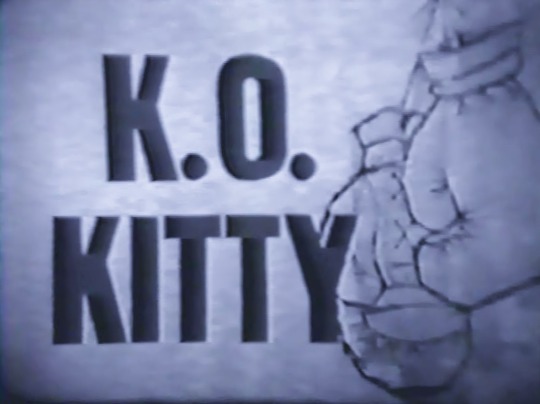
Produced by Bert Granet, Quinn Martin
Directed by Jerry Thorpe
Dances and Fights staged by Jack Baker
Written by Bob Carroll, Madelyn Davis, Quinn Martin (story)
Synopsis: Los Angeles dance teacher Kitty (Lucille Ball) is delighted when she learns that she has inherited a boxer from her late Uncle Charlie. But the boxer turns out not to be a canine, but a prize fighter named Harold Tibbetts (Aldo Ray), a muscle-bound country boy.
Cast
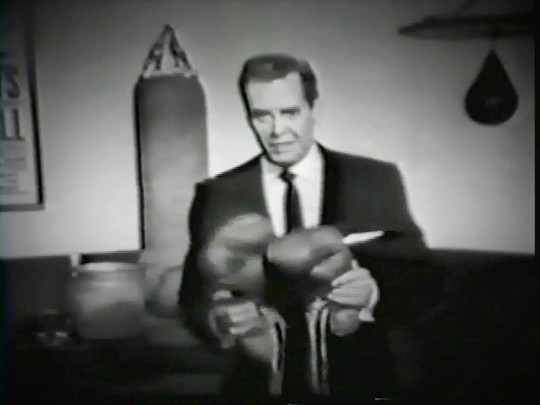
Desi Arnaz (Himself, Host) was born in Cuba in 1917 and immigrated to America as a youngster. He was a musician who married Lucille Ball in 1940 after meeting her on the set of 1939’s Too Many Girls, which he had done on stage in New York. In order to keep him ‘off the road’ Ball convinced producers to cast him as her husband in a new television project based on her radio show “My Favorite Husband.” The network was convinced. In 1951, Arnaz and Ball began playing Lucy and Ricky Ricardo, roles they would be identified with for the rest of their lives. The couple had two children together, Lucie and Desi Jr. In 1960, Ball and Arnaz divorced. Desi became a producer, responsible for such hits as “The Mothers-in-Law” (1967-69). He re-married in 1963. Desi Aranz died in 1986, just a few years before Ball.
Lucille Ball (Kitty Winslow) was born on August 6, 1911 in Jamestown, New York. She began her screen career in 1933 and was known in Hollywood as ‘Queen of the B’s’ due to her many appearances in ‘B’ movies. With Richard Denning, she starred in a radio program titled “My Favorite Husband” which eventually led to the creation of “I Love Lucy,” a television situation comedy in which she co-starred with her real-life husband, Latin bandleader Desi Arnaz. The program was phenomenally successful, allowing the couple to purchase what was once RKO Studios, re-naming it Desilu. When the show ended in 1960 (in an hour-long format known as “The Lucy-Desi Comedy Hour”) so did Lucy and Desi’s marriage. In 1962, hoping to keep Desilu financially solvent, Lucy returned to the sitcom format with “The Lucy Show,” which lasted six seasons. She followed that with a similar sitcom “Here’s Lucy” co-starring with her real-life children, Lucie and Desi Jr., as well as Gale Gordon, who had joined the cast of “The Lucy Show” during season two. Before her death in April 1989, Lucy made one more attempt at a sitcom with “Life With Lucy,” also with Gordon, which was not a success and was canceled after just 13 episodes.
Most sources list Kitty's surname as ‘Williams.’ Her last name is clearly spoken twice in the teleplay as ‘Winslow.’
Aldo Ray (Harold Tibbetts, below center) was born as Aldo DeRe and nicknamed 'the Rugged Romeo'. In 1964 he worked again with Lucille Ball in Bob Hope's “Have Girls, Will Travel” (1964). His career waned in the 1970s. He died in 1991.
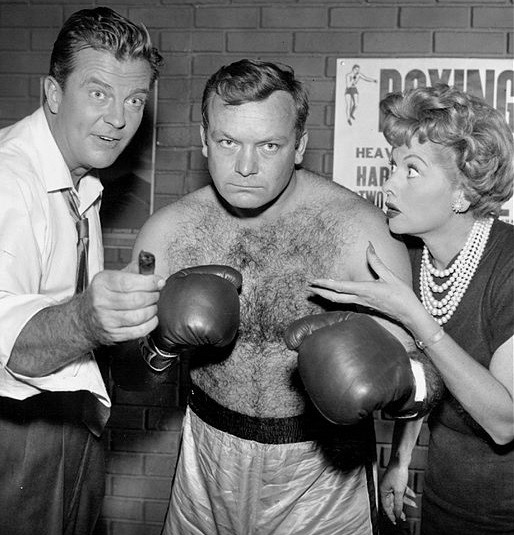
William Lundigan (David Pierce, above left) was a genial 'B' movie and TV actor. His career began in 1937. His last television role was in 1971. He was a good friend of William Frawley (Fred Mertz) and served as pallbearer at his funeral. Lundigan died in 1975.
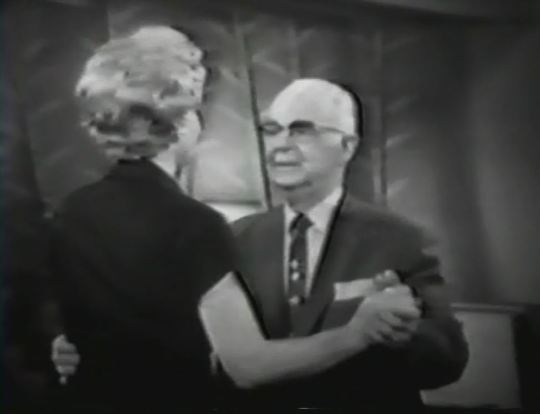
Harry Cheshire (Mr. Brubaker) did three films with Lucille Ball between 1947 and 1950. He played Sam Johnson, a Texan who sells Lucy and Ricky “Oil Wells” (ILL S3;E18) in 1954. His best-known role was as Judge Ben Wiley in the TV series “Buffalo Bill, Jr.” (1955). He died in 1968 at the age of 76.
Jesse White (Barney Snyder, below right) is probably best remembered for playing the lonely Maytag repairman on TV commercials airing from 1967 to 1988. A busy character actor, White subsequently starred opposite Lucille Ball on a 1972 episode of “Here's Lucy.” He died in 1997.
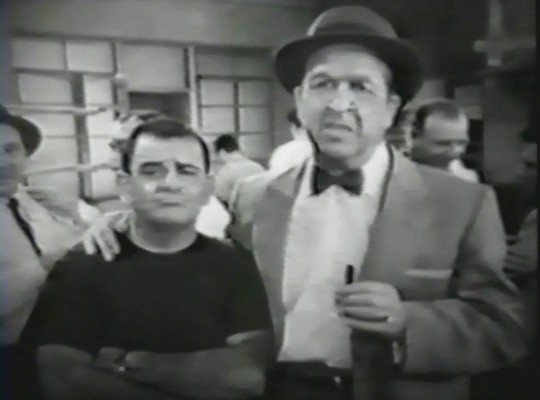
Sid Melton (Louie, above left) also appeared on the “Westinghouse Desilu Playhouse” as a bellboy in “Lucy Goes to Alaska” (February 1959) and as a construction worker in “Milton Berle Hides Out at the Ricardos” (September 1959). He played one of the jockeys in “Lucy Wins a Racehorse” (February 1958). He later played Charley Halper on "Make Room For Daddy” (filmed at Desilu) and Alf Monroe on "Green Acres” (aired on CBS).
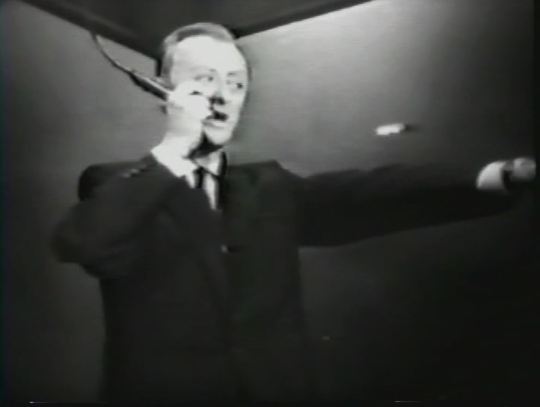
Frankie Van (Himself, Referee) was a stand-in and background performer whose more than 50 credits are nearly all as referees in films and television shows about boxing. Fittingly, his last screen credit was as a referee in Rocky (1976).
In this script, Van is called by his real name.
Freddie Beshore (Tommy Thompson, uncredited) picked up boxing while serving in the United States Navy during World War II. During his career he was the Heavyweight Champion of the Pacific Coast. During the late 1940s and early 1950s he was a top heavyweight title contender.
Norman Leavitt (Policeman, uncredited) appeared with Lucille Ball in the 1950 film A Woman of Distinction as well as The Long, Long Trailer (1953). The character actor also appeared on three episodes of “The Lucy-Desi Comedy Hour” and two episodes of “The Lucy Show.”
About “The Westinghouse Desilu Playhouse”
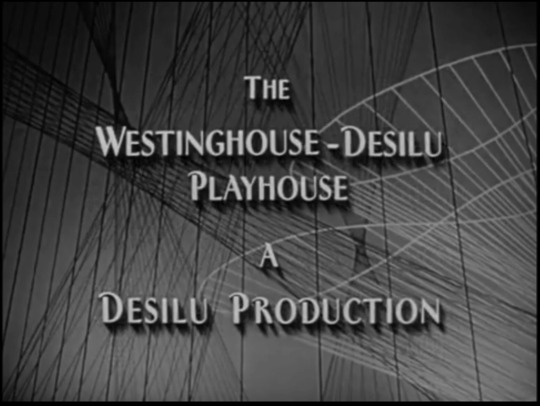
After the end of the half-hour “I Love Lucy” episodes, Desi Arnaz convinced CBS to purchase an anthology series titled “Desilu Playhouse” which would feature different hour-long dramas every week along with monthly stories of the Ricardos and the Mertzes, something begun a year before.
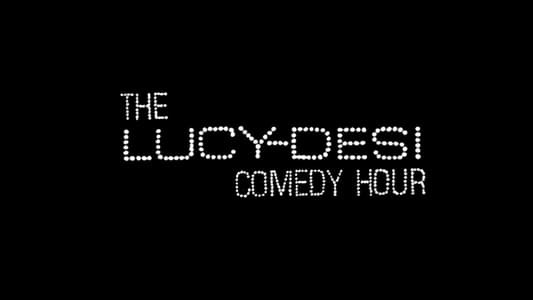
Thirteen hour-long “I Love Lucy” adventures were eventually made and sold to syndication as “The Lucy-Desi Comedy Hour,” ten of which were produced under the Westinghouse sponsorship. The appliance company paid a then-record 12 million dollars to sponsor the show.
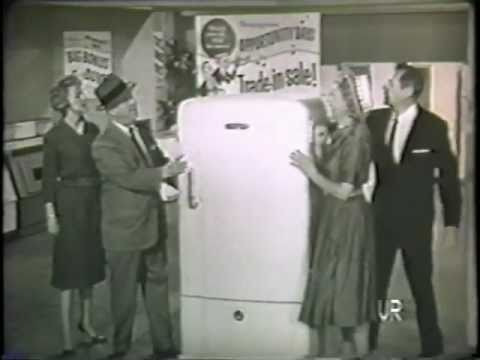
Desi Arnaz hosted the show and introduced the stories. Desi, Lucy, Vivian Vance, and William Frawley, were often involved in the lengthy studio-filmed commercials, with Betty Furness spokesperson for the Westinghouse products. Although it wasn't around long, the show gave birth to pilots for “The Untouchables” and “The Twilight Zone.”

In the summer of 1958, in anticipation of their partnership, the cast of “I Love Lucy” played themselves in an industrial film (known as “Lucy Buys Westinghouse”) that toured the Desilu Studios, promoted “Lucy Goes to Mexico”, and highlighted Westinghouse appliances. The film was never in theatrical release or broadcast, but only shown Westinghouse dealers and corporate clients.
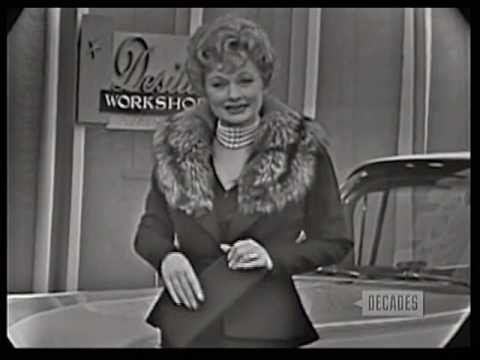
The Desilu Playhouse was also an actual little theatre on the Desilu backlot which hosted classes for actors and put on workshop shows for agents and industry insiders. When Lucille Ball joined RKO in the 1930s, the program was headed by Ginger Rogers' mother, Lela. Lucy wanted to continue the tradition. It was depicted in both “The Desilu Revue” (December 25, 1959) and “Hedda Hopper's Hollywood” (January 10, 1960).
About “K.O. Kitty”
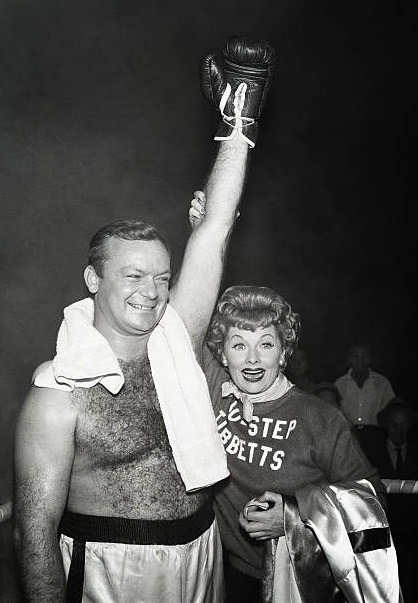
In the title, “K.O” is boxing term short for “Knock Out,” when a fighter has hit his opponent so hard that he hits the mat and cannot get up again.
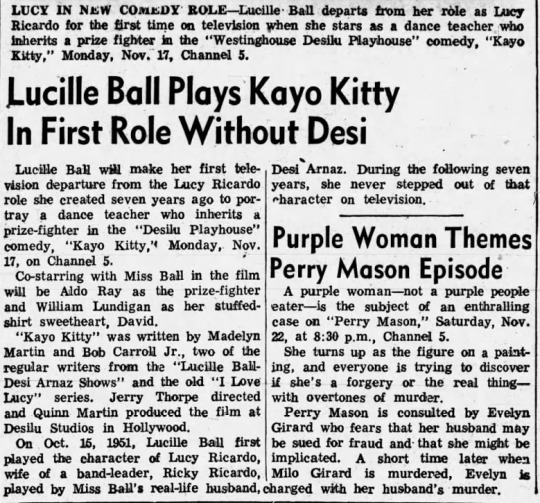
This is the first time that Lucille Ball acted on television not playing Lucy Ricardo. Lucille Ball was supposed to do several more non-Lucy Ricardo roles on the series, but this was the only one that ever materialized. The series ended in 1960, along with the Arnaz marriage. “The Desilu Playhouse” went into syndication, minus the Lucy-Desi Comedy Hours. In 1962, Desilu sold those 13 shows back to CBS for $750,000.
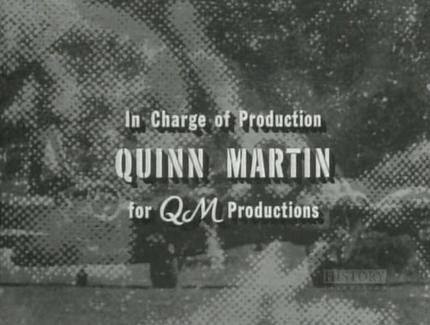
Quinn Martin (Producer / Story) was married to “Lucy” writer Madelyn Pugh Davis from 1955 to 1960. His production company was later responsible for such hits as “The Streets of San Francisco” (1972-77), “The Fugitive” (1963-67), and “Barnaby Jones” (1973-78) earning him four Emmy nominations. He also produced nine other episodes of “The Westinghouse Desilu Playhouse.”
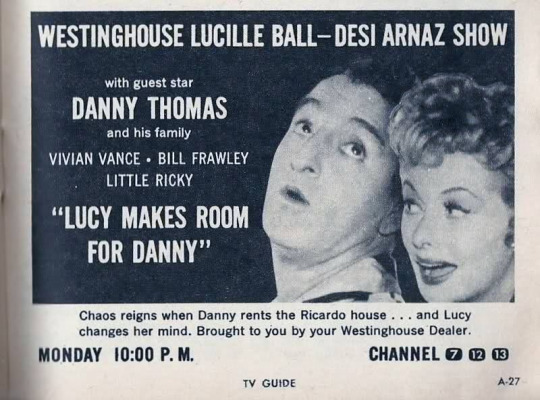
Like “I Love Lucy” and “The Lucy-Desi Comedy Hour,” the episode uses a laugh track. Unlike most of those shows, there was no studio audience. “K.O. Kitty” followed “Lucy Goes to Mexico” (October) and was followed by “Lucy Makes Room for Danny” (December), a cross-over episode with “Make Room for Daddy.”
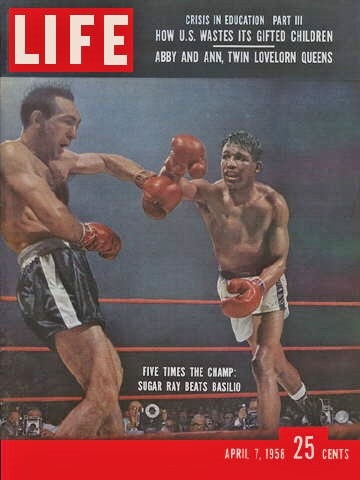
Earlier in 1958, boxing made the cover of Life Magazine when Sugar Ray Leonard beat Carmen Basilio.
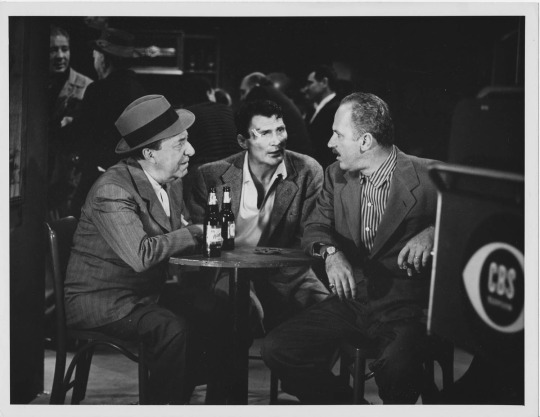
Boxing had been a major attraction on television, the highlight being the “Playhouse 90” presentation of “Requiem for a Heavyweight” in 1956 on CBS. It was directed by Rod Serling (”The Twilight Zone”) and starred Jack Palance.

A country boy out of his element, Harold Tibbetts (Aldo Ray) is reminiscent of when Tennessee Ernie Ford visited the Ricardos on “I Love Lucy.” Like Cousin Ernie, Harold has an enormous appetite and can't return home because he has no money. He also tends to speak with homespun wit.
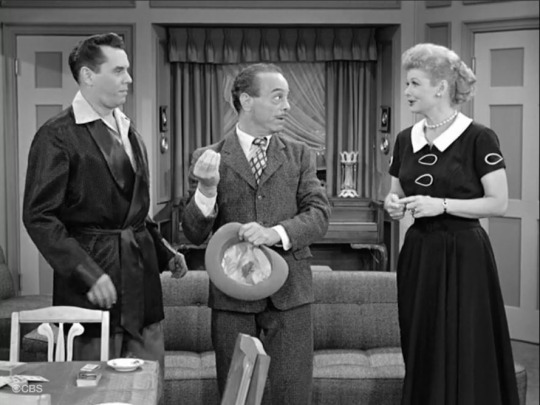
Harold also resembles another visitor to the Ricardo apartment, Mario (Jay Novello), the “Visitor From Italy” (ILL S6;E5). Like Harold, Mario had no cash to and had to go to work – in his case making pizza.
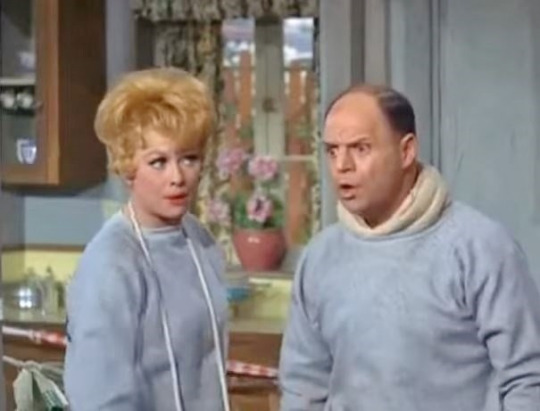
But “K.O. Kitty” most closely resembles a 1967 episode of “The Lucy Show” titled “Lucy, the Fight Manager” (TLS S5;E20) starring Don Rickles as a washed-up boxer named Eddie who Lucy Carmichael decides to train at home. Lucy dubs herself 'Killer Carmichael' and even jumps rope in tandem with Eddie, a stunt she learned to do for “K.O. Kitty.” Despite being by different writers, both scripts contain characters named Louie.
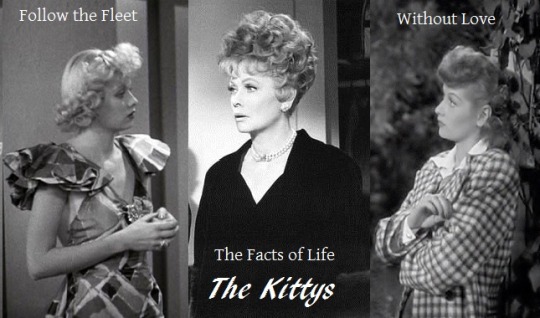
Lucille Ball also played characters named Kitty in the films Follow the Fleet (1936), Without Love (1945), and The Facts of Life (1960). A name featuring two-syllables ending with 'y' made reminded the listener of 'Lucy'.
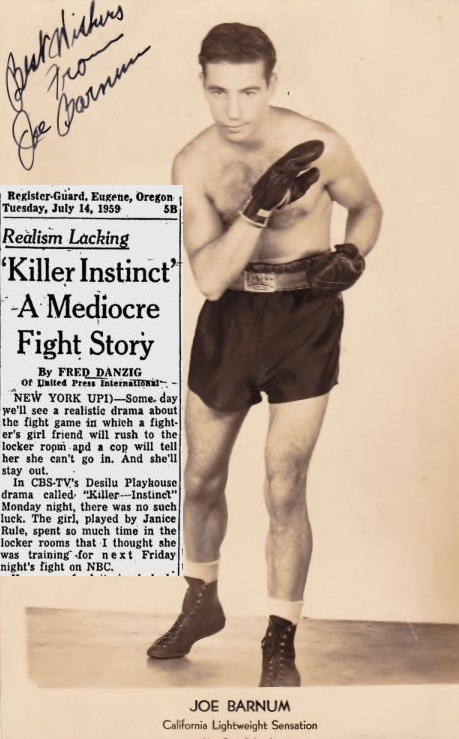
Eight months later “The Westinghouse Desilu Playhouse” did another story about prizefighting titled “The Killer Instinct” starring Rory Calhoun and Janice Rule. It was based on the career of ex-boxer Joe Barnum.
The Episode
Desi Arnaz introduces the program, noting that it is a special episode because it stars “his favorite redhead” Lucille Ball.
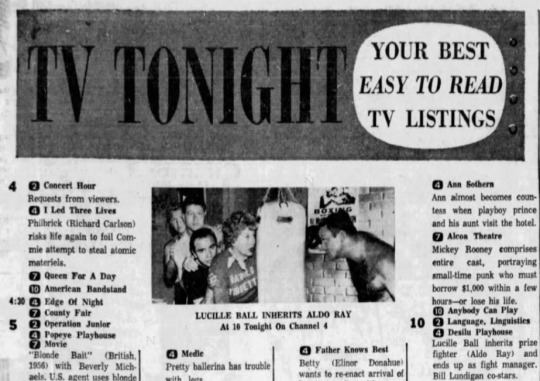
The story opens with Kitty at work, teaching dance. She is trying to get Mr. Brubaker (Harry Cheshire) to do the Cha-Cha.
Kitty: “Your feet are doing the cha-cha-cha but your hips are back in the rumba class.”

During the dance lesson, we learn that Kitty is engaged to an up-and-coming lawyer named David (William Lundigan) who won't marry her until he gets a partnership in his law firm, Abbott Parker and Jones. She tells Mr. Brubaker that he is dancing with an 'heiress' due to her Uncle Charlie dying and leaving her a diamond stick-pin, a gold pocket watch, and a dog – a boxer, to be precise.
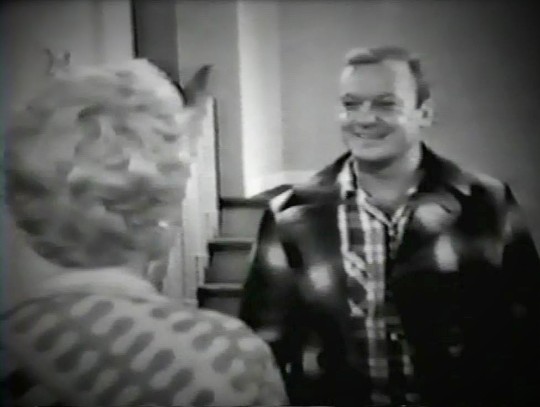
David (William Lundigan) tells Kitty he is going away on a business trip to San Francisco for a week. During their romantic dinner, there is a knock on the door and the boxer arrives – Harold Tibbetts, professional prize fighter. Tibbetts admits he's not really from Ogalala, Nebraska, but from Crockett – just “a hoot and holler” away.
Harold: “I'm so hungry, my stomach's a-growlin' like hound dog's just smelled a weasel in a hen house.”
Overcome with a sense of loyalty to her Uncle Charlie, Kitty agrees to manage Harold. She arranges for Harold to fight the impressive Tommy Thompson, a powerhouse that no one wants to go up against. Kitty cannot afford the gym fees so trains him at her apartment.
The name Tommy Thompson was also the name of a producer who worked extensively with Lucille Ball starting in 1964. In 1958 he was on the Desilu lot working as assistant director on “The Danny Thomas Show”
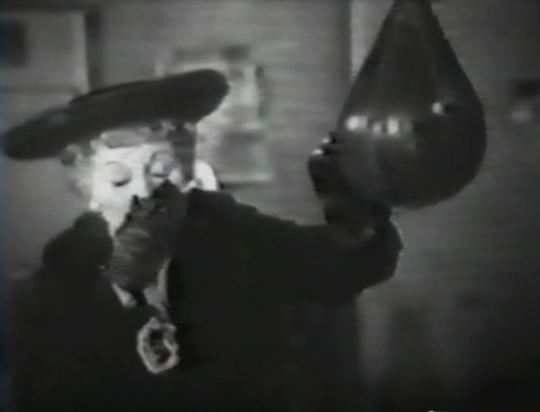
Kitty sends Harold off to the store to buy training supplies while she stays behind at the gym to observe and pick up some pointers on boxing. First, she indulges in a little shadow boxing. Next she tries to use a punching bag, but it punches back – right in her face. Remembering how to jump rope from her childhood, she jumps into a boxer's reps keeping time with a schoolyard rhyme. These are all prime opportunities for Lucille Ball to indulge in some of her well-hone physical comedy skills.
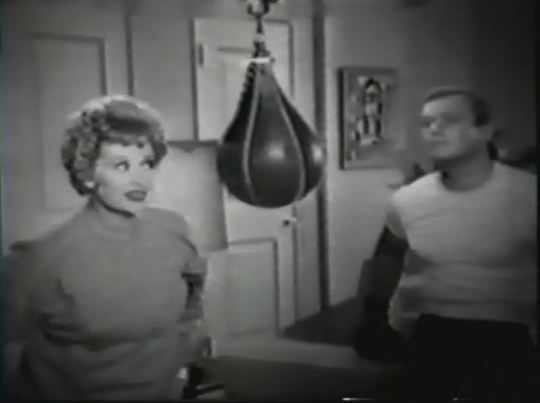
Back at the apartment, there is a montage of scenes of Kitty training Harold. He knocks the punching bag out the window, shatters a mirror while shadow boxing, and crashes to the floor while jumping rope. Kitty decides that the best training for klutzy Harold would be dancing lessons.
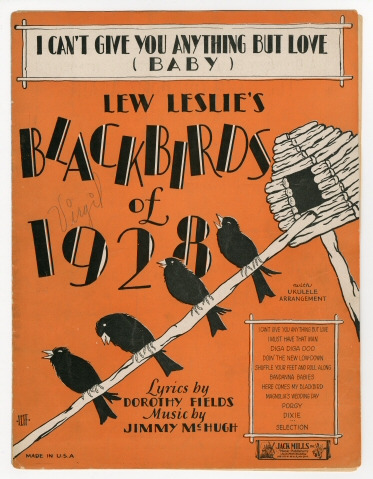
They begin lessons by dancing to “I Can't Give You Anything But Love, Baby” by Jimmy McHugh and Dorothy Fields. The song was introduced on Broadway in Blackbirds of 1928.
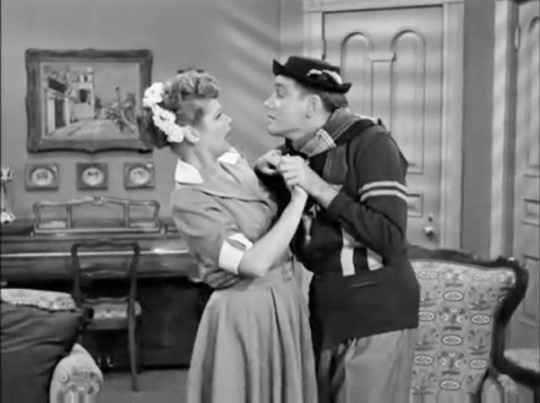
The dance lesson scene is nearly identical to when Lucy Ricardo taught awkward Arthur Morton (Richard Crenna) to dance in “The Young Fans” (ILL S1;E20) in 1952.
David returns unexpectedly from San Francisco to find Kitty and Harold in a carefree clinch. Kitty attempts to explain what is going on but it devolves into an argument and David storms out.

Using Kitty's dance steps and her singing “I Can't Give You Anything But Love” from ringside as inspiration, Harold surprisingly wins his bout against Tommy Thompson.

He then wins a second fight.

And a third!
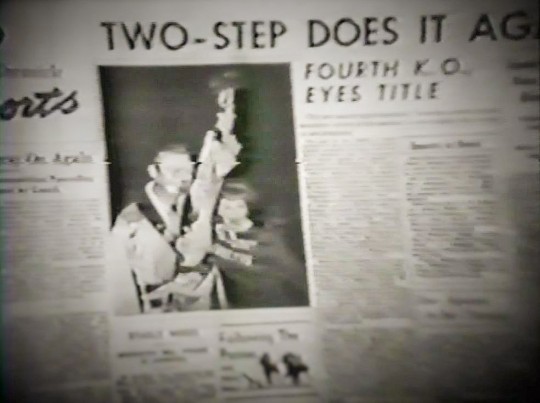
With a fourth K.O. under his belt thanks to Kitty, he eyes the title!
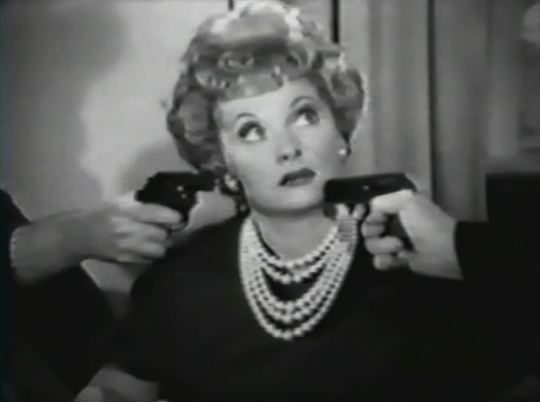
Barney Snyder (Jesse White) and David conspire to get Kitty out of the fight game – for both their sake. Snyder and Louie (Sid Melton) show up at Kitty's apartment, guns drawn, to convince Lucy that they are crooks, and that the fight is fixed.
Meanwhile, back at the gym, 'Two Step Tibbetts' (as he's now called) is waiting for Kitty to arrive knowing he can't win the fight without her singing ringside while he spars. David arrives to tell Harold the bad news that Kitty will be detained. He learns from Harold that earlier that day they decided that this would be his last fight. David offers to sing instead of Kitty, but Harold can't remember the name of the song – except that the word 'love' was in the title.

Still at gunpoint, Kitty watches the match from home on TV. When Barney and Louis become engrossed in the fight, Kitty hides in the closet. This is very reminiscent of “Ricky and Fred are TV Fans” (ILL S2;E30) where Lucy and Ethel manage to evade the police when they can't take their eyes off a televised boxing match.
Meanwhile, back at the ring, Harold is taking a beating while David rattles off the title of every 'love' song he can think of, including a few bars of “I Love You Truly,” a traditional wedding song.
Barney and Louis confess to Kitty that they made up their story about being mobsters. Their guns are actually cigarette lighters! They spill the beans to Kitty about their plans. In order to get to the stadium as fast as possible, Kitty pretends she's going to have a baby and gets a police escort. Kitty and David rush to the ringside in time to sing the song, which everyone in the stadium joins in. At the final moment, Harold lands a knock out punch and wins the fight. David and Kitty make-up with a kiss as the program ends.
Ringside With Lucy
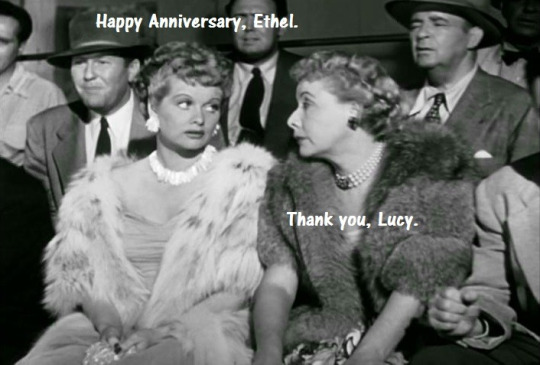
Lucy Ricardo and Ethel Mertz ended up at the fights in the last scene of 1951’s “The Girls Want to Go to a Nightclub” (ILL S1;E1), the very first “I Love Lucy” episode ever aired.
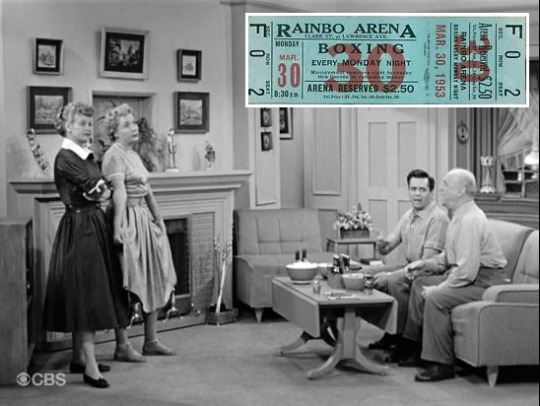
Everyone but Lucy and Ethel seem to be watching the fights on television in “Ricky and Fred are TV Fans” (ILL S2;E30).
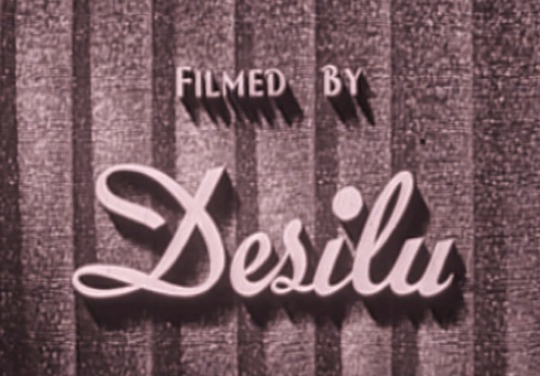
This Date in Lucy History ~ November 17
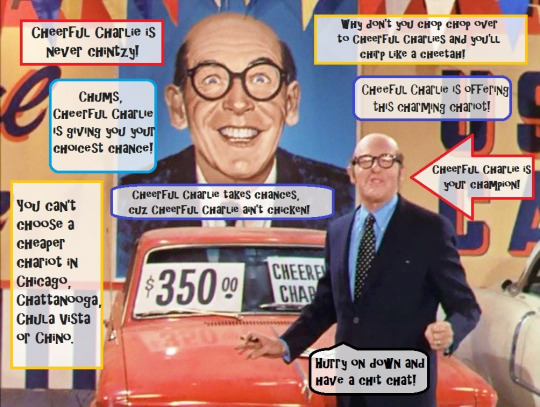
"Lucy and the Used Car Dealer" (HL S2;E9) ~ November 17, 1969
#K.O. Kitty#Lucille Ball#The Westinghouse Desilu Playhouse#Westinghouse#Desilu#Boxing#Aldo Ray#William Lundigan#Desi Arnaz#Bert Granet#Quinn Martin#Jack Baker#Jerry Thorpe#Bob Carroll#Madelyn Davis#Harry Cheshire#Sid Melton#Jesse White#Frankie Van#Freddie Beshore#Norman Leavitt#1958#CBS#TV#Don Rickles#The Lucy Show#I Love Lucy#The Lucy-Desi Comedy Hour#The Killer Instinct#Life Magazine
4 notes
·
View notes
Text
No Title yet
(Hello all! A little backstory: I have written a few web novels under different pen names, however, its always been half baked and i rarely finished any. This story, is one that I felt truly had some potential and has motivated me to give it my all. I wanted to share with as many people as I possibly could. Right now i'm still in the development process of it however i want to make a spin on how web novels are made. I want to post Chapters as I write them. Not like traditional ones that release volumes at a time with multiple chapters. I still don't have a tittle for the Web novel however I am very open for suggestions. Right now I have the Prologue and It is what I am going to be sharing here. I really hope you enjoy my small world i'm creating. )
Everything changed
Everything changed after the great hero died. He didn’t die from battle, he survived and lived a long life. While the hero was alive, life was good, the battle was won, our country received winners benefits for years to come and crime in the city was non existent. Petty thieves here and there but no real crime at least. The king was benevolent and gave all of the citizens their fair share of the spoils of war, took in refugees from the other countries, treated them how he treats his citizens with kindness and sympathy. A great king with the wisdom that could surpass the gods and the leadership that could unite all of the world one day.
“...Acceptable..take..a .. seat…”
The voice came from the magical circle next to the black board on the wall. I sat back down after answering the guidance question. We were 20 in the room plus ten guards. The walls were all grey with nothing to adorn them. All of the studentswere sat down neatly organized in four lines, everyone was sitting the same way. Back straight, head held high, legs closed and both arms resting on the desk, everyone’s expressions were blank whenever we came into this room. Our arm position was important today, in the top right corner of the black board were the words “Blunt” above a sketch of the human anatomy with a circle on the right forearm.
One more hour until we can leave this room.
I always kept the track of how long we’ve been in the room, there are no clocks to tell the time but with practice you can tell how long it has been. Just as I was finishing my guess the door opened. The guards shifted slightly to let whoever opened the door in. If this creature were to show its face to the general public it would cause mass panic and create unrest within the people. This creature was reptilian, its hind legs were slightly larger than his arms however you couldn’t tell because its muscles were very defined. While it walked on four legs its stature was that of a 3 foot child. The reptile was wearing a black shirt and a jacket without sleeves that had frills on the collars. At the front of the students, there was a large desk, nothing was adorning this desk however, the top had many scratches, dents and dried blood.
Once the reptile arrived in front of the desk the guards closed the door. Everyone’s expression was still blank and our gazes were looking forward at all times. The reptile stood up, its head was almost reaching the ceiling. The reptiles eyes shifted from left to right scanning all of the students. The reptile had a piercing gaze that would nearly petrify even the most veteran of warriors in the kingdom.
“Ahem, the next question is for Sato Ryoga.”
Thank the gods its not me.
The boy that stood up had short spiked blonde hair, he looks are average and his body looks very frail like a porcelain doll. I’ve known him for a few weeks, he used to talk a lot about his pet he had before becoming an orphan. Now a days he doesn’t talk much.
“ What state of a battle is more dangerous for the morale of its troops?
“ The death of its front lines!”
Completely wrong you Idiot.
The reptile squinted its eyes as it stared at Sato. The answer was so wrong that you could feel the murderous intent of the mammoth of a reptile that stood in front of us. The reptile stood still as the blue magic circle glowed. It was as if the reptile was waiting for the circle to speak before he took any action or moved on to another question.
“Un..Acceptable… take.. a...seat..”
Sato’s expression was still blank, however we could feel an aura of fear and panic. The reptile looked at one of the guards and gave him a quick nod. We all were still staring forward but we knew that the guard was smiling from ear to ear. He took a few steps forward and made his way to Sato’s seat. He stopped to Sato’s right side and took his baton out, normal batons were preferable, this baton looked twice as girthy and significantly more durable.
I hate this part
Crack.
The sound the baton made when it struck Sato’s right forearm was deafening, you could tell he didn’t hold back, they never do. Sato’s scream followed shortly. His forearm was crushed with the massive force that the guard swung at this young child’s arm. His fingers curled up the bone was clearly broken, his radial bone was sticking out slightly his deathly thin arms left nothing up for the imagination of what happened inside of his body.
The pain must have been too great for him.
The guard was smiling so much he started foaming at the mouth slightly, if you listened close enough you could probably hear him chuckling as he towered over what he had just done. Our expressions were still blank staring forward trying our best to ignore the shriek of pain that Sato was expressing. Luckly, my seat was two seats diagonally in front of him so I couldn’t see what happened to his forearm first hand.
The reptile was still staring at Sato as he was writhing in pain in his seat. “SILENCE”. Sato immediately suppressed his screaming however, his heavy breathing was still very audiable.
“Although the answer may have been correct under certain circumstances, there are more dangerous states on which a battle can affect the morale of its troops. Shizume! What is the answer?”
She stood up, her hair was beautifully black, her eyes were a gorgeous emerald color giving contrast to her face. I have known her for a few months, she was one of the few remaining survivors from the batch that arrived with her.
It’s like she was pulled off from the greatest piece of art in the world.
Everytime I had the chance to steal a glance at her I would. Without delay she answered, I was deathly afraid of her answer. I bet that we all felt the same way.
“ Although, there are many factors that affect the battlefield. The most dangerous stage for troops morale is nearing the final stage of a deciding battle when the commander’s life is in danger.”
We all felt like holding our breath for the mysterious voice to acknowledge her answer. The reptile’s eyes did not show any signs of her answer being wrong in its eyes. However, you could never know if the circle would accept it. There’s been many instances where his expressions did not match whether the answer was right or wrong. A few minutes went by, not a single sound was made the whole time. The loudest sound could be made if you drop a pin needle at the ground. The circle suddenly lit up, glowing as it always has before it gave a verdict.
“Acceptable..take..a...seat…”
Shizume bowed her head and sat back down. A barely audible tsk! Could have been heard coming from the direction of the rear guards. Relief would be the correct term that we students were thinking at the time. This feeling was fleeting as the reptile scanned us again. His tail fiercely struck the ground. We never could figure out what that meant, maybe he also felt relief, maybe he was also annoyed like the guard that the circle approved of her answer.
“ Next question, hmm.. Hime, At what point would a person or animal be considered dead?”
That’s a trick question.
Specimens as they call us, don’t get to kill until after the second week after we survive the constant testing and deprogram our personalities, the kill is what solidifies the deprograming on how we value life. The unfortunate souls that get murdered by children like us are usually criminals on death row, low lives or as rarely as I can count on my own two hands bystanders that got kidnapped. Our first kills are usually in a safe space where the victims are chained to the wall hands held high above their heads and blindfolded. The room was eerily white for the amount of killing that it has seen, my first time was one of the few that bystanders were used. She was a middle aged woman, you could tell she lived a fulfilling life and had wisdom by the way she spoke. Once I stepped into the room she guessed how many people were in the room by the sound of our steps. The guards stood by the door as I approached her. She was obviously scared given that her feet were shaking but her voice never waivered. She must have thought that I was a high ranking official when she asked for her daughter.
There was a table a few feet away from the woman, there were carefully sculpted details on the legs of the table, although I couldn’t make out what they were exactly. Anyone could tell that whoever made this was very experienced in his craft. On top of the table there were different objects. A sword, a mace, a knife, a wooden stick, a piece of wire, a wood cutting axe and a short bow with a single arrow on top. All of the weapons were in pristine conditions, not a single notch or thread out of place. The other thing that stuck out to me was the fact that none of the weapons had any distinguishing features that stood out.
I chose the knife, in my mind I wanted to make this as quick and painless as I possibly could. I had no choice, the guidance states “Once you enter the room the specimen must kill the insect that is chained on the wall, failure to do so will result in both participants to perish”.
I wish I could talk to this person
As I approached the woman with knife in hand, she seemingly turned to me.
“ Would you mind speaking to me? I heard you pick up something, it’s not hard to tell when you move stuff around since the other two haven’t moved a single muscle.”
I was surprised. The fact that she could tell all of this and remain calm and composed.
“I’m not quite sure what’s going on. Why am I being tied up? Who are you? What’s going to happen? Where is my daughter? Is she alright?”
My hands moved on their own, I grabbed her blindfold and ripped it off of her face. The sheer terror that she expressed gave me goosebumps. In front of this woman was a child no older than eight years old, deathly thin, hollowed blue eyes, cuts and bruises throughout his body, holding a knife while two guards were standing by the door. At that point in time she realized that was the end of her life. Again, my hands moved before my brain could react and her throat split in two.
“Acceptable”.
“The moment that a person or animal could be considered dead is the moment their bodies stop moving”
Wrong.
She gave her answer as quick as my own flashback came to my mind. Hime’s looks could be condensed to one word, Tomboy. Her hair was cut short and flipped to the sides a little, her eyes are usually always playful when we’re outside of this room.
The reptile looked at the rear guard and gave him the nod before the circle gave its verdict. We all knew what was going to happen but still we waited. A few minutes went by what seemed like hours. The circle lit up, we all knew what was going to happen from here on.
“Un...acceptable.. take..a..seat”
The guard that stepped next to Hime was fairly tall and bulky. His face was grinning from ear to ear. The guard didn’t pull out a baton, the guard raised his fist and slammed it down on her right forearm.
Crack.
Her screams filled the room with the same violence that Sato’s was. The guard used a brass knuckle. The reptiles tail slammed on the ground again “SILENCE”. Although it gave a command Hime was still writhing in pain yelping here and there. Anger filled the reptile that a specimen was not immediately following commands.
“Silence her”
The reptile looked at the guard again and nodded. The same guard walked back to the side of her. The same grin was on his face as the last time he stood by her side.
Crack.
And with another punch she was knocked out cold. Both blows were fierce and relentless in strength. We all sat quietly as the room became silent once more.
“Vitals”
The guard placed his fingers on her neck.
“Normal”
“Brain activity”
A magic circle appeared right on top of Hime it glowed a faint green color.
“No damage”
The guard walked back to his position still smiling from ear to ear. Hime’s body slumped over the desk, her arms dangled at her side, the guard struck her hard enough to leave his brass knuckles imprinted on her face and forearm. The reptile slammed his tail against the floor again. His eyes were scanning for his next specimen.
“Kugo, the answer”
Shit
As I stood up, I could feel everyone’s hopes of me getting this answer correctly. I’ve answered all of the questions today correctly and this week I have been on a hot streak avoiding getting beaten. I also felt the anger of all the guards, how they wish I get this question wrong so they could obliterate my forearm.
“ The death of a being could be surmised to the body seizing all movements. However, on certifying a death heart pulse must be zero and brain activity must cease. Furthermore, the victims eyes become glossy and… misty would be the best I could describe it”
The reptiles eyes were bloodshot, it was wearing its rage on its sleeves. It was unhappy at my answer. A few minutes went by and the circle glowed. I was holding my breath once it lit up.
Please
“Acceptable..take..a...seat”
Relief. It’s tail slammed the ground again, slightly stronger this time. I think the reptile wanted me to get hurt, since I haven’t had anything happen to me in a week. As I sat back down the murderous intent of the guards grew. The most noticeable one was the one guard that always struck me in class. His rage was like the reptile’s, he was wearing it on his sleeve. Normally, before you get released into this phase the guards had the option to strike the specimens whenever they pleased due to deprogramming. However, once the specimen passes, they no longer can strike without just cause.
As the reptile opened its mouth to speak the circle lit up again.
It’s time
“Today’s class phase is over, specimens that have damage report to the medical ward for healing. Specimens not harmed may leave for the recreation area. Specimens that are unable to move due to injury or special instructions may stay seated until agents arrive”
We all got up and bowed to the reptile as it made its exit. The guards shifted slightly to let its massive body pass through the door. The first guard to leave was the one that emitted the most rage when I answered correctly, he must have had something special in mind today. The guards remaining stood still watching over us as we got up to leave. More than half of the specimens had their forearms broken and needed to be taken to the healing ward. The rest of us were guided over to the recreation area where we were instructed to study for the classes next day.
1 note
·
View note
Text
GOT7 Introduction Post
ALRIGHT. You requested, I have written! In honor of the upcoming THOT7 comeback - may our souls be stolen and wallets be emptied.
Member by Member introduction, from oldest to youngest.
Mark Tuan, stage name: Mark. ‘93 line, rapper. Also in charge of acrobatics / fly boy stunts. From LA, USA. Quiet, very intelligent. ISTJ personality. The only one who can pull the hyung card on Jaebum and BOY, WHEN HE DOES. Sometimes pegged as the ‘bad boy’ but lol. Mark’s laugh cures evil and creates butterflies. Deep ass rap, will make you shake in your boots. I know you want me, so stop fronting.

Im Jaebum, stage name: JB. ‘94 line, vocal and leader. Korean. Also writes / releases music under Def (used to be Def Soul, soundcloud here). A tsundere hoe, to quote myself. INFJ personality. Very intelligent, typically takes a more subdued role in the group but DAMN, MEMEBUM. Don’t let the rude exterior fool you, Jaebum is a straight up meme. There are hours of footage on Youtube to prove it. Owns like, a billion cats and they all sleep in his room. OG cat is Nora.

Jackson Wang, stage name: Jackson. (Chinese name, Wang Jia Er). From Hong Kong, China. ‘94 line, rapper. ENFJ personality. Was a nationally ranked / world class fencer until he was 17. Convinced his parents to let him audition for JYP, moved to Korea and followed his dreams of music. Speaks English, Korean, Mandarin, Cantonese and Shanghainese. Jackson is pure sunshine in addition to being the most extra variety star in existence. Will do a forward flip every chance he can. Is a gigantic mama’s boy. Would never hurt a fly.
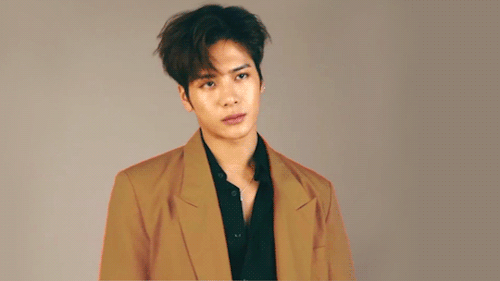
Park Jinyoung, stage name: Jinyoung (IF YOU CALL HIM JR OR JUNIOR, HE WILL FITE U). ‘94 line, vocal and dancer. ISFJ personality. Korean. Before debuting as part of GOT7, debuted in a duo with Jaebum called JJ Project. Tied with Jaebum for first place at 2009 JYP auditions. Has melodious, beautiful falsetto. Is an actor, appeared in multiple web dramas and was the young main for Legend of the Blue Sea, in addition to the lead in the independent film, Nunbal. Writes fucking bops. Is basically good at everything, the boy to bring home to your parents. Also the man who may take over the world. Idk. I’m not biased.
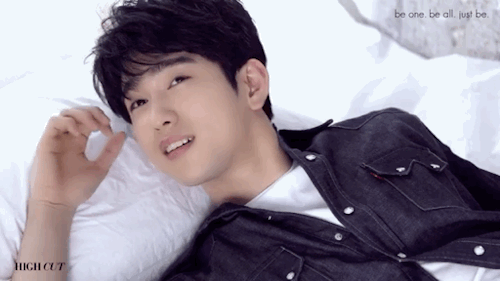
Choi Youngjae, stage name: Youngjae. ‘96 line, main vocal. ISFJ personality. Korean. Only trained for 7 months before debut, POWERHOUSE vocal. Composes under the name of Ars. Often compared to an otter bc SMILEY and ADORABLE and just actual sunshine. Anyone who hurts Youngjae answers to Jaebum. Hates cucumbers. Co-owns a puppy named Coco with Mark. Constantly damaging Jackson’s hearing with his yelling.
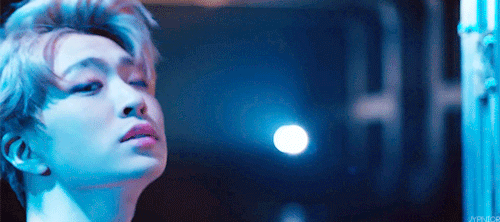
Bambam, stage name: Bambam. ‘97 line, rapper. ESTJ personality. From Thailand, trained with JYP for three and a half years. Legal Thai name is Kunpimook Bhuwakul but is rarely used except in legal circumstances. Bambam is his name lol. ANYWAYS. Bambam has rapidly switched from adorable maknae line to fly-ass fashion mogul. Loves memes, all things pop culture and fashion. Speaks Thai, Korean and English. Loves to interact with fans, especially through Twitter. Constantly calling fans girlfriends at fanmeets, WILL DAB WHENEVER HE WANTS TO DAB.
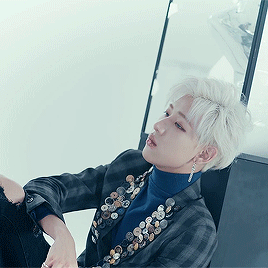
Kim Yugyeom, stage name: Yugyeom. ‘97 line, singer and main dancer. INFP personality. Korean. Maknae. Main dancer in GOT7, performed twice on Hit the Stage and won first place the second time. Like Bambam, has transformed from adorable maknae to champion of sexy dance. Yugyeom is coming for us all. Is quiet and sweet but also loves to troll hyung line. Specifically Jinyoung and Jaebum. Is the biggest JJ Project fan in the world. One day, Jinyoung might actually kill him.

MORE UNDER THE CUT.
So. Eras.
Their debut single was 2014 with Girls, Girls, Girls. As you can tell, the styling is excellent. Jackson’s small piece of hair popping out of his hat is a personal fave. Thus introduced the boys to the scene though (BONUS POINTS if you spot all the future Twice members LOL)
Next GOT7 released A, which is one of my personal favorites. Yes, that is Sana. LOL ALSO THE DANCE PRACTICES FOR A ARE ADORABLE. This has been a PSA.
GOT7′s first full album, Identify was released at the end of the year with a lead single Stop, Stop It. Otherwise known as those minions outfits. This song will get stuck in your head. THIS ALBUM IS A BOP, THO. Girl Magnetic and Moonlight are two personal favorites.
The next summer GOT7 came back with Just Right. Actually, this is GOT7′s most watched MV on YouTube. It was also featured in the Try Guys (Buzzfeed) watch Kpop video. Famous quotes to know about JB: “While this guy doesn’t look like my wife, he makes me feel the way that my wife makes me feel.” Truth, Ned.
That fall, GOT7 came back with If You Do, a darker concept. Just... watch every single live stage of this. You won’t regret it. Here’s a favorite, though. In December of that year, the released yet ANOTHER EP, which included the holiday single - Confession Song. EVERYDAY from this album is amazing, thank you JB.
In March of 2016, GOT7 came back with the Flight Log Trilogy (Departure, Turbulence and Arrival). The first album, Departure was released in March. The lead single was Fly, and it was bomb af. That’s just fact. The dance practice for this was also freaking adorable. Fave tracks from this album of mine are Can’t by PARK JINYOUNG. Also Rewind.
That fall, GOT7 came back with Turbulence. The lead single for this was Hard Carry, a heavier beat than previous GOT7 songs. Crazy dance, prompted much concern by fans that Jinyoung died in the MV. Favorite songs of mine here are Prove it, Mayday, No Jam and Who’s That.
The next spring, 2017 GOT7 completed their Flight Log Trilogy with Flight Log: Arrival. The lead single for this was Never Ever. Favorite songs are Paradise, Q.
THEN JJ PROJECT CAME BACK. SUMMER 2017, FIVE YEARS AFTER THEIR FIRST EP. Jinyoung and Jaebum teamed up yet again to put out a beautiful album called Verse 2. If you haven’t listened yet, save yourself. Go listen now. The title track was Tomorrow Today, and it was amazing. Truly.
Now GOT7 are coming back once more - GET READY FOR FOR 7FOR7
FAVORITE FANCAMS / PERFORMANCES
My personal fave is this Jinyoung fancam of Can’t. Bless yourself.
Jaebum is also a favorite performer lol bc when JB dances, he dances for JB. This performance of Who’s Your Mama? is excellent, as is this mix. So is this performance of Honey.
The cover of SHINHWA’s This Love is truly amazing. (JB was hurt at this time and couldn’t perform.)
Never forget baby GOT7 performing I Was Made for Dancing for an audience of middle aged women. LOOK HOW HAPPY THEY ARE.
Also the time they collaborated with BTS at the MAMAs.
All the performances of Q (side single to Never Ever) are adorable.
GAH, okay. That should start you off.
Variety. Holy shit. Okay, so GOT7 are kings of variety. Honestly, it’s why I adore them so much. Watch their YouTube shows, it’s GOT7 Canon.
Real GOT7 season 1 / Real GOT7 season 2 / Real GOT7 season 3 / Real GOT7 season 4
GOT7 Hard Carry, from the fall of 2016 is also excellent.
GOT7 has a truly awe-inspiring mini-drama series called Dream Knight, available on Netflix. I highly suggest you start with this. And then stare at your screen for several days in confusion.
JB and Jinyoung have a reality series from their days as JJ Project called JJP Diaries, here.
ALL OF THE WEEKLY IDOL EPISODES ARE HILARIOUS AF. First appearance - 2014. Second appearance - 2015. Third appearance (multi-group) - 2016. Fourth appearance - 2016. Fifth appearance - 2017. Er, it’s entirely possible I left some off. Oh, well. You’ll find them. LOL
Also watch all of their ASC episodes. It’s pure chaos.
OKAY. THAT’S ENOUGH FOR NOW *falls down on the floor*

... here is a compilation of jinyoung being savage. here is jaebum being a meme for the duration of an entire interview in japan. here is bambam, king of girl group dances.
OKAY, NOW I AM REALLY DONE.
1K notes
·
View notes
Text
The Maradona of the 21st Century is not Lionel Messi
The most common and in fact only real comparison ever made between 2 great footballers of different eras is that of Diego Maradona and Lionel Messi. Both are diminutive left-footed Argentine number 10′s, blessed with the best dribbling ability the game has ever seen. With a strength and speed that belies their stature, combined with extraordinary close control, they beat defenders at a rate that noone has matched.
And in the early day’s of Messi, there were eerie similarities. 2005 saw Messi make his international debut against Hungary, the same opponent Maradona debuted against. In 2007 Messi scored against Getafe with a goal identical to Maradona’s ‘goal of the century’ and then a couple of months later he scored with his hand against Espanyol, going unpunished as Diego famously did with the ‘Hand of God’.
But since then, the differences between the two players careers have grew and grew. Messi has so far spent over 20 years at one football club, Maradona represented 6 across 7 different spells. Leo though only 33, has already scored well over twice as many career goals as Maradona, and has appeared in well over 200 more senior matches. Messi has scored over 30 goals for his club in 13 consecutive seasons, Maradona only scored over 20 goals twice in Europe. Messi has so far won 35 major honours in club football, to Diego’s 9. Maradona has lifted the World Cup whereas Messi has never won a senior international trophy and Messi has scored over twice as many goals for Argentina, with over 50 more caps so far.
Simply put, they have had very different careers and lived very different lifestyles. I feel greater similarities are to be found between Maradona and another 21st century footballer, who also wore the number 10 shirt for Barcelona, Ronaldinho.
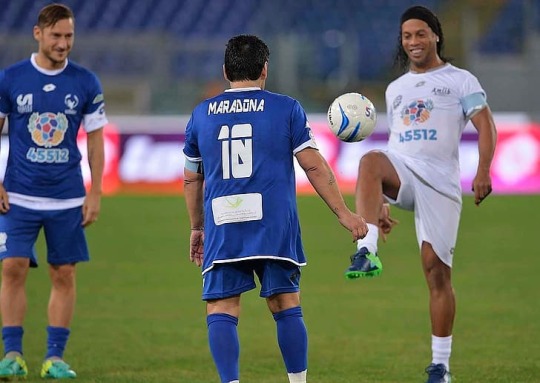
Maradona and Ronaldinho both spent 10 seasons in Europe, played for 3 European Clubs, and spent 2 seasons at their first European club. They played by far the best and most consistent football of their career and reached their highest highs at their 2nd European club. Here both men won 5 major honours, including 2 league titles and a European trophy. Maradona played 52 more games for Napoli and scored 21 more goals than Ronaldinho for Barcelona, which makes it likely that if they’d played an identical amount of games, they’d have an almost identical goal tally.
Both won the World Cup with a 2-0 knockout stage win over Belgium, a 2-1 Quarter-Final win over England, and beat Germany in the final. Both also scored goals in the Quarter-Final which were the best remembered of the tournament and highly embarrassed the England goalkeeper.
Here are some stats which highlight some more similarities in their respective careers:
Club trophies won: Maradona 9, Ronaldinho 12. Number of Clubs: Maradona 6 (in 7 spells), Ronaldinho 8. International caps: Maradona 91, Ronaldinho 97. International goals: Maradona 34, Ronaldinho 33. Competitive Internationals: Maradona 46, Ronaldinho 52. Goals in Competitive internationals: Maradona 17, Ronaldinho 17. Total senior goals: Maradona 345, Ronaldinho 299. freekicks scored: Maradona 62, Ronaldinho 66.
As Players
Maradona was a classic Number 10, a creative playmaker operating from a free role either as an attacking midfielder or a 2nd striker. His game was renowned for his dribbling which due to his low centre of gravity, stocky physique, acceleration, quick feet, close control, agility and his ability to quickly change direction made him extremely difficult to stop. Despite a solid goal return, Maradona’s game was about more than just scoring goals and individual runs, his vision, passing and creativity made him a fantastic teamplayer also.
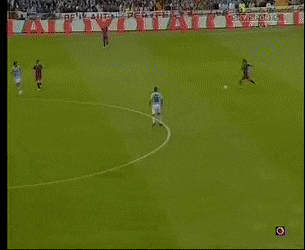
Ronaldinho also could operate as a Number 10, playing in a free central role as an attacking midfielder, though he could also be deployed on either wing to devastating effect. Ronaldinho was an extremely effective playmaker as like Maradona he possessed outstanding vision and creativty with great passing ability. He was also a world class dribbler with underrated pace and acceleration, aswell as athleticism, balance and ball control allowing him to take on opponents. He was one of the most effective ever 1 v 1 at beating players with his tricks, feints, stepovers, nutmegs, aswell as sheer unpredictability making him extremely challenging to handle. Ronaldinho was also known for his technical skills, flair, creativity and touch.
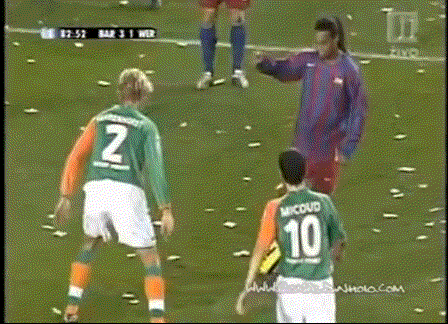
Maradona and Ronaldinho are the most skillful players to ever reach the top of the game. More so than anyone else who has become the number 1 player on the planet, they were freestyle footballers. Maradona was one of Ronaldinho’s idols as a kid, and it’s easy to see why. Only Ronaldinho himself could cast a similar spell over the ball, Diego seemed to be almost at one with it, manipulating it in any way he wanted.
Whether doing keepy-ups with his shoulders, head, heel or slices as naturally as other players do them with their feet, Maradona had an artists understanding with the ball. And not just footballs either, his feet could do whatever he wished with golf balls, rolled up socks, anything he could make resemble a football he juggled with.
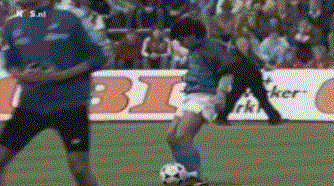
Maradona and Ronaldinho were two players who you didn’t need to see in an-game situation to be entertained by. Just throw them a ball. This was evidenced with the well known video of Maradona warming up before a UEFA Cup Semi-Final against Bayern Munich set to ‘Life is Life’ by Opus. Preparing for the game as if he’s arrived too early for a kickabout and is waiting for his mates to show up, Diego plays with an unbelievable rhythm.
This sense of rhythm and fun didn’t leave Diego once the game had kicked off, with regular rabona’s and roulette’s (which became known as the Maradona turn due to the level he perfected it) elevating the entertainment for everyone in attendance.
This is where I think his game is more similar to Ronaldinho’s than that of Messi’s. Lionel though brilliant to watch is nowhere near as flashy, applying skills only when absolutely necessary. For Ronaldinho however, skills always felt necessary. No look passes, pannas, elasticos (known also by some as ‘the gaucho’ due to Ronaldinho’s mastery of the skill) were all regular features of Ronaldinho’s arsenal.
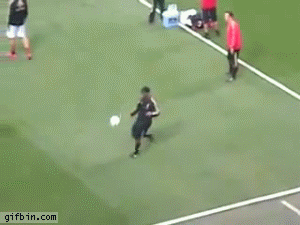
Like Maradona, Ronaldinho was always worth watching before a game had even kicked off. And in training he was capable of getting his teammates to stop dead in their tracks and just stand around watching him perform his skills. An example of Ronaldinho’s ridiculous skill level compared to everyone else, was when he and a number of other top professionals took on the ‘Blindfolded Keepie Uppie challenge’ where as the name suggests, you attempt to do kick ups whilst wearing a blindfold. Benzema managed 5, Lewandowski 7, Xavi 8 and Ronaldinho.. 44.
It’s maybe a strange thing to say about a player who some consider the greatest of all time, and most consider in the top 3 of all time, but Maradona could’ve done even more in football. What he was able to do was limited by injuries courtesy of the many dreadful fouls he endured, bouts of lacking motivation, a lifestyle that led to drug addiction, weight gains & crash diets, and 2 drugs bans that meant he scored just 15 league goals after his 30th Birthday.
And aswell, it shows how good Ronaldinho was that a career that saw him become the only player to win the World Cup, the Champions League, the Copa Libertadores and the Balon d’or (not to mention 2 La Liga’s and 2 FIFA World Player of The Year Awards) is seen by many as one that could and should have been better. A lack of dedication and discipline, combined with his hedonistic lifestyle off the pitch led to Ronaldinho’s physical decline coming alot sooner than it should have. That said I think it’s unfair to boil his whole career down to just his years at Barcelona (where he did for a while have the focus and dedication to become the best player in the world) and dismiss everything else. There was still plenty of very good performances afterwards for AC Milan, Flamengo and Atletico Mineiro, where he thrilled the supporters with his quality.
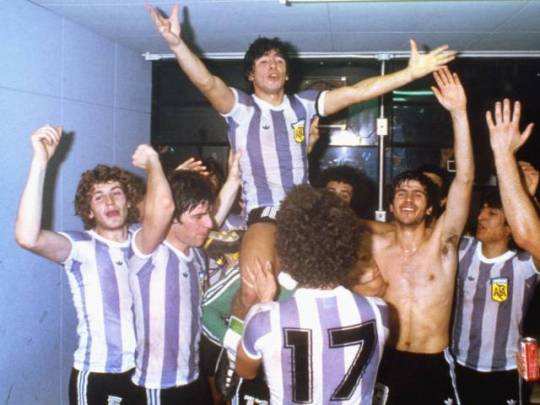
Maradona was in many ways an individualist, for example he had his own fitness coach and his own doctors, never using the doctors employed by his club side or national team, but he was also very much a team player. A technical leader, he was loved by his teammates because he took all the pressure, all the attention on his shoulders, freeing the team up to go out and play without burden. The best example of the deep respect Maradona’s teammates had for him was in a clip from the Napoli dressing room following their historic first Scudetto win in 1987, where the players all sing as though ultras rather than colleagues: “Oh mama, mama, mama, do you know why my heart is racing? I’ve seen Maradona! I’ve seen Maradona! and Mum I fell in love with him!”

In a different way, Ronaldinho was also an excellent team player. When Ronaldinho was at the peak of his powers, a 16-year old Argentine came to his attention. Here he saw a player he knew could be something special. Ronaldinho became a sort of big brother figure to Messi from that point on, helping him as much as possible. For an introverted young kid to have the best player in the World take such a care and interest in him, must have been a tremendous boost. There was no ego from Ronaldinho, no jealousy or attempt to keep the teenager ‘In his place’. When Messi was 17, Ronaldinho introduced him to Kobe Bryant as “someone who will be the best footballer of all time” and in an interview with Four Four Two magazine the current Balon d’Or holder claimed Messi was already better than him.
Beginning

Diego Armando Maradona was born October 30, 1960 in Buenos Aires, Argentina and was raised in the Villa Fiorito shantytown, on the outskirts of the capital city. His love of football came very early, when he was given a ball as his first toy at 3 years old, and slept hugging it all night. Growing up in a shack without water or electricity, when Maradona joined the Argentinos Juniors youth team at just 8 years old he and his parents soon realised that their only way out of this hardship was for Diego to make it as a footballer. He already played with an ability way beyond his years and small, skinny physique quickly beginning to garner attention.
As a ballboy for Argentinos Juniors 1st team games, he would go on to the pitch at half time and entertain the crowds with his skills and tricks, aswell as an extraordinary acceleration when dribbling the ball. On one occasion as the 10-year old Diego exited the field for the Argentinos-Boca Juniors game to re-commence, the fans chanted “Let him stay! Let him stay!”. As Maradona continued to seemingly get better with every match he played in the youth teams, Argentinos Juniors had already pinned all their hopes on him before he’d even joined the first team. They already recognised him as the only player they had who could raise serious funds in the future, and in the meantime would be able to improve the team. He was promoted to the first team aged 15.
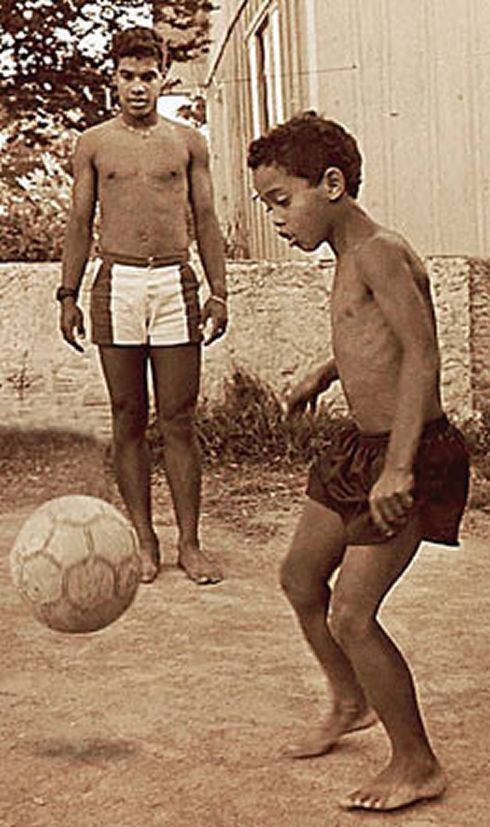
Ronaldo de Assis Moreira was born March 21, 1980 in Porto Alegre, Brazil. He lived in a wooden house in the middle of a favela, until his brother Roberto 8 years his senior, was gifted a home in a more affluent area by Gremio in an effort to get him to stay with the club and reject the interest of Italian club Torino. Tragedy would soon strike for Roberto and his younger brother however, when Roberto returned to the house to celebrate his 18th birthday only to find his father drowned in the family swimming pool.
From a young age Roberto would train his younger brother in one-on-one football sessions, after noticing he too had a real talent for the game. Ronaldinho said of this time “Roberto forced me to juggle the ball as many as 500 times. He stood to watch me do it and would never go until I’d completed it. This took all the fun out of it for me, and at that age it made me very angry. I cried. I didn’t understand. But later I understood what he wanted.”
Roberto’s football career was going well, he had played for Brasil’s under 20′s team and won 3 consecutive state titles with Gremio, the future looked very bright, when more misfortune struck the family. Roberto suffered a serious injury and was let go by Gremio. He moved to FC Sion in Switzerland and with his older brother and father figure since the passing of his Dad now living far away, Ronaldo felt an increased urgency and responsibility to step up and make it as a footballer to help the family financially. He had learned alot from his big brother, who despite being prevented from fulfilling his potential due to injury was still able to etch out a career in football, with a journeyman career making appearances for many sides including Vasco De Gama, Fluimenese and Sporting Lisbon.
Ronaldo played Futsal and Beach Football aswell as 11-a-side football and all this honed his ball control and skills. Often the smallest and youngest player on each of the teams he played for he quickly was assigned the nickname ‘Ronaldinho’ meaning ‘little Ronaldo’ which has always stuck throughout his career despite him growing to over 6 feet tall. He was 13 when he received his first media attention after scoring all 23 goals in a 23-0 win for his side at Futsal (though he did later say “those kids were terrible!”). After starring at the Under 17 World Cup, Ronaldinho followed in his big brothers footsteps by signing for Gremio.
Maradona and Ronaldinho both had their youthful innocence cut short and were forced to see Football as more than fun but as a way out of their hardships at a very young age. As a mere child Maradona had all his families hopes pinned on him for a way out of extreme poverty and Ronaldinho experienced the hardships of life early too with the death of his father and career damaging injury to his brother. But despite all the external pressure and aswell the huge demand they put on themselves to succeed for their families, their pure love for football never wavered.
Starting Out
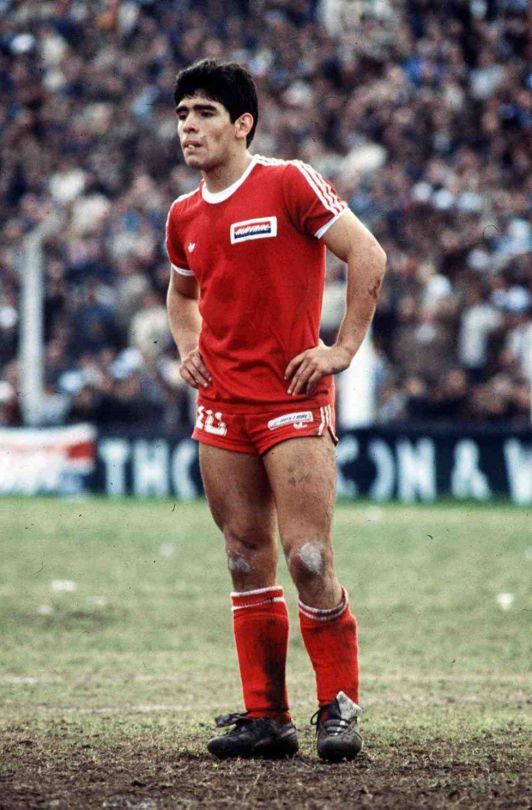
Maradona made his first-team debut for Argentinos 10 days before his 16th Birthday. A few minutes after entering the pitch, he nutmegged an opponent. A few weeks later he made his first start, with then vice-president Settimio Aloisio recalling “What really struck me was the joy there seemed to be in his playing. What seemed unique was that he didn’t seem to have any fear, he was so self-assured, so determined. It was the first time he played a full 90 minutes in the first-team and he did it with all the confidence of a player who had been playing top-class football for at least six years.”
In Diego’s first season for the club in 1976 they finished 2nd bottom of the Metropolitano Championship. In his final season they finished 2nd top. He scored 116 goals in 166 appearences, including a Messi-esque 69 in 71 in his last 2 seasons. Maradona was now too big and too good for the team, and it was time for Argentinos Juniors to get the big payday they hoped years of nurturing this talent would get them. Maradona joined the club he always dreamed of playing for, Boca Juniors for $4M.
Maradona scored 28 goals in 40 games for the club, including a memorable goal in his first Superclasico at La Bombanera stadium against River Plate. The 1981 season brought him his first trophy in senior football, when Boca secured the Metropolitano Championship, the clubs first title for 5 years, by a single point. They had finished 6th in the competition the year before Diego joined.
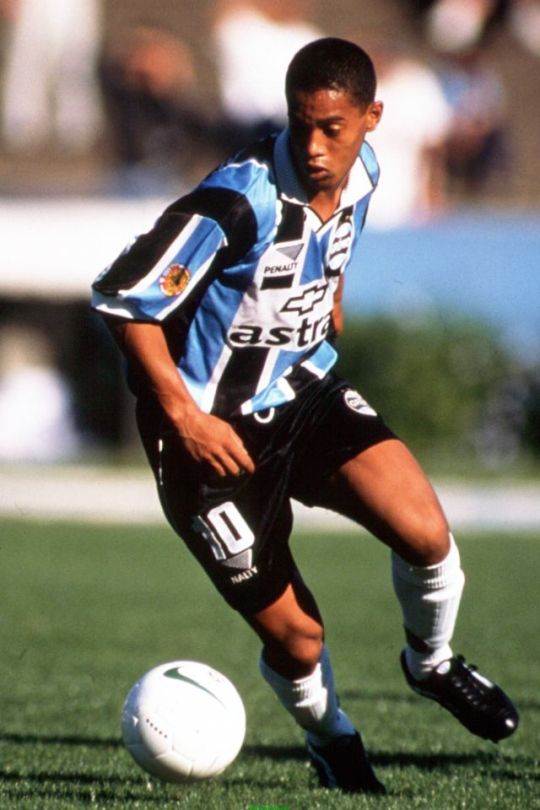
Ronaldinho made his debut for Gremio in 1998, and by his 2nd season the teenager was already showing himself as one of the top Brazilian players in the world. A real breakout moment for him came in the Campeonato Gaucho, the State Championship, usually won by one of Porto Alegre’s biggest sides, either Gremio or rivals Internacional. Gremio came out on top after a sublime performance from Ronaldinho where he tormented and terrorised Brazil’s World Cup winning captain Dunga, on one occasion flicking the ball over his head.
Ronaldinho scored 58 goals in 125 appearances for Gremio, 52 in 87 excluding his debut season and 28 in 37 in his last full season. This was enough to convince Paris St. Germain to spend 5 million Euros to bring him to the French Capital.
Maradona and Ronaldinho both began their professional careers for their local sides, neither club the most glamorous or prestigious of their country, but both rapidly stood out with their performances. Ronaldinho was transferred to Europe in half the time with his first 3 seasons in his native country as opposed to Maradona’s 6, highlighting the change in Football between the late 70s, early 80s and the late 90′s, early 00′s.
In 1978 Argentina had won the World Cup with just one player playing outside of Argentina, and coach Menotti had warned Maradona that Argentina fans would not accept him leaving to play his domestic football in Europe, he did not join a European club until his 7th season. By the time Ronaldinho was on the scene, Europe’s stranglehold over Football meant it was the only place to play for the game’s best talents. Maradona played 206 games in the country of his birth before joining FC Barcelona for a then world record fee of £5 Million pounds.
Europe

Maradona described his time at FC Barcelona as the ‘unhappiest period of my career’. He found German coach Udo Lattek’s hard early-morning training sessions unsuited to his lifestyle, and had a relationship with Barcelona’s then president Jose Luis Nunez which was hostile from the off. The free-spirit of Diego quickly found the atmosphere of Barcelona oppressive, he felt the cold, calculated stuffed shirts of the Barca boardroom looked down on him as a naive, uneducated outsider. Maradona was used to getting his way in Argentina, and was not a man who could easily accept authority over his life. Whilst Barcelona as an institution were not a club willing to bend for one man, no matter how talented he was with a football.
The early signs on the pitch however, were promising. The team received a standing ovation leaving the pitch away to Red Star Belgrade in the Cup Winners Cup, after a 4-2 victory with 2 goals each for Maradona and fellow foreign star signing Bernd Schuster. But the ego’s and personality clashes of Nunez, Maradona, Lattek and Schuster meant it was never likely to last. After Maradona had spent his first ever Christmas away from Argentina in a state of depression, and not long after he’d returned from a prolonged absence due to viral hepatitis, Lattek was sacked, which did not displease either of Barcelona’s star players, with Schuster referring to the manager as a ‘drunkard’.
Lattek was replaced by Cesar Menotti, Argentina’s World Cup winning manager who had managed Diego in the Under 20s and senior national side. It was hoped by the Barcelona hierarchy that this would be the man to bring the best out of Maradona.
The appointment of Menotti wasn’t the only thing bringing comforts of home to Maradona’s life. He did everything to recreate the life he’d known in Argentina, acquiring the friendship and services of Argentines living in Barcelona to provide him with Calabresi and sandwiches just like he’d known in Buenos Aires. But whenever Maradona and his clan would hit Las Ramblas, which was often, he had to accept he wasn’t in his beloved Argentina anymore. He was in a place with wealthy, educated people who looked down on him and his friends, fuelling Maradona’s inferiority complex which he battled all his life due to his poor upbringing.
It was also during this time in Barcelona that Maradona first began taking cocaine, and though he was able to keep this a secret from Barca, some reports of his activities including regular house parties into the early hours with prostitutes in attendance did make it back to an increasingly exasperated board. The Maradona-Nunez conflict continued to intensify, with Jorge Cyterszpiler, Maradona’s then agent responding to comments from Nunez in the press by phoning him and calling him a “son of a bitch”.
4 Days before the King’s Cup final between Barcelona and hated rivals Real Madrid, Nunez refused to allow Maradona to travel to Munich for a testimonial match, a lack of liberty which infuriated Maradona. The team were able to capture the trophy however, beating Real 2-1 with a 90th minute winner, in a game both Maradona and Schuster ran. It had been a turbulent debut season however to say the least, the team had finished 4th behind Athletic Bilbao, Spanish champions for the first time in 27 years, and the two Madrid clubs. They had also been dumped out of the Cup Winners Cup by Austrian minnows Memphis. Maradona scored 23 goals in 35 appearances but injuries and illness had limited him to just 20 league games and 11 goals.
Maradona’s second year was to be defined by yet another rivalry, this time that of coach Menotti and Athletic Bilbao manager Xavier Clemente. In a war of words due to differing football philosophies similar to that of Brian Clough and Don Revie in England, Menotti made public his disdain for what he considered (not without reason), the thuggish football of Bilbao saying “the day they decide to be a bullfighter rather than a bull on the pitch it will play better football.” Clemente responded saying he would take no lessons from an Argentine who spent more time pursuing women than teaching football skills. The stage was set for a series of violent matches to take place between the sides that season. With Barca leading Bilbao 2-0 at the Nou Camp early in the season, Goikoetxea, subsequently named ‘the Butcher of Bilbao’ delivered one of the most brutal fouls Spanish football had seen on Maradona. Menotti demanded Goikoetxea be banned for life, as it was he was hit with a 10-game ban instead. This came as little consolation for Maradona who had long complained about the harsh treatment he received from defenders in Spain due to little protection from referees. This tackle, feared possibly career threatening at the time, kept him sidelined for 3 months.
A few weeks after his return to fitness, Maradona lined up to face Bilbao again, this time at the San Mames stadium. Maradona led his team heroically through another brutal match, scoring both goals in a 2-1 win for his side in one of the dirtiest matches seen at the stadium. Maradona’s duels with Bilbao didn’t end here though, and they would reach a stunning conclusion in the 1984 King’s Cup final infront of 100,000 spectators and half of Spain’s watching public. After a 1-0 defeat featuring the usual Bilbao treatment whenever Diego went near the ball, and racist insults towards him regarding his Father’s native American Indian ancestry, he was given a ‘fuck off’ sign by unused Bilbao substitute Sola, and Maradona subsequently knocked him to the floor before kneeing him out cold. Chaos ensued with a mass brawl involving all the players, with flying kicks everywhere you looked. Maradona was at one stage knocked to the floor with a Bilbao player standing over him, when out of nowhere a teammate jumped in with a huge kick to the players back sending him flying. Maradona left the pitch with his Barcelona shirt torn, he would never wear one again. The brawl resulted in 60 people being injured as fans rained missiles down on players, coaches and photographers.
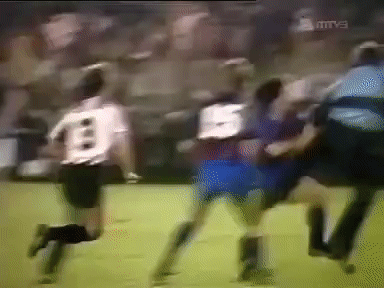
The board had seen enough, Maradona’s time with Barcelona was up. He scored 38 goals in 58 games for the club. There had been some highs, beating Real Madrid in the Kings Cup and the short lived Spanish League Cup final, where after scoring one of the all-time great El Clasico goals in the 1st leg at the Bernabeu he was given a standing ovation by the Real supporters. But there had also been just as many lows, and overall Maradona had failed to do what he was signed to do, establish Barcelona as Spain’s number 1 team again. A move was required for all parties, as Maradona’s spending and bad business moves made on his behalf had left him with so much debt only a huge signing-on fee would take care of it. This came in the shape of another world record fee, £6.9M to Italian Club Napoli. Both Maradona and Barcelona would benefit from the move, as under Terry Venables Barcelona won their first league title for 11 years by 10 points (in the days of 2 points for a win) and reached their first European Cup final the following year, losing on penalties to Steaua Bucharest. Ironically it took the departure of Maradona to get Barcelona to do what his arrival was supposed to do for them.
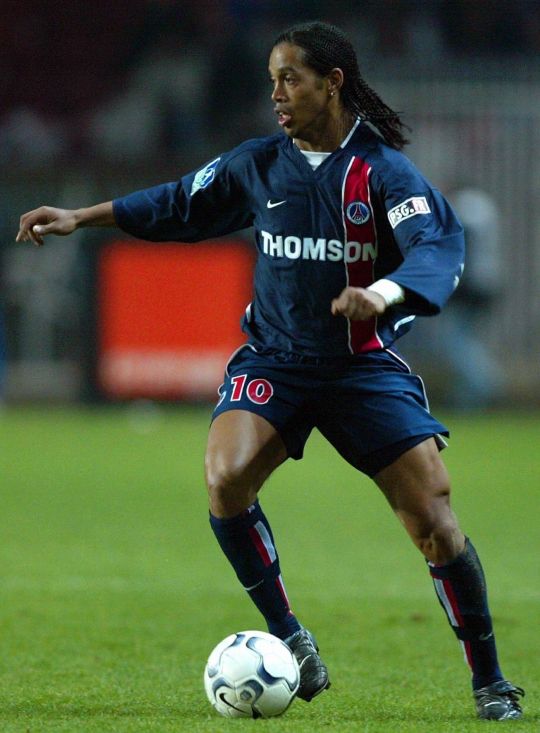
Ronaldinho chose long-time sleeping giants Paris Saint Germain when better teams were perhaps interested in signing him for one reason only, to ensure he would be a regular starter in order to convince Brazil manager Scolari that he should be the 3rd name in the attack alongside Ronaldo and Rivaldo. For the first few months, his plan seemed to have backfired spectacularly. After getting the all clear to play from Fifa, after a messy legal procedure between PSG and Gremio, he still struggled to get the all clear to start from manager Luis Fernandez, so was forced to watch players such as Gabriel Heinze, Mauricio Pochettino, Jay Jay Okocha and Nicolas Anelka from the bench for much of the time before being introduced into games in the second half more often than not.
This slow start was doubly concerning due to the form back home of Ricardo Kaka who was banging them in for Sao Paulo. At the half way stage, it looked likely it would be Kaka starting for Brazil and if Ronaldinho didn’t find some form, he would be a doubt to even make the plane.
Ronaldinho began to make an impact before the winter break, and after it his fortunes had an even greater upturn. Okocha went to the African Cup of Nations and Anelka was loaned to Liverpool. Ronaldinho was going to become the main man in the PSG attack, if he could seize his chance. He scored in the first 4 games back, including a brace against Guingamp.
By mid-march he was making it look easy, looking as though nothing was more simple to him than dribbling through a defence and beating the onrushing goalkeeper as he did not once but twice against Troyes.
Despite only starting half the league games, Ronaldinho finished the season confirming himself as PSG’s best and most important player, aswell as their top scorer with 13 goals and earning a place in the Ligue 1 team of the season.
Ronaldinho returned for his second season at PSG as a World Cup winner, however his upward trajectory at Paris which had begun in the second half of his first season would not continue without dips. Manager Luis Fernandez criticised Ronaldinho’s enthusiasm for Parisian nightlife, claiming he focused on it more than Football. Another source of frustration for him was a typical one for managers dealing with Brazilian players, the long trips back home Ronaldinho took during the season, which Fernandez bemoaned never ended when scheduled. Ronaldinho fired back at his manager’s criticism that “it seems to bother him that I am happy.”
The league campaign was a very disappointing one to say the least for PSG, finishing 7 places lower than in Ronaldinho’s first season, coming in 11th place. On a personal level, there was some satisfaction for Ronaldinho in winning the award for Ligue 1 goal of the season, with a brilliant solo goal against Guingamp. Accelerating suddenly before the first man has even had a chance to get close to him, he plays a one-two around another, then dinks the ball over a slide tackling defender, waits for the ball to drop then dribbles into the box, throws a stepover to make space for the shot then lifts the ball quite wonderfully over a helpless goalkeeper. Pure Ronaldinho magic.
Paris also reached the Coupe de France final after 2 goals from Ronaldinho in the semi-final got them there, however they were beaten by Auxerre in the final with a last minute winner. With a season outside of Europe on the horizon, it was time for Ronaldinho to move on to the next phase in his career. He scored 25 goals in 77 games for the Parisians.
Maradona & Ronaldinho moved to Europe aged 22 and 21 respectively, and both spent 2 seasons with their first European club. Both displayed the talent that made them at times unstoppable, but the flashes of genius were accompanied with a lack of consistency needed to go beyond the promise and potential they were showing to become as great as they undoubtedly could be. In this time, both players also discovered a love of a certain party lifestyle which would remain throughout their respective careers.
Peak
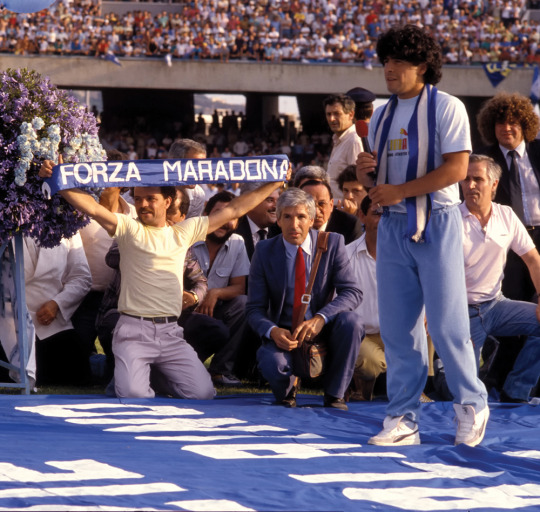
75,000 Napoli supporters packed into the Stadio San Paulo to see the official presentation of Diego Armando Maradona as a Napoli player. For all present that day, the Saviour had arrived. As one local newspaper put it “despite the lack of a mayor, houses, schools, buses, employment and sanitation, none of this matters because we have Maradona."
Maradona found himself feeling instantly more at home than he had ever felt at Barcelona. The poor background he came from aswell as having a Mother of Italian descent gave Maradona an immediate affinity with the city of Naples, in the poorer, economically disadvantaged South of Italy. He could also relate to the feeling of being looked down upon that Neapolitans felt from those in the more affluent and politically prioritised North.
During Maradona’s time in Italy, the North v South hatred was at its peak. The Maradona signing itself had political motivations. Upon hearing of Juventus’ interest in signing the Argentine, Napoli were determined to get one over on the more illustrious then-champions, who already boasted that summer’s standout player at Euro 84, Michel Platini. After his experience with Schuster, Maradona was reluctant to again share the limelight so was instead happy to join the side in the Southern region, a region that had never produced a Serie A winner. Napoli, a club formed in 1926 had to that point won just 2 major honours, both Coppa Italia’s.
Though the team he was joining had a modest history to date, the league he would playing in was by far the best and most competitive in the world. Though a defensive league with emphasis put on the ‘Cattenacio’ style of play, featuring tight man-to-man marking and a sweeper, Maradona could atleast rely on better protection from referees than he’d received in Spain.
Unlike in Barcelona, where the snobbery in high society left Maradona on the outside, Maradona found in Naples he was embraced wherever he found himself in Italy’s most densely populated metropolis, including alongside the Camorra, the Neapolitan Mafia, who had extraordinary influence in all matters in the city at this time. Carmine Guiliano, of the powerful Guiliano clan was only too eager to place himself alongside Naples’ new messiah. And Maradona for his part seemed to find himself more comfortable in this company, than he’d ever felt with the distant and alien Barcelona hierarchy.
Hellas Verona were champions for the only time in their history in Maradona’s debut season, with Napoli having to settle for 8th place. This improved to 3rd in the following year, though off the pitch Maradona had his first serious problems with long-time girlfriend Claudia.
Maradona’s 3rd season saw him hit the peak of his considerable powers. Fresh off the back of inspiring Argentina to the 1986 World Cup trophy, his encore was delivering Napoli to the promised land as they took their first ever Scudetto, with a league double over Juventus proving decisive. Winning Serie A sparked a week-long party in Naples, so often the butt of the North’s jokes, it was they who were laughing now. Maradona had put Napoli and the entire city of Naples on top of Italy, and in doing so his standing amongst the people could not have been any higher. In the eyes of the adoring Neapolitans he was more than a footballer, more than a man even.
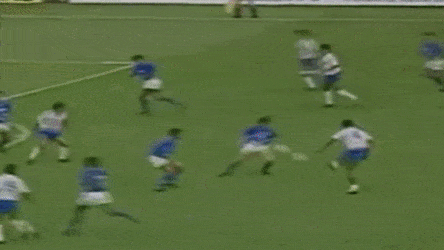
Maradona and Napoli were unable to retain their crown, ending the season with 4 losses and 1 draw as they lost out to Milan by 3 points. This was the season problems between Maradona and Napoli president Corrado Ferlaino began to materialise. Napoli who had so far accepted his unwillingness to be controlled had grown frustrated at his missing of training sessions and the following season with Maradona injured or missing from training all the more regularly, Napoli ended further away from the Scudetto. Though still 2nd they finished 11 points behind Internazionale and were beaten in the Coppa Italia final. Things reached their lowest moment to date that season when Maradona took himself off just 17 minutes into a game due to injury, this was greeted with jeers and whistles from the supporters who had once revered him as their King. This infuriated Maradona, but there was redemption in the Uefa Cup which Napoli won beating Stuggart in the two-legged final, after dispatching Juventus and Bayern Munich to reach it.
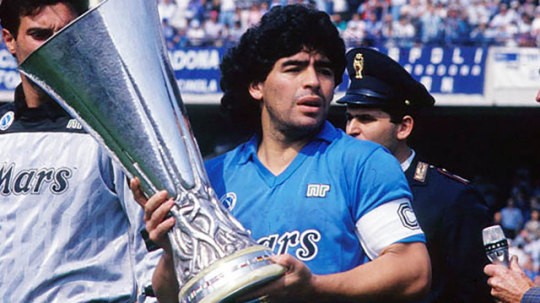
But Maradona was beginning to feel trapped again. This feeling was exacerbated by him finding out about Olympique Marseille’s interest in signing him only after Ferlaino had rejected the offer. An increasingly frustrated Maradona began lashing out and making enemies in the media, who did not accept his outspoken complaints without backlash.
After a slow start to the 89-90 season, with the World Cup that summer looming ever closer, Maradona’s motivation soared again and he had his most prolific season for Napoli, scoring 16 in 28 league games as they finished 2 points above Milan to take the Scudetto for the 2nd time in 4 years. Maradona had responded to the adversity by climbing back to the top, it was the final time in his career he would sit there.
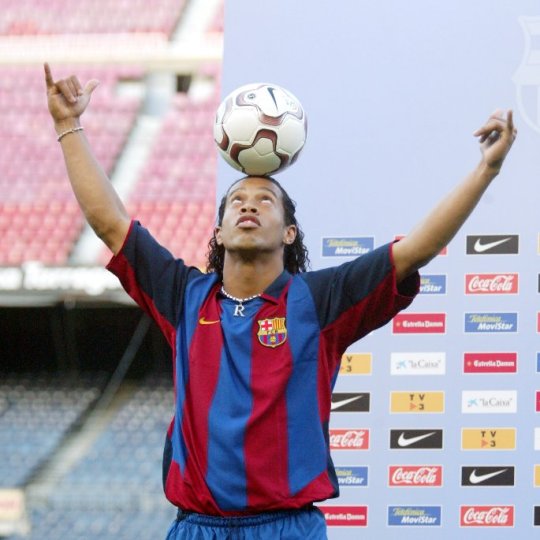
“Ronaldinho was responsible for the change in Barca. It was a bad time and the change that came about with his arrival was amazing. In the first year, he didn’t win anything but people fell in love with him. Then the trophies started coming and he made all those people happy. Barca should always be grateful for everything he did.” - Lionel Messi.
Though it would maybe be a stretch to compare the FC Barcelona that Ronaldinho joined in 2003 to Napoli, the fact is the club was not in a good place. Trophyless for 4 seasons, having gone through 6 different managerial reigns in that time, the club hadn’t finished above 4th for 3 years and the season prior to the Brazilian's arrival, Barca had their worst league position for 15 years, coming in 6th, as 3 different managers tried and failed to turn their fortunes around. Making matters even worse during this trophy drought, their bitter rivals Real Madrid had taken their star captain Luis Figo and just to rub it in had won 5 major honours including 2 Champions League titles. It was them enjoying the stability of one coach, with all this silverware coming under Vincente Del Bosque.
2003-04 brought Barcelona a new President Juan Laporta, a new manager in Frank Rijkaard and now it needed a new star player. Laporta earmarked 3 players of which he felt 1 was needed to bring Barcelona back to the top: Thierry Henry of Arsenal, David Beckham of Manchester United or Ronaldinho of PSG. Henry had unfinished business left at Arsenal, Florentino Perez made Beckham his latest and most glamorous Galactico to date, leaving Ronaldinho. And though Real Madrid passed up on him, with the words of a Real Madrid executive “He is so ugly that he’d sink you as a brand” reflecting Real Madrid’s new Business first, Football second approach which had led to the bizarre sacking of Vicente Del Bosque, the path to Ronaldinho was not completely clear for Barcelona. Premier League Champions Manchester United were very close to securing the 23-year old but in the end they couldn’t get it over the line and instead had to settle for a skinny 18-year old winger from Sporting Lisbon.
Ronaldinho started as he meant to go on in his very 1st league match at the Camp Nou. With Barca trailing to Sevilla, he received the ball on the left inside his own half and 8 seconds later he had the ball in the net. Arriving into the Sevilla half he cut inside past one then another and let fly from 30 yards, it was in as soon as it left his foot, cannoning in off the crossbar with the keeper beaten by unbelievable power and precision.
The Brazilian was unable to prevent the Catalans 5th season without silverware, but 03/04 was a big improvement on the previous year. After a bad start saw Barca in 12th place after 18 matches, the team put together a run of 17 league games without defeat featuring 14 wins, including away at the Bernabeu for the first time since 1997. Ronaldinho provided the game-winning assist in the 86th minute with an immaculate chip to Xavi who scored with a finish equal to the pass. In the end the team finished in 2nd place, behind Champions Valencia but above Real Madrid who had gone backwards under Carlos Quieroz, opening an opportunity for a new force in Spain.
04/05 saw the arrival of Samuel Eto’o from Real Mallorca who proved the ideal partner for Ronaldinho in attack. Barca became the Champions of Spain for the first time since 1999 but were stopped in the Champions League by Chelsea, who beat them 4-2 at Stamford Bridge despite a very memorable Ronaldinho goal.
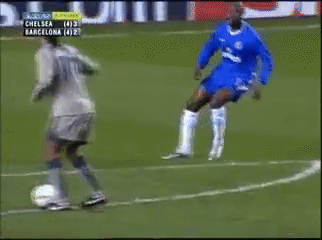
"It's like someone pressed pause and for three seconds all the players stopped and I'm the only one that moves." — Ronaldinho
Ronaldinho scored 13 goals in his 2nd season, the same as Maradona managed in his 2nd season for Napoli, but 05/06 would see Barcelona’s star man go up another level and take the club with him. In 29 league games Ronaldinho scored 17 and assisted another 18, but to focus on numbers would be to downplay what the Brazilian was doing on a weekly basis at the time. He was making La Liga defenders look as out of their depth as amateurs would against him. How could they hope to stop him when he was using skills they had never even seen let alone come up against before? At this time Ronaldinho alone was worth the entrance fee, you knew he’d do something to bring a smile to the face of every single spectator, and maybe a shake of the head due to sheer disbelief at the audacity of the tricks Ronaldinho would not only attempt but pull off.
And this was not just reserved for the defenders of Espanyol or Real Zaragoza, Ronaldinho treated every match, every opponent the same, no matter the importance of the game, he was going to play it his way.
Never was this more apparent than when Barcelona travelled to the Bernabeu in November of 2005. It was in this month that Ronaldinho won the Balon D’or for the one and only time, winning above English midfielders Frank Lampard and Steven Gerrard to add it to his FIFA World Player of the Year awards for 2004 and 2005. He shown why he was the number 1 player in the world in what was the first El Clasico for the future world’s best player, a young long-haired Argentine. But on this occasion it was the senior players, and one in particular who stole the show. With Eto’o giving the visitors an early lead, Ronaldinho doubled it just before the hour mark first skinning Sergio Ramos, before leaving Ivan Helguera and Iker Casillas flat footed and helpless to stop the genius in full flow.
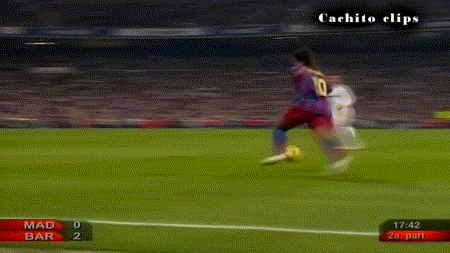
However he wasn’t done yet. 20 minutes later, running past Sergio Ramos with an ease which was only matched in the finish, which left Iker Casillas shaking his head and shrugging his shoulders, perplexed and powerless. At this point, certain sections of the Madrid fanbase felt obliged to applaud Ronaldinho. And not just 1 or 2 either. As the Barcelona players celebrated with their maestro, many Madrid fans can be seen on their feet giving a standing ovation to the man who had single handedly demolished their team. They knew their Galacticos of Beckham, Raul, Zidane, Robinho and Ronaldo had been thoroughly outclassed by the player deemed too ugly to sign. There was nothing ugly about his performance that night, as he took Real apart with a beautiful simplicity, becoming the first Barcelona player to win applause from the Bernabeu since Diego Maradona.
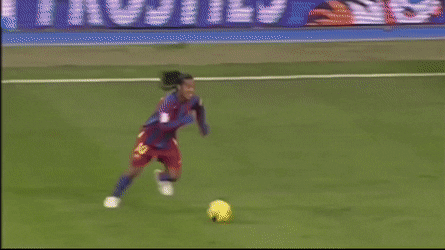
The result was indicative of the gulf that had developed between Barca and Real, as Barca retained their title finishing 12 points clear of their rivals. And in the Champions League Barca were also able to enact revenge on Chelsea before meeting AC Milan in the semi-finals. Just a single goal was scored in 180 minutes, coming from a sumptuous Ronaldinho through ball and finished expertly by Ludovic Guily. The final saw FC Barcelona meet Arsenal, and despite an early red card for the Arsenal keeper, Barca trailed with 15 minutes to go but were able to turn the game around to win just their 2nd European Cup ever and first since 1992. In 45 games Ronaldinho scored 26 and assisted 24, he was the top provider in both La Liga and the Champions League.

After a hugely underwhelming World Cup, Ronaldinho was able to pick up right where he left off at Barcelona atleast, scoring 21 La Liga goals in 32 matches, the highlight being a special overhead kick against Villarreal. However Barca missed out on the title, due to their head to head record with Real Madrid. With both clubs finishing on 76 points, a 2-0 Real Madrid win in November decided the destination of the title and Barcelona’s far superior goal difference, with more scored and fewer conceded counted for nothing. This was tough to take, but Ronaldinho had racked up 50 goals and 38 assists in 2 seasons. And at 27, Barcelona’s number 10 appeared for all the world to have many years left at the top..
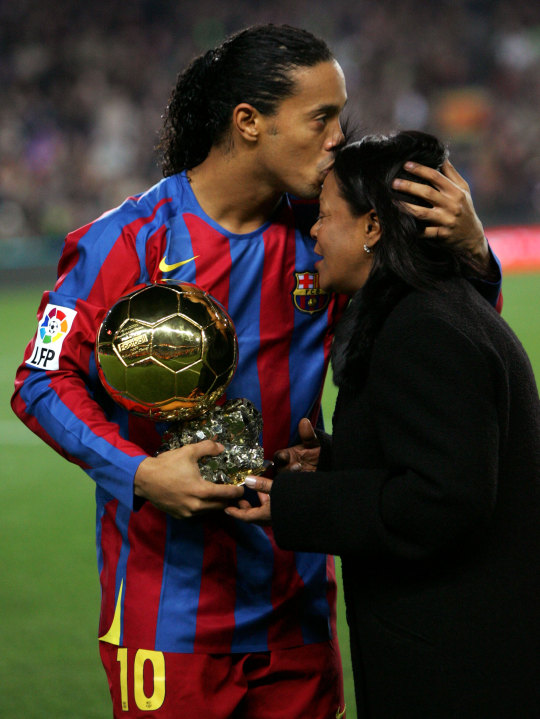
Coming Down
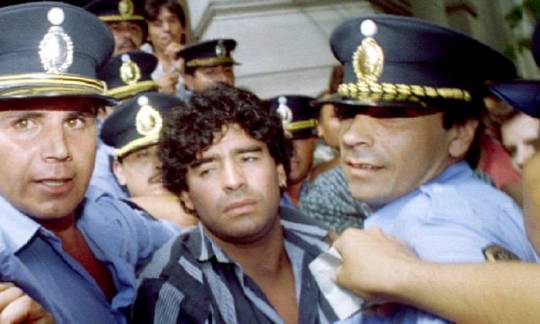
Following the 1990 World Cup which saw Maradona lose the final, the game after declaring Italian fans “hijo de putas” as the cameras panned on him for whistling out the Argentine national anthem in the Stadio San Paulo, supposedly his Kingdom, things would go from bad to worse on his return to the stadium for Napoli.
For now there was a drive in the police’s scrutiny into organised crime in Naples, and noone with connections to the Camorra was guaranteed immunity, including Diego Maradona. His time of everyone turning a blind eye to his off-field activities was up. It was the worst kept secret around that drug problems were beginning to affect his football, and media hints about the dark hole Maradona was falling down with the grip drugs had over him were appearing more and more frequently.
As police investigated the Camorra, listening into conversations, Maradona found himself being taped by police, requesting cocaine and prostitutes. This led to a police investigation into Maradona, meanwhile Napoli chose this time to abandon their lax random drug testing regime, and Maradona was randomly tested twice, both by Napoli doctors and outside doctors brought in by the club. Both tests returned positive. Diego returned to Argentina, but there was no escape to his problems. A police raid at a house he was staying at found him asleep next to grams of cocaine, he was arrested.
Maradona received a 15-month ban from football, having his final season with Napoli cut short after scoring just 6 goals in 18 league games and 10 in 26 in all competitions. His final goal for the club felt like a fitting one at the time, a consolation penalty in a 4-1 defeat away to Sampdoria. Napoli finished the season in 8th, where they finished in Diego’s 1st season with the club. The cycle had been completed and Maradona’s Neapolitan dream had turned into a nightmare.
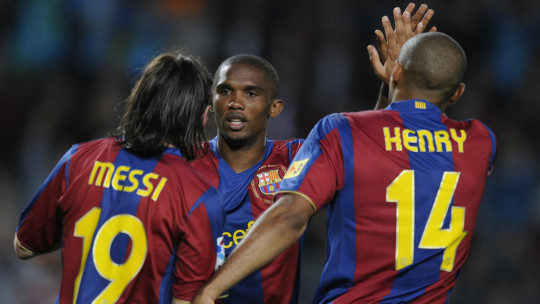
In 07/08 Ronaldinho found himself afflicted with regular injuries for the first time in his career. It couldn’t be put down to bad luck. He had lost his motivation and had stopped looking after his body. His partying and lack of dedication to training saw him lose his peak physical condition. Barcelona’s best and most important player just the season prior, Ronaldinho found that even when he was fit a place in the starting 11 was now hard to secure with the continuing emergence of Lionel Messi and the signing of Thierry Henry.
Barcelona had a poor season, finishing 18 points behind Champions Real Madrid and 10 points behind 2nd placed Villarreal. It signalled the need for a change. Rijkaard was to be replaced in the summer by former Barca midfielder Pep Guardiola, and Juan Laporta declared Ronaldinho needed a new challenge to revive his career. Ronaldinho’s season ended prematurely with an injury, after 9 goals in 26 games, numbers almost identical to Maradona’s last season in Naples. Ronaldinho’s final goal also came in a away defeat where his side shipped 4, as they went down 4-2 to Atletico Madrid. Though the Brazilian’s goal was a touch more special, coming with a spectacular overhead kick.
Just a year on from seeming irreplaceable for Barcelona, Ronaldinho was now surplus to requirements. He joined AC Milan, after rejecting Manchester City who under their new Abu Dhabi owners had placed a bid of £25.5 million.
Maradona and Ronaldinho played by far the best and most consistent football of their career for their 2nd European club. Maradona scored 115 goals in 259 Napoli games, Ronaldinho 94 in 207 for Barcelona. Not including penalties Maradona scored 73 and Ronaldinho 75.
Country

Maradona made his Argentina debut in 1977 aged 16 though missed out on making the World Cup squad the following year which Argentina hosted and won. Diego had to make do with the 1979 World Youth Championships instead, where he netted 6 in 6 including 1 in the final in a 3-1 win over the Soviet Union.
Maradona’s first World Cup came in 1982, in the country he was then plying his trade. Expectations on Barcelona’s new signing were huge, but it didn’t go to plan. He scored in just 1 of the 5 matches he played, a brace against Hungary and was sent off against Brazil, as his frustrations at his repeatedly rough but unpunished treatment at the finals reached boiling point.
Maradona entered the 1986 World Cup with his head in a bad place. With an illegitimate child on the way, conceived from an affair, Maradona was grateful for something to occupy his focus and he played the tournament like a man with nothing on his mind other than to lead his team to glory. In the Quarter-Finals Argentina met England in the first match between the sides since the Falklands War.
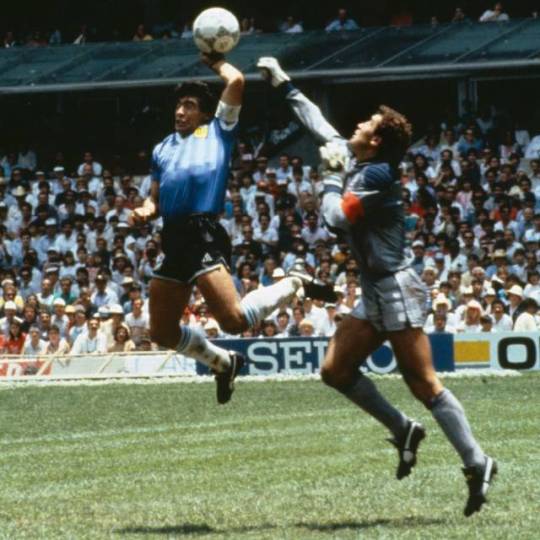
The match came to epitomise Maradona’s legacy as he scored the 2 most famous goals ever within 4 minutes of each other. After England defender Steve Hodge could only lift the ball back in the direction of his own goal, the 5 foot 5 Maradona rose in the air to direct the ball over the outstretched fist of the 6 foot Peter Shilton. Just like the England keeper, Maradona went at the ball with his hand but in such a way both the referee and the linesman missed it. Diego later described the goal as being a “little with the head of Maradona and a little with the hand of God”. The goal subsequently became known as ‘the Hand of God’. If Maradona’s first goal demonstrated his win or die mentality, the second showed the pure artistry of the game’s most gifted genuis. Receiving the ball in his own half, Maradona dribbled past anyone in a white shirt before rounding Shilton and slotting home ‘the goal of the Century’. Maradona had secured his place as Argentina’s favourite son, restoring much needed national pride after the humiliation of the Falklands defeat.
3 days later Maradona single-handedly took Belgium apart, again scoring a brace including another spectacular solo goal. A world cup winning assist in the final against West Germany gave Maradona 5 goals and 5 assists in 7 matches, he played every minute for his side. In the best individual performances ever produced at the FIFA World Cup, Maradona scored or assisted 10 of Argentina’s 14 goals.
The 1990 tournament was the second time Diego played a World Cup in the country where he was playing his club football and he was counting on the support of the Naples people to help him and his team retain the trophy. All seemed to be well after Argentina bounced back from a shock 1-0 defeat to Cameroon by beating the Soviet Union in Naples infront of a supportive crowd, Maradona’s hand again playing a part as he handled on the line to prevent a certain Soviet goal and again got away with it. A 1-1 draw with Romania meant Argentina scraped through in 3rd place and met Group C winners Brazil in the round of 16. Maradona got revenge for 1982 as he produced his best moment of the tournament to brilliantly set up the only goal of the game for Cannigia.
After beating Yugoslavia in a shootout despite a miss from Maradona, Argentina met Italy in Naples. Maradona aimed to stoke tensions between the North and the South, encouraging Neapolitan’s to support the man who had brought their football club so much success and joy, instead of their National side with him saying “The Italians are asking Neapolitan’s to be Italian for a day, yet for the other 364 days in the year they forget all about Naples.” His attempt ultimately proved unsuccessful evidenced by the whistling out of the Argentina national anthem, but Maradona scored the decisive kick in the shootout to put his side into their second successive World Cup final. They would meet Germany again, but that’s where the similarities would end, as the 3-2 final of 4 years ago was replaced with a dour, bad tempered game which Germany won 1-0.
After returning from a 15-month suspension for drug use, Maradona was left out of the Argentina squad which won the 1993 Copa America, but during a humiliating 5-0 home defeat to Colombia in a World Cup Qualifier, the fans began to chant for Maradona, their cries getting louder as one goal after another hit the back of their net. The saviour answered their calls, captaining the side as they narrowly squeezed past Australia in the qualification play-off.
In the months approaching the World Cup, Maradona was more motivated than he’d been for years. Training harder than ever at a remote farm free of all distractions, he had a dramatic weight loss, transformed from the bloated out of shape Diego the world had become familiar with. Intense training, a drastic diet, vitamins, minerals, weight reduction drugs and short-term energy providing drugs were responsible for Maradona dropping almost 3 and 1/2 stone.
Diego’s lack of confidence in conventional medicine meant he relied on his own personal doctors to get him in the best condition possible for USA 94, these being Fernando Signorini and bodybuilder Daniel Cerini. Signorini had serious concerns about Cerini due to the use of anabolic steroids by his girlfriend in a bodybuilding contest which led to a positive drugs test in 1989, but nobody in Team Maradona ever dared speak out against another member of the team, if that person had Maradona’s trust.
And just like Maradona had complete faith in his team, the Nation of Argentina aswell as his own teammates had complete faith in him to power them to a successful World Cup. And their faith seemed well placed after the opening game which saw Argentina take Greece apart 4-0 with a Batistuta hattrick. Maradona made it 3-0 on the hour mark, after a passage of teamplay which highlighted the extent to which the team was playing on the same wavelength. Maradona’s celebration was his most famous ever, as he ran straight at the camera, wide eyed with passion running through him.
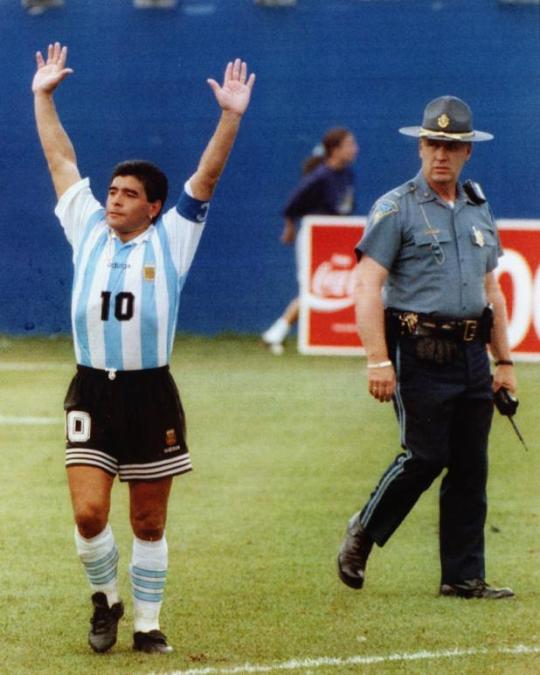
At half-time during Argentina’s 2nd match, a 2-1 win over Nigeria, Maradona was one of two players on each side drawn for a random drugs test. At full time Maradona left the field hand in hand with a nurse, riding a wave of positive emotion after back to back World Cup wins. He was about to come crashing down.
Maradona tested positive. An over the counter, weight reducing drug containing a FIFA banned performance enhancing supplement provided to him by Daniel Cerini was responsible. The relationship and lack of trust between Cerini and Argentina team doctors was so bad that neither was kept up to date with what the other was giving to him, so Argentina were left unaware of the drugs Maradona was taking. Though given the controversy surrounding Cerini they could’ve taken a guess, but noone would dare challenge a Maradona man, all that mattered to anyone was that he was on the pitch. Well after this he wouldn’t be as he received his 2nd 15-month ban in 4 years.
FIFA found Diego not guilty of consciously taking performance enhancing drugs, and believed he was unaware of its components. But regardless he was hit with a ban for breaching Fifa doping regulations. Here Maradona’s history as a drug user went against him. At the Mexico 86 World Cup a Spain player was found to have PED’s in their system, but he escaped punishment with only his doctor being banned. There was no such luck for Maradona who never wore the shirt of his beloved Argentina again. Argentina’s World Cup too effectively ended there as without their talisman they lost to Bulgaria and Romania who knocked them out.
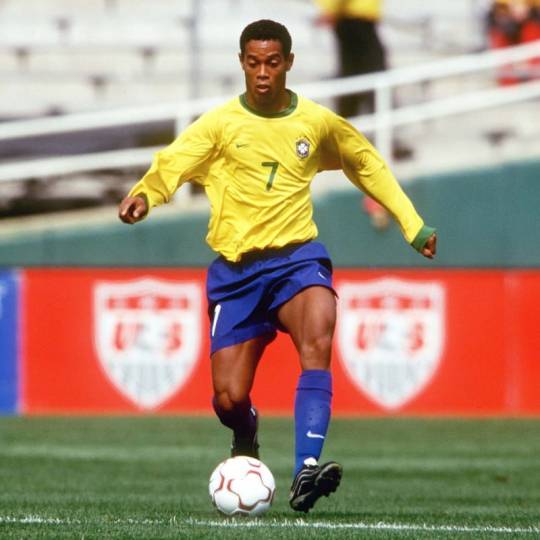
Like Maradona, Ronaldinho also garnered some attention for his performances in a FIFA World Youth Championships, the U’17s version which took place in Egypt in 1997 with Brazil romping to the title scoring 21 goals for the loss of just 2.
1999 was a very busy year for Ronaldinho on the international scene, first he appeared in the U’20 World Championships, before receiving his first cap for the senior team in a 3-0 win against Latvia. Ronaldinho was 19 at the time and in just his 2nd season as a pro, this became even more impressive when he was selected for the 1999 Copa America and scored his first goal for the Selecao at the tournament. It was the other 2 R’s: Ronaldo and Rivaldo who were the stars of the show though, as they helped themselves to 5 goals apiece, as Brazil won the trophy. It was the following week at the Confederations Cup where the teenager truly broke out on the International scene, as he scored in every game bar the final, winning the award for best player and top scorer with 6, including a semi-final hattrick against Saudi Arabia. Brazil went down 4-3 in the final though to hosts Mexico.
The following year Ronaldinho was part of the U’23 squad that competed at the Summer Olympics in Sydney. He was in fine form heading into the tournament, scoring 9 goals in 7 pre-tournament games but the Olympics itself was a disappointment with Brazil exiting at the Quarter-Final stage.
At the 2002 Japan/Korea World Cup Ronaldinho scored 2 and assisted 3 as his country won their 5th title. The victory held many parallels with Maradona’s triumph with Argentina in 1986. Like then, Brazil became champions 8 years after their previous win. And like Maradona, Ronaldinho met and beat England 2-1 in the Quarter-Finals. With England leading 1-0 and the first half drawing to a close Ronaldinho received the ball just inside his own half and took off dribbling, running straight at the heart of the English defence. After beating Ashley Cole with a stepover and a turn of acceleration he kept his cool to slip a perfectly weighted pass to Rivaldo who didn’t disappoint.
Just as Maradona did in the ‘Hand of God’ game, Ronaldinho made his 2nd key contribution to the final outcome just a few game minutes after his 1st. 5 minutes into the second half, Ronaldinho stood over a free kick 40 yards out. With keeper David Seaman off his line anticipating a ball into the box, the ball instead flew over his head and landed just under the crossbar and inside the post. The goal was considered a freak, a stroke of good luck for Ronaldinho with him mishitting an attempted cross. And many people still hold that opinion to do this day, but I do not. The ball is so far away from any Brazilian player, I can’t see how a player as talented as Ronaldinho could misdirect a ball so bad as to completely miss out everyone on his team. Seaman was stood in a bad position, too far off his line for a keeper of short stature and Ronaldinho saw an opportunity to go for goal and executed it perfectly. This goal being dismissed as an accident I think is of great disservice to the Brazilian. But regardless just like the Hand of God goal Maradona scored, Ronaldinho also caused an England keeper to feel great embarrassment.
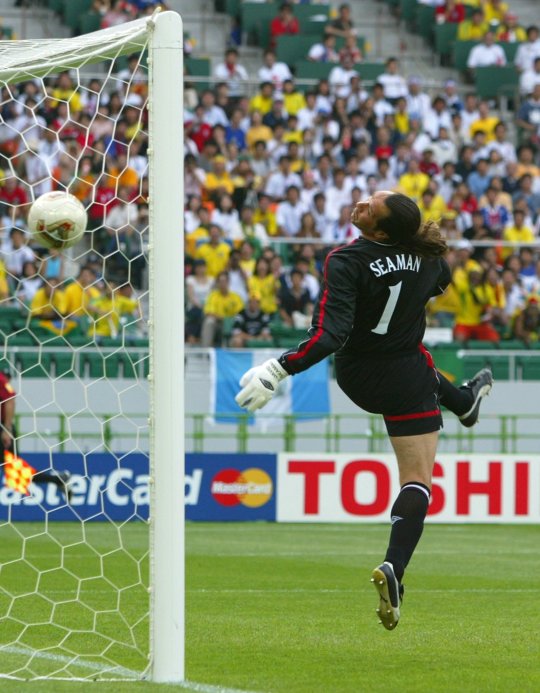
A red card shown to Ronaldinho prevented it from being a perfect afternoon for him as it forced him to miss the Semi-Final. Both Maradona and Ronaldinho’s sole World Cup victories also featured a 2-0 win over Belgium and victory in the final against Germany.
Ronaldinho’s next tournament was the 2005 Confederations Cup which he also won, receiving man of the match for his performance in a 4-1 final win against Argentina in which he also scored. Hopes were high heading into the 2006 World Cup that Brazil could retain the trophy. But the 3 R’s of Rivaldo, Ronaldinho and Ronaldo which worked to devastating effect in Japan and Korea, was replaced by a top heavy attack of Kaka, Ronaldinho, Adriano and Ronaldo. All these stars together didn’t gel as Ronaldinho turned out the worst performances of his stellar international career and Brazil were eliminated in the Quarter-Finals.
Two years later at the Beijing Olympics Ronaldinho was selected as one of Brazil’s overage players as they took the Bronze medal, but he was cut from a Dunga’s initial 30-man squad for the 2010 World Cup, where Brazil were unable to improve upon a Quarter-Final exit. Ronaldinho was captain for a 2013 friendly against Chile, but was not called up for the Confederations Cup that year that Brazil won or the 2014 World Cup they hosted.
Maradona won 91 caps for his national side scoring 34 goals and Ronaldinho won 97 caps, including atleast one a year for 14 years and scored 33 goals. Both men scored 7 in their most prolific years for their country.
Reaching the End
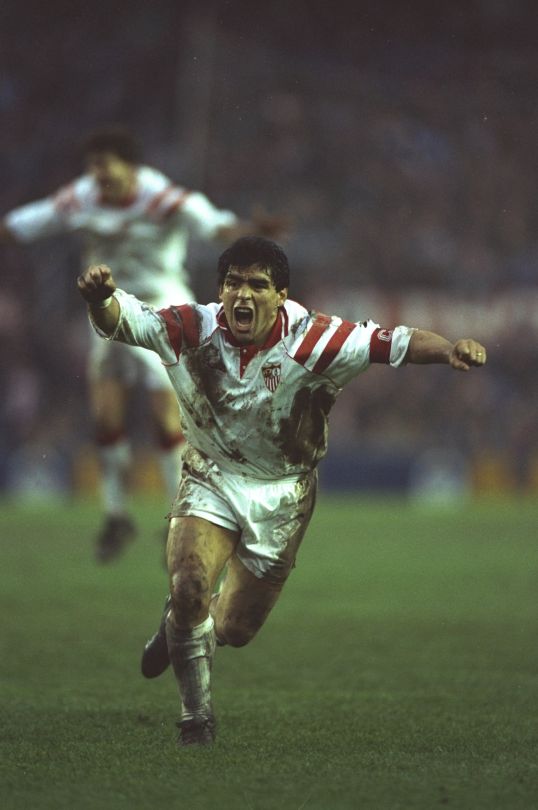
After serving his first 15-month ban Maradona joined his former Argentina manager Carlos Bilardo at Sevilla. Overweight and undisciplined Maradona rarely performs and doesn’t endear himself any further to his employers by spending many nights in a local brothel with his teammates. His lack of fitness and absence from training leads Bilardo to feel unable to trust him to finish a game and he substitutes him. Maradona calls him a “son of a bitch” as he leaves the field. In the dressing room, the two come to blows with Diego later saying “we punched the shit out of each other.” The game would be his last in a Sevilla shirt.
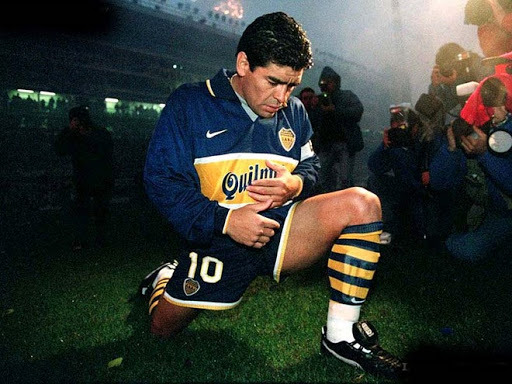
Maradona is then offered a reprieve at Newell’s Old Boys but seems unable to motivate himself. The energy boosting drugs he’s taking at the time mean that after an initial burst of energy he fades badly in games. His stay is shortlived.
Whilst serving a second drugs ban, Maradona tries his hand at management with Deportivo Mandiyu, but they are relegated in a match where Diego is seen on camera calling the referee “a thief, a liar and a gutless coward without balls.” When the ban is over Maradona returns for a second spell with his beloved Boca Juniors where the curtain comes down on his career on his 37th birthday after 31 games spread across 3 seasons.
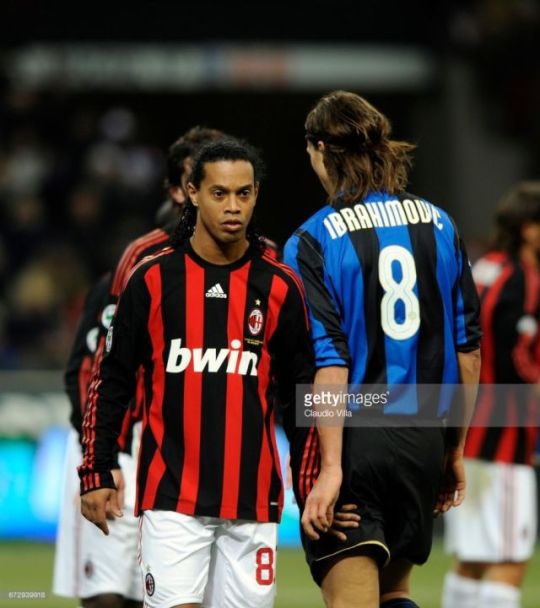
Ronaldinho scored his 1st goal for Milan in a 1-0 derby win over Internazionale. However after a good start, he struggled with fitness and often started games from the bench. A lack of dedication in training and late night partying led departing manager Carlo Ancelotti to declare “The decline of Ronaldinho hasn't surprised me. His physical condition has always been very precarious. His talent though has never been in question."
Ronaldinho did much better in his 2nd season under Leonardo, a fellow Brazilian who was more lenient towards his nighttime activities. Ronaldinho scored 12 and assisted 14, more than anyone else in that season’s Serie A. Likely Milan’s best player that season, he scored 2 braces against Juventus, home and away, and a hattrick against Sienna. However the following season, the arrivals of Robinho and Zlatan Ibrahimovic, plus the stricter coach Massimiliano Allegri saw Ronaldinho’s time in Milan come to an end. Referring to a night Ronaldinho was spotted out in the early hours a couple of days before a Milan Derby, Allegri said in a press conference that “it was not an hour for an athlete to be awake.” That quote applied to many nights during Ronaldinho’s stay in Italy, one night at a Music festival he was implored by Milan fans to go home in order to be ready for training tomorrow, the Brazilian just laughed and told them not to worry. He was determined to enjoy himself and didn’t care who saw him.
This would change when he returned home to Brazil and joined Flamengo, with the club setting up a telephone hotline if they spotted the new club captain enjoying a night out, such were there frequency. 20,000 Flamengo supporters were present for Ronaldinho’s unveiling and although there was some good moments such as when he hit a hattrick during a 5-4 win against Santos in a game they’d trailed 3-0 in, he in the end cancelled his contract and sued Flamengo over lack of payment.
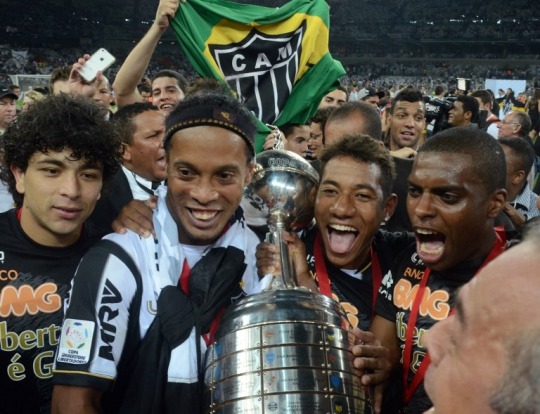
Ronaldinho then joined Atletico Mineiro and won the Bola de Ouro (league’s best player) award in his 1st season. In his 2nd season he won the Copa Libertadores, the first in Mineiro’s history, with Ronaldinho contributing 4 goals and 7 assists to the success. Mineiro lost the first leg of both the semi and the final 2-0 but won both ties on penalties. Ronaldinho was awarded the 2013 South American Footballer of the Year. At the FIFA World Club Cup, following a semi-final match Ronaldinho was mobbed by the players of Raja Casablanca, as they stripped him for souvenirs as a memento from sharing a pitch with their idol.
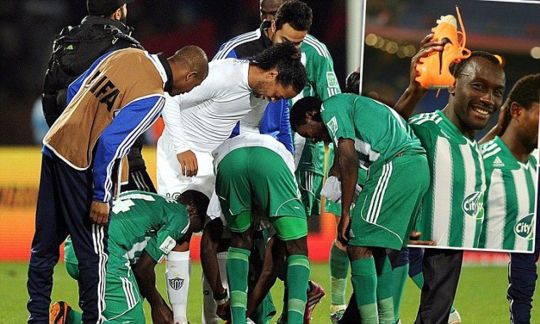
Ronaldinho then moved to Mexico side Queretaro where the highlight came in an away fixture to Club America where he scored twice in a 4-0 win and received a standing ovation from the home fans. Things were not as positive at his next and final club Fluimenese, where he appeared just 9 times before deciding to quit the club, no longer happy with his level. Maradona scored 311 goals in 589 games in club football and Ronaldinho 266 in 699. Both players will be fondly remembered by everyone who saw them on a football pitch, for their contribution to the beautiful game.
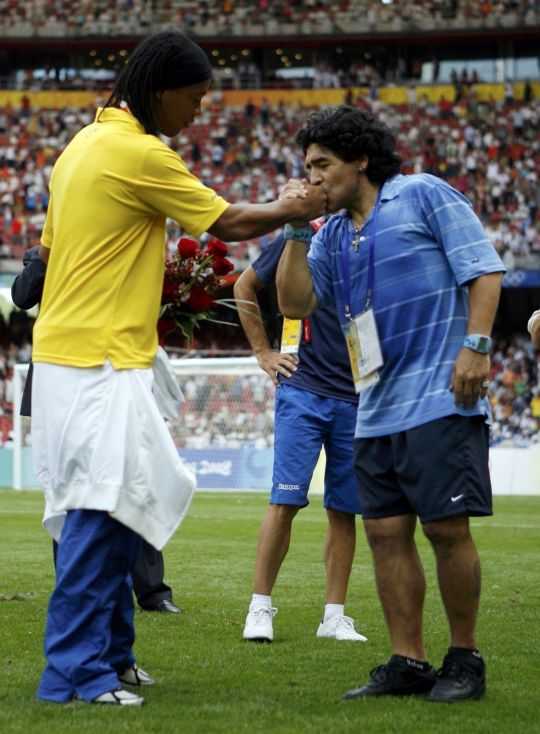
Sources: Hand of God The Life of Diego Maradona by Jimmy Burns, The making of Ronaldinho- how the Brazilian superstar broke through at PSG (FourFourTwo Magazine), Remembering Ronaldinho’s excessive Milan Nights (Bleacher Report)
0 notes
Audio
Liz Mandville Greeson - “Look at Me Look at Me” Every Woman’s Blues: The Best of the New Generation Song released in 1996. Compilation released in 1998. Electric Blues / Blues
Liz Mandeville is simply a queen of contemporary Chicago blues. As a dynamic triple threat–that is a guitarist, singer, and songwriter (and sometimes even a washboard player, too)–she's been able to sustain a successful career for over a quarter century now. And that's quite a challenge for someone in a genre that flourished decades ago and has since become niche, but Mandeville's talents and her hustle (she runs a label, has a radio show, and also writes a blues column) have earned her heaping plaudits from critics and fans alike. She's appeared numerous times in various blues charts, she's sold plenty of CDs, she's played shows all around the world, she's won a bunch of awards, and she's a member of the Chicago Blues Hall of Fame. Oh yeah, and she's a petite white lady with red hair and lots of panache.
Here's some early bio from the website of the label that released her first four albums, Earwig Music:
Liz Mandeville spent the late 1980s running up and down the roads of the United States and Canada with her R&B band, the Supernaturals. She played thousands of gigs, from smoky biker bars to swanky theatres, from casinos to yacht clubs, honing her musical chops and crowd-pleasing skills. In 1994, a chance meeting with bassist Aron Burton led to Liz' subsequent performance with him at the 1994 Chicago Blues Festival, recording two tracks on his 1996 Earwig release, Aron Burton Live, and a long-standing performing relationship. Her work on that album marked Liz's label recording debut and the beginning of her professional association with Earwig Music Company.
A few months after making her debut on that live Aron Burton CD, and while being diva in residence at a Chicago club with a weekly set since 1994, Mandeville released her debut album, Look At Me, which was well-received and ended up on Bill Wax of Sirius Radio's list of the top ten releases of the year. Featured on that album, naturally, is its title track, which actually states the album's name twice.
Before diving into this fun, upbeat piece of tongue-in-cheekery though, let me pull an interesting quote about an important memory from Mandeville's childhood from a 2013 interview she did for Chicago Blues Guide:
I remember one time my mom was getting her hair done at Marshall Fields and they had a toy department outside the beauty salon. I was waiting for my mother, she'd told me, "Play with the toys and don't get in trouble!"
They had this little four octave piano there so I sat down and started playing songs and singing all by ear. I actually drew a crowd and people were clapping, but when my mother came out of the salon she was not at all happy.
She gave me a whipping like I'd never had. I guess I wasn't supposed to draw attention to myself, it was a week before I could sit down!
So, years later, we find Mandeville with a song called "Look at Me Look at Me," which is something a kid shouts when they're both craving some attention and want to impress an adult. And that's effectively what Mandeville was doing in that Marshall Fields all those years ago and it's also what she's doing on this opening track from her debut album. A painful whipping certainly wasn't going to curb her deep desire to please others by way of performing music. In fact, it might've caused the opposite of what Mandeville's mother had intended all along, and in a weird way, we might all be better off for it (I am in no way endorsing hitting kids for any reason though, and certainly not as a harebrained means of helping the kid become successful through some kind of attempt at reverse psychology or anything along those lines. I feel like I shouldn't have to say this, but then again, I feel like I do. Tens of millions of people believe in Qanon, after all).
But there's also another interpretation to glean from this song. Quite noticeably, Mandeville, while playfully commanding your attention, only does so by mentioning her own looks and not her music. This could be taken as an ironic bit of commentary on the sexualization of women in music, in which female artists (and to be fair, men too, but definitely not to the same extent) are often commodified based primarily on their appearance and then secondarily on their musical talent. Here we see Mandeville crudely giving the game away and delivering a nice little poke in the eye to the music industry for their continued gross treatment of female artists by prioritizing sex appeal over artistry.
But that's not to say sex can't sell. It can and there's not a single thing wrong with that. Blues tunes can get very sexual and there's certainly sexuality in Mandeville's songs. But if sex appeal happens to be the main thing that's moving the units (oh man, pun so not originally intended), then there's something definitely off there. It's keeping other musically talented women out of the spotlight.
And Mandeville's clearly not just sex appeal. She's an amazing blueswoman and a sweet, lyrically layered ditty like this more than proves it. Just listen to those deep, sultry vocals thicken and thin and momentarily turn gravelly, too. Dig how they pair with Michael Dotson's leading electric guitar scratch. Take in that nicely crafted instrumental bridge that's made all the better when Allen Batts barges in midway on piano.
A great initial offering from this now-legendary woman of Chicago blues.
#blues#the blues#blues music#electric blues#chicago blues#music#90s#90s music#90's#90's music#90s blues#90's blues#90s electric blues#90's electric blues#90s chicago blues#90's chicago blues
0 notes
Text
★ 11 Years Of Wanted EXCLUSIVE: “Shah Rukh Khan was not offered Wanted. Salman was the ONE and ONLY choice”.-Boney Kapoor!
Sep 18, 2020

The experience of watching a commercial, masala film in cinemas today is incomplete if audiences are not reacting with claps and whistles. This practice, once exclusive to single screens, has also crept into swanky multiplexes. And this trend’s new avatar was born thanks to a film released exactly 11 years ago, named Wanted. It starred Salman Khan and Ayesha Takia in leading roles and were supported by Vinod Khanna, Mahesh Manjrekar, Prakash Raj, Manoj Pahwa, Mehek Chahal, Inder Kumar and Aseem Merchant. It was the official remake of the Telugu flick Pokiri (2006). Prabhudheva first made its remake in Tamil and then also helmed the Hindi version. The film was about a cop who goes undercover as a ruthless gangster and finishes off two notorious gangs and their masters in Mumbai.
Wanted was a huge hit. It revived the career of Salman Khan and brought him back to the big league. Till today, he’s following the ‘Wanted’ formula of making mass-friendly, action entertainers (and with him doing away with his shirt in the final fight). And audiences are not complaining. Even for the industry, Wanted was godsend. It was released at a time when the industry was reeling due to recession, aftermath of the multiplex-producers strike and back-to-back flops. It made the Bollywood fraternity realize the importance of kind of cinema and how audiences are ready to lap it up. Thus began the era of new-age masala flicks and it thrives even today.
On this joyous occasion, Bollywood Hungama spoke to its producer Boney Kapoor, who made Wanted as a joint venture with Sahara One Motion Pictures. The veteran filmmaker shared some exciting trivia about the film’s making, casting, reception and a lot more, which is sure to surprise and thrill the movie buff in you!
1. A trivia on the popular website IMDb states that Shah Rukh Khan was the original choice and that he refused, citing that no one can play this role better than Mahesh Babu, the lead actor in the original film.
Boney Kapoor however rubbishes this rumour, “Shah Rukh Khan was not offered Wanted. Salman was the one and only choice. I remember he was shooting for Partner (2007) and I had asked him to see the original film made in Telugu. He had cancelled the plan twice. Meanwhile, the Tamil film was to release and then it would have further led to a scramble for rights. Hence, I insisted Salman that he come and watch. He agreed. Post the shoot, he saw the film at midnight at Dimple Theatre. He loved it and did thumbs up to me and walked towards his car.”
2. It is now known that Ileana D'Cruz, the actress opposite Mahesh Babu in Pokiri, refused Wanted as she had her exams coming up then. Boney Kapoor says, “Yes, Ileana was in close contention. We also thought of Genelia Deshmukh. There were also two top actresses who were interested but I had to politely say no to them since I wanted an actress who had never worked with Salman before. This is because of this crucial scene in the second half after Salman fights the goons in the train. This is where the girl says, ‘I don’t know if you are a good or a bad person, but the fact is that I love you.’ We needed someone who was in awe of Salman and hence, looked for a new face.”
3. Prakash Raj, a familiar face in Bollywood today, was reintroduced in Bollywood with Wanted. Boney, at this, reveals, “Prakash Raj was on standby as we were trying to cast an actor from Mumbai. However, we couldn’t find one. Also, he was a part of the original film and thus it made sense to cast him. Incidentally, his first film in Hindi was also with us – Shakti - The Power (2002).
4. Wanted took over two years to be made and released. “We shot the film for around 200 days and Salman shot for nearly 168 days. We started the shoot somewhere in August 2007,” said the producer.
5. Wanted songs, by Sajid-Wajid, are a hit even today and one of the songs that were widely promoted was 'Love Me Love Me'. However, the version we saw in the film was shot later. Boney Kapoor tells, “We shot 'Love Me Love Me' in Bangkok but then we decided to reshoot it. We filmed it in Surve Farms near Mumbai.” Even 'Le Le Maza Le'was shot in the same location.
6. All the songs of the film were shot in a grand fashion and Boney Kapoor left no unturned to make them look visually stunning. He tells, “We spent Rs. 1 crore on the Salman Khan song, 'Most Wanted Track'.”
7. Wanted began on a chilling note showing the villain Ghani Bhai (Prakash Raj) as a ruthless gangster enjoying a wrestling match and killing off his gang member, when he learns that he was deceiving him. Boney shares a great trivia, “The intro scene of Prakash Raj was shot much later, in Thailand. This is because we realized we needed a powerful scene to introduce his character as Hindi cinema audiences were not aware of him.”
8. There was another addition in the Hindi version, “The scene where Prakash Raj’s character realizes he’s in a ship in the middle of nowhere was not there in the original. Initially, we wanted to shoot it on a dysfunctional oil rig and we tried to do so in India. But due to security reasons, we were not allowed. We then tried in other countries but it couldn’t happen. Finally, we shot it in a shop near Bangkok, Thailand.”
9. The film’s title also underwent a change. Says Boney Kapoor, “Earlier, the title was Wanted - Dead And Alive. It was unusual because the popular term is 'Wanted - Dead Or Alive'. But we were keen on this particular title as the gangsters wanted Radhe dead while the cops wanted him alive. Once you see the film, you realize why that is so. However, then we decided to settle for just Wanted. This title was with Gaffar Bhai Nadiadwala and he was kind enough to give it to us”. This explains why the Hera Pheri(2000) producer has been thanked in the end credits.
10. Wanted began the trend of having Eid releases for Salman Khan. Barring 2013 and 2020 (the latter due to the lockdown), Salman has had a release on this festival every year from 2009 to 2019. What’s not known is that Wanted was to arrive in April 2009. The multiplex strike pushed it ahead, just like most films. Then, Wanted was to hit screens on July 3 and it was also to clash with Dulha Mil Gaya (2010), which featured Shah Rukh Khan in a supporting role. Then it was moved to August 7. Later it got a release on September 18, 2 days before Ramzan Eid. Boney Kapoor however adds to this trivia, “We tried to bring the film on Diwali 2008. But Salman’s Yuvvraaj (2008) and Heroes (2008) was to be released then and hence, we pushed it to April 2009. This is when the multiplex strike was going on and this led to further delay. Eventually we settled for Eid.”
11. One of the most heart-breaking developments was the Central Board of Film Certification (CBFC) awarding it with an ‘A’ certificate. Several industry insiders, trade and even audiences were left shocked since the film had violence but it was not too gory either. There were fears that it might restrict the film’s appeal. Even Salman in many interviews expressed his disagreement with Wanted’s ‘A’ rating. Boney explains, “Censors had become strict because of some mishap then. The original Telugu version had got ‘A’. But the Tamil one was awarded ‘U/A’ and we expected the same for Wanted as well. Had Wanted got a U/A, it would have done 25-40% more business. Less than a year ago, Censors had given Ghajini (2008) a U/A certificate as well”. Ghajini, starring Aamir Khan, was also a remake and had excessive violence, just like Wanted.
12. The audiences enjoyed not just the performances, music, action and humour but also the film’s dialogues, written wittily by Shiraz Ahmed. 'Ek baar jo maine commitment kar di, toh main apne aap ki bhi nahi sunta' is one of Salman’s most popular dialogues of his career. Boney Kapoor tells, “The one-liners of Wanted started a trend and were redone in various other films. Such one-liners have always been a hallmark of my films whether it’s 'Mogambo Khush Hua' from Mr India (1987) or 'Be Positive' from No Entry (2005).”
13. Once Wanted was out, reports soon started pouring of how viewers have gone berserk. The management of Mumbai’s Ankur cinema had to paint a ‘Housefull’ board because they didn’t have one. Theatres in South Mumbai like Liberty and New Empire had to meanwhile dig out the ‘Housefull’ board from their storage rooms as they had not used those for a long time! In Paras cinema in Jaipur, the cops had to request the theatre management to sell 200 tickets less to keep the audience in control. In the biggest theatre in Hubli, Karnataka, almost 5,000 people gathered outside to buy tickets. Manoj Desai, executive director of G7 Multiplex in Mumbai, popularly called as Gaiety-Galaxy cinema complex, had summed up the madness in one sentence, “Wanted has got the film industry and also the single screen cinemas out of the ICU.” Gaiety-Galaxy is like a barometer for the industry and the response there made it clear for Boney Kapoor that Wanted is a hit. “The response in Gaiety Galaxy was unbelievable,” he says.
14. Wanted, surprisingly, did very well even in multiplexes. Boney Kapoor agrees and adds, “Wanted was critically rated very well too. Even The Times Of India gave 4 stars!”
15. Wanted added another feather in its cap, as shared by Boney, “The trend of repeat runs was very common at one point but had died down in the new millennium. However, Wanted was an exception. Even after a year, it used to be played in many centres. It used to not do huge business but nevertheless, it used to get decent footfalls.”
16. Salman Khan’s career got a new lease of life after Wanted. His fan following was already huge but it got bigger after this flick. Boney Kapoor states, “Post the release, the Wanted team including me and Salman went to Kolkata for a football match. However, Salman couldn’t enter the ground. Such was the craze.”
A lot of films’ anniversaries are celebrated nowadays and many of these at times seem unnecessary. However, Wanted deserves to be feted as it was the first step in making our industry bigger and better. Today, most of the films in the Rs. 200 and Rs. 300 crore club belong to the action masala genre. Hence, Wanted is responsible for opening the eyes of the producers that such films are not dead, as believed then by many, and that they’ll always have an audience. Boney Kapoor signs off by saying, “Wanted epitomizes that real Hindi cinema, if made well and with ample amount of masala, can never fail.”
0 notes
Text
Jenny Lewis is following the magic
The Line of Best Fit March 20, 2019
Major life upheavals led to Jenny Lewis’ first solo album in five years but Josh Slater-Williams finds her embracing the stranger things the universe throws at her
Words by Josh Slater-Williams

“People always want to know what, why, how, when. I don't know. Which? Who? Whom! Whomst!”
Jenny Lewis has told me she doesn’t have a problem talking about new record, On the Line but there’s a certain reticence to divulging much about intent or any unifying connection between the thumping, lush ballads she’s assembled. It sounds like even she won’t know what the songs are about for a while.
“I don't even really consciously write songs,” Lewis says of whether the meaning of her music is clear by the time it’s recorded and released into the world. “I believe in the magic in a way, so I'm not sure how they begin. I'm not even sure how I finish them, but I tend to understand them years later. I don't understand this new album yet because I haven't toured it. Of course, you have an intuitive sense, but I can't really tell you exactly what it's about.”
Under the Blacklight - the final record she made as part of Rilo Kiley - is perhaps the one case of knowing what an album was about before taking it on tour. “Under the Blacklight is a concept album in a lot of ways,” she says. “That was really the first time that I wrote from a character perspective or I leaned on that a little bit. But again, I'm not sure where this stuff's coming from.”
Lewis’ relationship to her former band’s music has changed over the years, from ignoring it almost entirely at shows - bar maybe one song in an encore - to seemingly embracing it with gusto. I’ve seen her in concert on three occasions since Rilo Kiley toured for the last time in 2008, and the last of those shows, at The Art School in Glasgow in 2014 in support of The Voyager, saw Rilo Kiley tracks comprise roughly a quarter of the setlist.
“For years, I didn't really dig into the back catalogue,” Lewis says. “The first time I played a Rilo Kiley song without Rilo Kiley was when I was sitting in with Conor Oberst and the Mystic Valley Band and he asked if I would play ‘Portions for Foxes’; Conor's always this incredible guide in a way. I hadn't really gone there before, but once I opened that door, it just opened the floodgates to the past. So now, I can go back and choose songs and some of them feel good. Some of them feel inappropriate. Or not inappropriate, more just really youthful in a way that doesn't suit me now. But it's surprising, which songs feel relevant. We’ve been doing a version of “Portions for Foxes”, a slowed down version that I've renamed “Bad News”. And that's been feeling really good.”
In a 2016 interview Lewis discussed her tendency to compartmentalise eras of her career describing herself as “not really one for nostalgia”; something of an ironic statement in light of the fact she was speaking in support of a tenth anniversary tour of solo debut Rabbit Fur Coat. A few years prior, she also participated in an anniversary tour for The Postal Service’s Give Up, having provided backup vocals for that platinum-selling collaboration between Ben Gibbard and Jimmy Tamborello that was a poster child for early aughts American indie music. This year marks the 20th anniversary of the first Rilo Kiley EP, an initially self-titled release later re-pressed as The Initial Friend EP.
I wonder if this inspires any particularly strong feelings for her? Apparently not. “It’s interesting to acknowledge the past,” she says. “And all the songs fit into the puzzle,” that puzzle presumably being the overarching story of Jenny Lewis. “But that was then, this is now. Can’t go back.”
When Lewis does acknowledge her past work in her music or the surrounding visual material, it tends to be focused on her acting career - which lasted from her early childhood to roughly around when Rilo Kiley started recording. Bar the odd cameo – including a spot in Sofia Coppola and Bill Murray’s Netflix special, A Very Murray Christmas – Lewis’ acting credits are mostly relegated to the ‘80s and ‘90s. She paid homage to some of her more recognisable family film credits and TV guest spots in a self-directed video for The Voyager’s “She Not Me”, wherein various celebrity pals were brought on board to re-enact moments from much-loved US sitcom The Golden Girls and cult comedy Troop Beverly Hills.
Saturday Night Live-alum Vanessa Bayer was one of those celeb friends, and reappeared for a livestream listening party of On The Line that also featured the likes of St. Vincent, Jeff Goldblum, Jason Schwartzman, Beck, Danielle Haim and comedian Tim Heidecker. The three-hour “telethon” of music, comedy and interviews raised funds for the LA Downtown Women’s Center and Lewis describes the event as “kind of a disaster in the best way.” It opened with a rendition of “The Frug” from the first Rilo Kiley EP, somewhat contradicting her reticence to return to the earliest Rilo Kiley material - although the song was admittedly performed by a barbershop quartet rather than by Lewis herself. “That was the director's idea,” she clarifies, “because that song is nowhere… it's just not in my consciousness right now. But it was really fun to open the show with that. Even though the refrain is, ‘I cannot fall in love / I cannot fall in love / I cannot fall in love’, which is a weird way to start off a live stream.”
"Sharing about addiction and mental health can hopefully provide a little insight or comfort for others going through it. And it's not taboo. It's okay to talk about it and it's not the whole story. It's part of the story."
“But I can fall in love,” she assures me with timid delivery, but a wry smile. “I hadn’t then [at the time of the EP], but it’s happened since, if anyone’s wondering.” I tell her I’ve gathered the likelihood of that from the multitude of songs since that have suggested as much. I would also assume her 12-year relationship with fellow singer/songwriter Johnathan Rice may have involved some degree of love; the two reportedly mutually parted ways after the release of The Voyager.
“I’m not in love currently, but I have been in love. Once… twice. Maybe twice.”
Lewis breaks into laughter here, which happens quite a few times in a conversation that proves surprisingly prone to detours into bizarre comedy tangents. Perhaps it’s a welcome change from some of the other interviews she’s already done as part of this album’s promotion cycle. A few days before we speak, Rolling Stone publish an interview where Lewis talks openly about her troubled childhood and late mother’s history of addiction that she’s never really spoken of in public before, and a recent Mojo interview is also candid in this area too. There have been many lyrical allusions in the past, but these interviews certainly clarify the distinction between memoir and fiction in some of her songs.
Her mother’s passing in 2017 played a big part in Lewis feeling open to speak about that backstory definitively. “I now have mixed feelings about sharing that honestly,” she tells me, “even though I've spilled the beans, you can't put the worms back in the can. I guess I waited to exploit her from beyond the grave, so I would imagine someone will do the same to me.”
“I'm understanding why I feel compelled to share that,” she says. “And I think that it's part of the healing process. Not that it's anyone's business but my own and my family's business. But for me, sharing about addiction and mental health can hopefully provide a little insight or comfort for others going through it. And it's not taboo. It's okay to talk about it and it's not the whole story. It's part of the story.”
The world won’t know the full story and we don’t have the right to it, I say. “But you have a right to whatever I share,” she points out. “And then it's part of the consciousness. I guess I don't want to hurt people even if they're gone. But it is my story and it is a big part of why I’m a writer.”
If Lewis herself won’t necessarily know what the new album is ‘about’ for some time, insobriety, addiction and self-medication stick out as recurring topics throughout her lyrics for On the Line. Various combinations of drink and drugs are called out by name, not least on “Red Bull & Hennessy”, while the refrain of “Little White Dove” plays with the homophone of ‘heroine’ and ‘heroin’.

Topics of sexuality have always been a thread through Lewis’ music, even dating back to the earliest days of Rilo Kiley, but with On the Line they seem particularly pronounced; often intertwining with nods to addiction and self-medication. Album opener “Heads Gonna Roll” starts with wondering “Why you stopped getting high” and closes with the suggestion that “A little bit of hooking up is good for the soul.”
“I guess it's all the same thing if you're using it in that way,” Lewis says when I ask if sex falls under the banner of self-medication in the lyrics. “But I don't necessarily think it's an unhealthy relationship with sex that I'm talking about on this album. I think it’s just an ability to articulate and use it to punctuate a moment. Like at the end of the song “Dogwood”, I didn't know what the lyric was going to be. And I was in the studio, just trying out a couple of options and then I landed on, “There's nothing we can do but screw.” That seems like a good way to end a song.”
“No subject is off limits,” Lewis continues. “Sex has always been a theme in my music.” She pauses. “And let’s hope it will always be a theme in my music! Fingers crossed.”
“Dogwood” is her favourite song on the album by a landslide: “That’s my most proud vocal performance,” she tells me. I’m personally drawn to “Taffy”, a ballad with a noticeably different rhythm to the rest of On the Line. It also happens to feature one of the album’s more attention-raising lyrics: “Nudie pics / I do not regret it / I knew that you were gone / I did so freely / I wanted you to see me off that throne you put me on.”
“Taffy was a poem that I wrote on the back of a barf bag on an airplane,” Lewis tells me, then reassuring me that the bag was unused, fresh and clean. “That was words first and then I sat down at the piano and figured out how to fit them into the puzzle. You can tell it’s a poem. That one almost didn't end up on the record. I sent it to a friend of mine who I consult with every time I make a record, as far as order goes, and there was some discussion of cutting one of the ballads. But then I thought, well, this is a record of mostly ballads. Why cut one now, we've already gone down that path. Again, you can't put the worms back in the can.”
“Beck is such a meticulous listener and producer. There's no stone left unturned...down to the last step in mastering. I'm not alone and he's thought of everything.”
Another major consultant for On the Line was Beck, who previously collaborated with Lewis on The Voyager highlight “Just One of the Guys”. He produced and played on multiple tracks on the new album. Lewis tells me she feels an affinity with him as someone who also plays with genre and personas between records. “We both grew up in Los Angeles and we remember a different kind of LA and share a lot of the same tastes in music. And I have just been a fan of his for so long; aesthetically, especially. I made demos on my GarageBand on my phone and sent them to him and he was immediately like, okay, we can do this. I am so happy with the way “Just One of the Guys” turned out and when I play it live, his arrangement really holds up. It's so thoughtful.
“He's such a meticulous listener and producer. There's no stone left unturned. I don't have to worry. Whereas with some of my other collaborators, I have to finish the heavy lifting. Or where I question: 'Is this finished?' No, it's not finished yet. I have to get it done on my own. But with Beck, down to the last step in mastering. I'm not alone and he's thought of everything.”
We don’t mention him by name but the “heavy lifting” undoubtably alludes to Ryan Adams, who reportedly left before finishing his production work on both The Voyager and On the Line. Following the recent allegations of sexual misconduct against Adams, Lewis tweeted a statement of support for the accusers.

A collaborator Lewis is happy to discuss is Ringo Starr, who plays drums on “Heads Gonna Roll” and “Red Bull & Hennessy”. The Beatles are mentioned in a lyric on album closer “Rabbit Hole”, though Lewis tells me there’s another nod to the band on the track “Party Clown”: “I was a beetle floating in a bottle of red.” Lewis says, “And in my mind, after that, I say to myself, I was Ringo.”
How exactly does one get a former Beatle to play on their record? Lewis still isn’t sure. “Again, magic. May I redirect you to the magic of life and when things are truly serendipitous. It felt like a glitch in the simulation when we were in a room with Ringo. How did I end up here? I'm not exactly sure how it happened, but it happened. Why? Why? It’s crazy. I've met some cool musicians over the years, but that was tippity top.”
If there’s a major running theme to my conversation with Lewis, it’s this idea of happy chances surrounding On the Line, from the collaborators and recording to, as I’ll later find out, the look of the album and, as she’ll later find out, a surprise connection in the promotion of it. Considering a lot of the record’s material appears rooted in her breakup and mother’s passing, that maybe wasn’t applicable to the initial inception of the lyrics. But the strange fortuity even extended to her LA home almost becoming a set for a major movie production while the album was being made.
“There was a knock at my door one day about a year ago,” Lewis tells me, “and it was the location scout for Quentin Tarantino, just randomly on my street. And, he was like, “Hey, do you mind if we come in and take pictures for Quentin? We’re looking for a location for the [Charles] Manson movie.””
Tarantino’s 1969-set Once Upon a Time in Hollywood, starring Margot Robbie as Sharon Tate, alongside Leonardo DiCaprio, Brad Pitt, Al Pacino and the late Luke Perry, is due for release this summer. “I was like, “Come right in, photograph my house!” It didn't work out, which is probably for the better because to have a murder scene in your bedroom is probably not a good idea, but that would have been the coolest thing that ever happened. I'm such a deep movie nerd.”
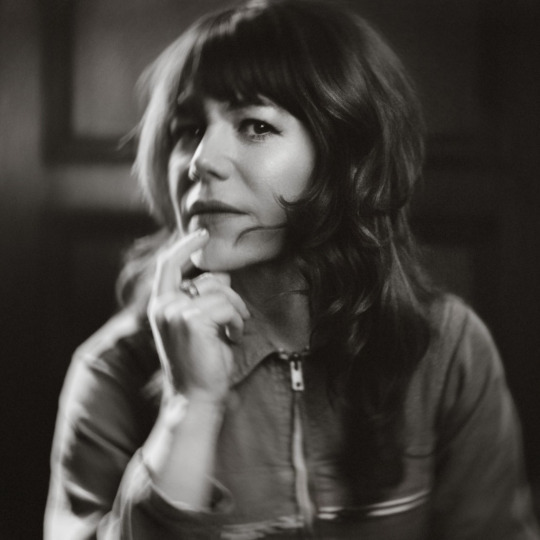
Being an LA native, I wonder if Lewis still gets starstruck at all at this point in her life. “Not by musicians,” she says. “I think if I were to meet Bob Dylan, that would probably be the exception. But maybe not, I don't know. I feel very comfortable among our people. I met Bill Clinton once and I wasn't nervous at all, and I asked, “Is it okay if I take a picture of you?” Because he's a musician.”
As someone 14 years her junior (Lewis is 43), I tell her my only reference for Bill Clinton being a musician is a moment of him playing a saxophone in the opening credits of the ‘90s Warner Bros. cartoon series Animaniacs. “The best show,” she says. “Did you see Daffy Duck on my live special?” Lewis being signed to Warner Bros Records is presumably how someone in a Daffy Duck costume was among the guests in her telethon. “Daffy was such a dick. They’re rebranding Daffy for the millennials, where Daffy’s vaping. And they were trying to pitch me on a sort of a co-branding opportunity for myself and Daffy. He's gonna come out on tour with me, Bez-style. Daffy’s my Bez.”
Remembering that a sequel to the Looney Tunes movie Space Jam has reportedly been greenlit, I express horror that an onscreen vaping Daffy could soon be a real possibility. “Wow,” she says, “Space Jam. What a movie.” This would rank rather high on a list of quotes I wouldn’t have expected to get from this interview.
We spend a minute or so wondering who else among the Looney Tunes would probably vape. “Is Taz too fast to vape? Maybe Porky Pig. No, no, not Porky Pig. He’s a little uptight, Porky Pig. Daffy’s cool because he doesn't know he's the way that he is. And he thinks he's like Bugs Bunny. He thinks he's Bugs. I think Bugs might vape. I could see Bugs vaping. I don't condone vaping, by the way. I don't think you should smoke anything that smells like cotton candy. I wouldn't vape if I were you. I feel like we don't know. We just don't know. There's a giant question mark on vaping, in general.” We conclude that Foghorn Leghorn would vape.
"I have the most incredible friends who are very patient and loving and are always there for a late-night Facetime session if I need them. When you're in a relationship, it's harder to maintain those friendships."
Be it with Daffy Duck or Beck, Ringo Starr, producer Shawn Everett and others, Lewis tells me a love of collaboration is one of the things she’s learned from making On the Line. “I just followed the songs and I pull from the people that I'm hanging around that inevitably become my collaborators because I can't not play music. I have a problem. If you come over to my house, it's just an immediate jam.”
That said, she doesn’t think she needs to rely on people. “I believe now that I can go anywhere with my songs and work with anyone and make something that makes me happy. I tend to get caught in the process of making a record where I want more from someone, or I want more of their time or more of their energy, and I feel like it's them and not me. But really, they're my songs and maybe it's less about who I choose to work with. It's easier to deflect, especially in the room with someone who's an artist in their own right. I can like feeling small and in the background when I'm creating in that way, as there's less pressure, but sometimes you’ve got to just step up and be yourself.”
“Autonomy, that’s been the key thing learned,” she continues. “I've connected with my female friends over the last couple of years and I've made a lot of new female friends, and that has really been one of the best things that's come out of being single in the world and autonomous. I have the most incredible friends who are very patient and loving and are always there for a late-night Facetime session if I need them. And there are three of us who live in Los Angeles, where we are just communicating constantly with each other. When you're in a relationship, it's harder to maintain those friendships.”
To quote one of Lewis’ own lyrics for Rilo Kiley’s “Breakin’ Up”, it feels good to be free.

One of Lewis’ longtime friends is photographer and director Autumn de Wilde, who shoots for all of her solo projects and also shot the material for Rilo Kiley’s Under the Blacklight back in 2007. “Once I finish the music, I send it to her and then we start brainstorming and we come up with a colour palette and a concept. We never really know until we know. Like how the songs find me, I think that visual component also finds me. We prepare to get there, but we never know what the actual cover is going to be.”
This time around, constructing the visual component involved a couple more instances of that serendipity we’ve already talked about. If you were to place the two covers of The Voyager and On the Line next to each other, you’d be forgiven for thinking the latter was an outtake from a shoot for the former. The outfit’s not the same, but the crop of Lewis’ upper frame, with her head missing, is almost identical. But, according to Lewis, this was another happy accident that revealed something about the new record, conceptually: “Autumn just did a quick Polaroid with that crop, testing the light, and it fell to the floor and I saw it and I knew that was the cover. At that point, I realised they're bookends, The Voyager and On the Line.”
The front cover of On the Line features Lewis in an outfit she describes as something that her mother would have worn in the late ‘70s in Las Vegas. For a deluxe edition of the vinyl version of the record, the cover unfolds to a poster-size image of Lewis in the full outfit, head and lower half intact from merging that original Polaroid crop with a full-length outtake. “That [deluxe] cover is a reference to an Isaac Hayes record, Black Moses,” she tells me. “And the outfit that I'm wearing on the back of the record, with me on a horse, is one of Isaac Hayes's stage costumes that my friend gave to me right before the photo shoot. Just randomly. And so, there's this deep Isaac Hayes connection that was unintentional. Again, why? I have no idea why.”
"Instagram has been really the first social media that I've engaged in personally...but I do feel like it's a very dangerous world to be in and the less I engage, the happier I am. It's really fucked up on there. It's bad."
There are many meanings behind the album’s title, she tells me: “I think it will be relevant for people to think about what it means to them. It's such a dumb thing to say ‘relevant.’ I don't know what's relevant to people, but we spend our lives communicating via text and it's really hard to detect tone. I mean there are so many meanings here, but really just waiting around for someone to change or come back and they're not going to do either.
“Taffy” features one of the most overt nods to our relationship with devices, with a snapshot of infidelity glimpsed through looking through someone else’s phone: “I wanted to please you / My dress was see-through / as I looked through your phone / I am such a coward / but how could you send her flowers?"
“Instagram has been really the first social media that I've engaged in personally,” she says. “I started it as an artistic outlet for weird, abstract short films during The Postal Service reunion tour. It really was a personal creative outlet that then became like a social network. And then of course, putting out albums, there's expectation to fold in a promotional aspect. So, I use it mostly for that, the creative thing being first, and then the promotional stuff. It’s hard to navigate without feeling super cheesy, especially when all your friends are looking at everything that you post. But I do feel like it's a very dangerous world to be in and the less I engage, the happier I am. It's really fucked up on there. It's bad.”

In light of the social media discussion, I can’t help but bring up an interaction of sorts that we had via Twitter once before. In the run-up to the release of Star Wars: The Force Awakens in autumn 2015, having just learned of the name of Adam Driver’s antagonist character, I tweeted: ‘Is Jenny Lewis still the frontwoman of Kylo Ren?’
I didn’t tag in Lewis’ Twitter handle for this dumb joke, but a few hours later, I discovered she’d somehow seen it and retweeted it, and my notifications went wild, with fans and famous folk alike chiming in with reactions and replies.
“Oh, that was you?!” she asks without a second’s pause after I simply quote the tweet, before mentioning what happened around it. “I remember that because I've never seen Star Wars. And I thought, who is Kylo Ren?”
I tell her it was a funny experience to suddenly be getting notifications of likes, for either my tweet or the creative fan-art replies, from such accounts as Warner Bros. Records and actor Brie Larson.
“Daffy Duck is on your case now… vaping,” she says of the Warner appreciation. “But isn't it weird that we have that connection and I didn't know that was you until you told me, but I remember it distinctly?” To quote her own earlier musings: may I redirect you to the magic of life. |
#publication: line of best fit#album: on the line#year: 2019#mention: rilo kiley#mention: under the blacklight#song: portions for foxes#song: the frug#song: red bull#song: little white dove#mention: drug addiction#mention: mother#mention: mother's death#song: dogwood#mention: sex#song: taffy#song: party clown#person: beck#person: ringo#mention: the beatles#mention: the voyager#mention: cover art
0 notes